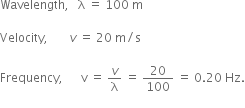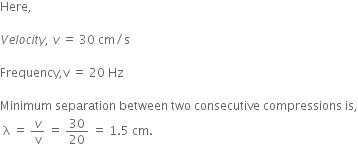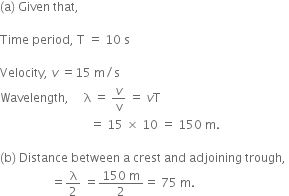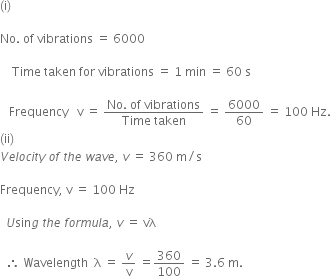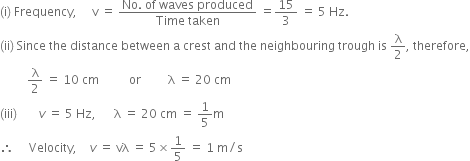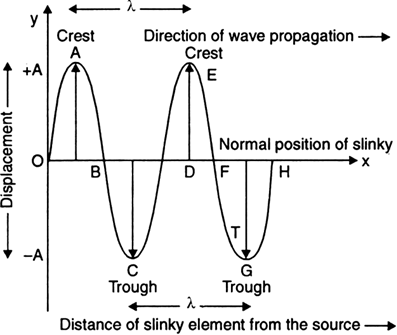Science Chapter 2 Is Matter Around Us Pure
Sponsor Area
NCERT Solution For Class 9 About 2.html
Which separation techniques will you apply for the separation of the following?
Sodium chloride from its solution in water.
Crystallization or evaporation
Which separation techniques will you apply for the separation of the following?
Small pieces of metal in the engine oil of a car.
Centrifugation or sedimentation
Which separation techniques will you apply for the separation of the following?
Butter from curd.
Centrifugation
Which separation techniques will you apply for the separation of the following?
Oil from water.
Separating funnel
Which separation techniques will you apply for the separation of the following?
Iron pins from sand.
Magnetic separation
Write the steps you would use for making tea. Use the words—solution, solvent, solute, dissolve, soluble, insoluble, filtrate and residue.
Step for making tea:
1) Take 100ml of water as solvent in a kettle and boil it.
2) when solvent boil add milk, tea leaves, sugar. these are solute. now again boil the solution for few mintues. sugar is soluble in water thus it will be disslove.
3) colour of tea leaves goes into solution as filtrate. The remaining tea leaves being insoluble remains as residue.
4). filter the solution, enjoy your tea.
Pragya tested the solubility of three different substances at different temperatures and collected the data as given below (results are given in the following table, as grams of substance dissolved in 100 grams of water to form a saturated solution).
|
Substance Dissolved |
Temperature in K |
||||
|
283 |
293 |
313 |
333 |
353 |
|
|
Potassium nitrate |
21 |
32 |
62 |
106 |
107 |
|
Sodium chloride |
36 |
36 |
36 |
37 |
37 |
|
Potassium chloride |
35 |
35 |
40 |
46 |
54 |
|
Ammonium chloride |
24 |
37 |
41 |
55 |
66 |
What mass of potassium nitrate would be needed to produce a saturated solution of potassium nitrate in 50 grams of water at 313 K?
At 313 K:
62 gram of potassium is added in 100 gram of water to form a saturated solution. So 50 gram of water requires 31 gram potassium nitrate.
Pragya makes a saturated solution of potassium chloride in water at 353 K and leaves the solution to cool at room temperature. What would she observe as the solution cools? Explain.
|
Substance Dissolved |
Temperature in K |
||||
|
283 |
293 |
313 |
333 |
353 |
|
|
Potassium nitrate |
21 |
32 |
62 |
106 |
107 |
|
Sodium chloride |
36 |
36 |
36 |
37 |
37 |
|
Potassium chloride |
35 |
35 |
40 |
46 |
54 |
|
Ammonium chloride |
24 |
37 |
41 |
55 |
66 |
As solution cools, potassium chloride gets crystallized or precipitated. Because at 353K, solubility of potassium chloride is 54 g per 100 g of water. Whereas at room. temperature (20°C) it is 35 g. So excess of potassium chloride dissolved gets precipitated.
Find the solubility of each salt at 293 K. Which salt has the highest solubility at this temperature?
|
Substance Dissolved |
Temperature in K |
||||
|
283 |
293 |
313 |
333 |
353 |
|
|
Potassium nitrate |
21 |
32 |
62 |
106 |
107 |
|
Sodium chloride |
36 |
36 |
36 |
37 |
37 |
|
Potassium chloride |
35 |
35 |
40 |
46 |
54 |
|
Ammonium chloride |
24 |
37 |
41 |
55 |
66 |
Potassium nitrate =32
sodium chloride = 36
potassium chloride=35
ammonium chloride = 37
since ammonium chloride is maximum dissolve in 100g of water therefore the solubility of ammonium chloride is maximum at 293K
Pragya tested the solubility of three different substances at different temperatures and collected the data as given below (results are given in the following table, as grams of substance dissolved in 100 grams of water to form a saturated solution).
|
Substance Dissolved |
Temperature in K |
||||
|
283 |
293 |
313 |
333 |
353 |
|
|
Potassium nitrate |
21 |
32 |
62 |
106 |
107 |
|
Sodium chloride |
36 |
36 |
36 |
37 |
37 |
|
Potassium chloride |
35 |
35 |
40 |
46 |
54 |
|
Ammonium chloride |
24 |
37 |
41 |
55 |
66 |
What is the effect of change of temperature on the solubility of a salt?
Solubility is directly proportional to temperature. As the temperature incerases solubility also incerases.
Explain the following giving examples:
Saturated solution
Saturated solution. A solution in which no more of the solid (solute) can be dissolved at a given temperature is called a saturated solution. Suppose 40 g of a solute is the maximum amount that can be dissolved in 100 g water at 298 K. Then (100 + 40) g. of solution so obtained is the saturated solution at 298 K.
Explain the following giving examples:
Pure substance
Pure substance. The substances, which always have the same colour, taste or texture at a given temperature and pressure are pure substances. A pure substance has a characteristic melting point or boiling point at a given pressure. For example, pure water is always colourless, odourless and tasteless and boils at 373 K at normal atmospheric pressure.
Sponsor Area
Explain the following giving examples:
Colloid
Colloid: The particles of a colloid are uniformly spread throughout the solution. A colloid has the following characteristics:
(i) It is a heterogeneous mixture.
(ii) The size of particles of a colloid lies between 1–100 nm and are not visible to naked eye.
(iii) The particles of a colloid can scatter a beam of light.
(iv) The particles of a colloid cannot be separated from the mixture by filtration.
(v) The particles of a colloid do not settle when left undisturbed. Examples are smoke, milk, fog, cloud.
Explain the following giving examples:
Suspension
A suspension is a heterogeneous mixture in which the solute particle do not dissolve but remain suspended throughout the bulk of the medium. A suspension has following characteristics:
(i) It is a heterogeneous mixture.
(ii) The particles of a suspension are greater than 100 nm and are visible to naked eye.
(iii) The particles of a suspension can scatter a beam of light.
(iv) The particles of a suspension settle down when left undisturbed for some time.
(v) The particles of a suspension can be separated from its mixture by filtration. Examples—Fine clay particles in water.
Classify each of the following as a homogeneous or heterogeneous mixture : soda water, wood, air, soil, vinegar, filtered tea.
Homogeneous mixture : Soda water, air, vinegar, filtered tea.
Heterogeneous mixture : Wood, soil.
How would you confirm that colourless liquid given to you is pure water?
Every liquid has a characteristic boiling point at 1 atmospheric pressure. Boiling point of pure water is 373K at 1 atomspheric pressure. If the given sample is colourless liquid and boils at exactly 373K at 1 atmospheric pressure, then it is pure water. If the boiling point is even slightly above 373K, then it is contaminated.
Which of the following matter falls in the category of a ‘pure substance’?
(a) Ice
(b) Milk
(c) Iron
(d) Hydrochloric acid
(e) Calcium oxide
(f)Mercury
(g) Brick
(h) Wood
(i) Air
These are ‘pure substance’
(a) Ice-A Compound
(c) Iron-An Element
(d) Hydrochloric acid-A Compound
(e) Calcium oxide-A Compound
(f)Mercury-An Element
Identify the solutions among the following mixtures.
(a) Soil; (b) Sea water; (c) Air; (d) Coal; (e) Soda water.
Solutions are:
Sea water
air
soda water.
Which of the following will show Tyndall effect?
Salt solution, Milk, Copper sulphate solution, Starch solution.
Milk and Starch solution are colloids and will show Tyndall effect.
Classify the following into elements, compounds and mixtures.
Sodium, Soil, Sugar solution, Silver, Calcium carbonate, Tin, Silicon, Coal, Air, Soap, Methane, Carbon dioxide and Blood.
Elements:Sodium, Silver, Tin, Silicon.
Compounds:Calcium carbonate, Methane, Carbon dioxide.
Mixtures:Soil, Sugar solution, Coal, Air, Soap, Blood.
Which of the following are chemical changes?
Growth of a plant, Rusting of iron, Mixing of iron filings and sand, Cooking of food, Digestion of food, Freezing of water, Burning of candle.
Chemical changes are:
i) Rusting of iron
ii) Cooking of food
iii) Digestion of food
iv) Burning of candle.
What is chemically a pure substance?
A pure substance or chemical substance is a material that has constant composition and has consistent properties throughout the sample. For example sodium chloride, Diamond etc.
Are the naturally occurring materials in nature chemically pure substances? Explain.
Most of the naturally occurring material in nature are not chemically pure substances. They are purified by chemical or physical process. For example the minerals are available mixed with other material or at least mixed will dust particles.
How does the meaning of pure substance different for a common man than to a chemist? Explain.
A pure element or compound contains only one substance, with no other substances mixed in it.
For a common man, pure substance means that it is not adulterated. For example, for a common man, pure milk means the liquid material that is given by cow or buffallo and it is not mixed with water or other materials to thicken it. But for a chemist, any milk is not a pure substance. Milk is a mixture of water, fats and proteins. These materials are different in milk obtained from different sources. Similarly pure fruit juice for a common man means is that it is not mixed with fruit juice of other fruits or water or salt. But for a chemist any fruit juice is a mixture of water and several other substances. For a common man pure gold means gold of a given composition. But a chemist knows that no ornaments can be made from pure gold. All ornaments of gold contain gold and copper.
Which of the following materials could be a pure substance?
Butter, ghee, water, ink, glass, paper, sugar, banana, orange, marble, blood, wood.
Water and sugar is fully pure substance.
How would you test the purity of a given substance?
A pure substance or chemical substance is a material that has constant composition and has consistent properties throughout the sample. it has a fixed melting point or boiling point at constant pressure. For example, pure water boils at 373K at 1 atmospheric pressure. But water containing some invisible dissolved substance boils at a temperature above 373K.
State why we cannot call any vegetable or fruit a pure substance?
A pure substance is a material that has constant composition and has consistent properties throughout the sample. A fruit or a vegetable does not always have the same colour, taste or texture due to the presence of various constituents in different proportions.
Define and explain the term:Mixture.
Mixtures are constituted by more than one kind of pure form of matter, known as a substance. In a mixture the constituents are not chemically combined and can be separated into pure substances even by physical processes. Sea water is a mixture of dissolved salts and water. On heating water evaporates and solid salt is left behind. The composition of a mixture can be varied and the properties of a mixture depends on its composition. For example, various types of stainless steel with distinct properties can be prepared by mixing steel with different amounts of chromium and nickel.
Explain how are mixtures classified on the basis of their physical properties.
Mixtures are classified as homogeneous and heterogeneous on the basis of their physical properties:
|
Homogenous mixture |
Heterogeneous mixture |
|
A homogenous mixture has no visible boundaries of separation between the various constituents. It has a uniform composition throughout its mass. All homogenous mixture is called solution. |
A heterogeneous mixture has visible boundaries of separation between the various constituents. It does not have a uniform composition throughout its mass. |
|
A mixture of sugar in water is a solution. It has same sugar- water composition throughout and all parts of it have the same sweetness. A solution has only one phase and there is no boundary of separation as between sugar and water particles in a sugar solution. |
The mixture of sugar and sand is heterogeneous mixture. There are distinct boundaries of separation between sugar and particles. Further different parts of this mixture will have different sugar and sand compositions, i.e., there will be more of sugar particles in some parts of the mixture while other parts may have more of sand particles. |
|
A mixture of two miscible liquids is also a homogeneous mixture. e.g., a mixture of water and alcohol. Other examples are air, alloys like brass, amalgam etc.
|
Other example are suspension of solids in liquid and mixture of immiscible liquids like water and oil. |
You are given two liquids A and B. One is a compound or a pure substance and the other is a mixture (solution). How will you select the compound?
The liquid compound would boil off at a constant temperature whereas the liquid mixture (solution) would boil off at two different temperatures. Thus the liquid which boils throughout at a constant temperature is a compound or pure substance.
When iron filings and sulphur are mixed in a particular fashion, the following observations are made. No iron gets attracted to a magnet placed in the resultant matter.A foul smelling gas is released when the mixture is treated with dilute sulphuric acid. Giving reasons, state whether the resultant substance is a mixture or a compound.
The resultant substance is not a mixture as the iron and sulphur are mixed in a fixed proportion and also the properties of the constituents of the mixture are not shown. That is, no iron filings get attracted to a magnet. Dilute sulphuric acid with iron sulphide (a compound) gives a foul smelling gas. Thus, the resultant substance is a compound of iron and sulphur.
How do you establish that air is a mixture and not a pure substance?
Air is a homogeneous mixture of several gases.
mostly of nitrogen (~78%) and oxygen(~20%). There are other gases as well; argon slightly less than 1%, and of course, carbon dioxide, (~.04%). Therefore it can be established as follows:
(i) The amounts of gases present in air at different places varies only marginally.
(ii) No definite formula can be assigned to air.
(iii) The different gases present in air are not separable by a physical process : fractional distillation of liquid air.
(iv) The properties of air are the properties of its constituents. Air supports combustion because of oxygen present in it. Air turns lime water milky due to the presence of carbon dioxide in it.Give the distinguishing features of a pure substance or a compound and a mixture.
Various points of distinction between a chemical compound and a mixture are summarised below:
|
Characteristics |
Pure substance or compound |
Mixture |
|
1. Composition
|
The elements in a compound are present in definite proportion by weight.
|
The ingredients of a mixture may be present in varying ratio. |
|
2. Homogeneity
|
A compound is always homogeneous.
|
A mixture may be homogeneous (solution) or heterogeneous. The constituents of a mixture can be separated by simple methods.
|
|
3. Properties |
.A compound has entirely different properties from those of its constituents.
|
Properties of a mixture are an average of the properties of its constituents.
|
|
4. Separation
|
The constituents of a compound cannot be separated by simple separation techniques |
The constituents of a heterogeneous mixture can be separated by simple physical separation techniques. |
|
5. Energy changes
|
Energy in the form of heat, light or electricity is either evolved or absorbed when a compound is formed. |
There is generally no energy change when a mixture is formed from its constituents. |
|
6. Volume change |
At constant temperature and pressure, formation of a compound may involve either no change or large change in volume. |
At constant temperature and pressure, formation of a mixture involves either very little or no change in volume. |
List the various types of homogeneous and heterogeneous mixtures with examples.
(i) Homogeneous mixtures
(a) Solid solution. Alloys, e.g., brass, steel, bronze.(b) Liquid solution. Sugar solution in water, sea water.
(c) Gaseous solution. Air, natural gas.
(ii) Heterogeneous mixtures:
(a) Solid + Solid : sugar and sand, iron filing and sulphur, copper sulphate and potassium permanganate.
(b) Solid + Liquid : Pastes, suspensions etc.
(c) Solid + Gas : Smoke.
(d) Liquid + Liquid : Milk, emulsions.
(e) Liquid + Gas : Soap bubbles.
Sponsor Area
What is meant by a pure substance?
A pure substance or chemical substance is a material that has constant composition and has consistent properties throughout the sample. For example sodium chloride. Diamond etc.
List the point of difference between homogeneous and heterogeneous mixtures.
|
Differences between homogeneous and heterogeneous mixtures : |
|
|
Homogeneous mixture |
Heterogeneous mixture |
|
(i) It has no visible boundary or boundaries of separation between its constituents. |
(i) It has visible boundary/boundaries of separation between its constituents. |
|
(ii) It has a uniform composition throughout its mass. |
(ii) The composition of the mixture varies from mass. |
|
For example, sugar in water, salt in water, Sulphur in carbon disulphide, water and alcohol etc. |
For example, sand and salt, sugar and salt, wood blood, water in oil etc. |
Define the following terms:
True solution
True solution is defined as a homogeneous mixture of two or more substances. The term homogeneous means that every portion of the solution has the same properties, e.g., sugar dissolved in water, iodine in ethyl alcohol (tincture). In molecular term, it also means that unit volume of the solution has the same number of atoms/molecules or ions.
Define the following terms:
Solute
Solute. The substance (s) present in smaller proportion in a solution is called solute.
Define the following terms:
Solvent
Solvent. The substance present in larger proportion in a solution is called solvent.
Define the following terms:
Solubility
The maximum amount of the solid that can be dissolved in a given amount of the solvent (water) at room temperature is termed its solubility.
Differentiate between a saturated solution and an unsaturated solution. How will you test whether a given solution is saturated or not?
Saturated solution. A solution in which no more of the solid (solute) can be dissolved at a given temperature and pressure is called a saturated solution.
Unsaturated solution. A solution in which more of the solid can be dissolved at the given temperature and pressure is called an unsaturated solution.
If we consider both solution as a salt solution then If to a given solution, more salt is added and it dissolves, then it is unsaturated. If the salt added settles down, it is saturated.How will you prepare a saturated solution of copper sulphate in water at 50°C? What will happen if this solution is allowed to cool?
Take water in a beaker. Heat the water gently to 50°C and slowly add copper sulphate powder, stirring the solution continuously with the help of a glass rod. Continue adding the compound, keeping constant temperature of solution 50°C, till some compound remains undissolved and settles down. Then quickly filter the solution. The solution so obtained is a saturated solution of copper sulphate at 50°C. On cooling, the solubility of copper sulphate will decrease and it will start settling down at the bottom of the beaker.
Given a solution of substance A, how will you test whether it is saturated or unsaturated with respect to A at the prevailing temperature? What is observed when a hot saturated solution of a substance is allowed to cool?
To given solution add a small amount of substance A to its given solution. If A dissolves and clear solution is formed, then it is an unsaturated solution of substance A. If the substance A added does not dissovle and settles down, then the solution is saturated.
When a hot saturated solution of a substance is allowed to cool, some of the salt reappears.
When a ray of light passes through a solution, it is not visible. Explain.
The particles of a solution are smaller than 10 metre in diameter. such small particles do not scatter a beam of light passing through them. So, the path of light is not visible in a solution.
What would happen if a saturated solution at a given temperature is allowed to cool?
A saturated solution at a given temperature contains the maximum amount of solute that can be dissolved at this temperature. on cooling or at lower temperature, the solubility of the solute decreases. So on cooling a saturated solution, solid solute starts reappearing or settles down.
An alloy cannot be separated into its constituents by physical methods but still it is considered a homogeneous mixture. Explain.
Alloys are considered as homogeneous mixtures because,
(i) The composition of an alloy is uniform throughout its mass.
(ii) It shows the properties of its constituents and can have variable composition of its constituents.
What makes water as a universal solvent?
Water acts as a solvent due to:
(i) The polar nature of its molecules
(ii) Its ability to produce soluble salt on reaction with a large number of substances.
A saturated solution becomes unsaturated on heating, Comment.
Kinetic energy of solution particle increases with increasing temperature. It allows the solvent molecules to more effectivley break apart the solute molecules that are held together by intermolecular attraction, hence more solute will be dissovled in solution. Thus, it is correct to say that a saturated solution becomes unsaturated on heating.
Which is the difference between aqueous and non-aqueous solutions? Give one example of each.
Solution in which water is the solvent are called aqueous solution. For example, when sugar is dissolved in water, the solution obtained is called an aqueous solution of sugar.
The solution obtained by dissolving a solute in any solvent other than water are called non aqueous solution. For example, if a solute is dissolved in any solvent such as benzene, alchol, ether, carbon, disulphide, carbon tetrachloride, acetone,etc.,
For example, solution of Iodine in alchol.
How do you express concentration of a solution?
Concentration of a solution may be expressed in terms of percentage by mass of solute per 100 gram of the solution.![]()
Thus, if a solution is 5%, it means it is 5 gram of a solute dissolved in 100 gram of the solution or it contains 5 gram solute and 95 gram solvent.
Concentration of a solution may also be expressed as mass of solute dissolved in 100 cm3 of the solution. Thus, 10% sugar solution by volume means 10 g sugar dissolved in 100 cm3 of solution.
40 g of sugar is dissolved in 250 ml of solution. Calculate the concentration of the solution in terms of mass by volume percentage of solution.
we have given
Mass of Sugar(solute) = 40g
Vol. of solution = 250 ml
Therefore,
Mass by volume percentage fo solution is given by:
Thus,
= 16%
What is a suspension?
A suspension is a heterogeneous mixture in which the solute particles do not dissolve but remain suspended throughout the bulk of the medium. Particles of a suspension are visible to the naked eye.
Properties of a Suspension:
1.) Suspension is a heterogeneous mixture.
2.) The particles of a suspension can be seen by the naked eye.
3.) The particles of a suspension scatter a beam of light passing through it and make its path visible.
4.) The solute particles settle down when a suspension is left undisturbed, that is, a suspension is unstable. They can be separated from the mixture by the process of filtration.
What are colloidal solutions? Give examples.
A colloidal solution is said to be intermediate state of the solution and the suspension. It is neither a true solution nor a suspension. In colloidal solution, the particle size is between 1 nm to 100 nm. For example, a solution of soap in water, milk, blood, writing inks are some of the colloidal solutions. Though these particles are 10 to 1000 times the size of a single small molecule, these are not visible to naked eyes. But these are large enough to scatter the light that passes through the dispersion medium. The medium of colloidal solution is known as dispersion phase (dispersion medium) and the particles dissolved are called dispersed phase.
Properties of a colloid:
1) A colloid is a heterogeneous mixture. The size of particles of a colloid is too small to be individually seen by naked eyes.
2) Colloids are big enough to scatter a beam of light passing through it and make its path visible.
3) They do not settle down when left undisturbed, that is, a colloid is quite stable.
4)They cannot be separated from the mixture by the process of filtration. But, a special technique of separtion known as centrifuagtion can be used to separate the colloidal particels.
16. In what respect does a true solution differ from a colloidal solution and a suspension? How will you test whether a given solution is a colloidal solution or a suspension?
Comparison of properties of solution, colloidal solution and suspension.
|
Property |
Solution |
Colloidal solution |
Suspension |
|
(1) Appearance
|
Homogeneous and transparent
|
Heterogeneous and transluscent |
Heterogeneous and opaque |
|
(2) Particle size
|
< 1 nm (10–7 cm)
|
1 nm—100 nm (10–7 cm—10–5 cm) |
> 100 nm (10–5 cm)
|
|
(3) Visibility
|
Particles are not visible even with a powerful microscope
|
Particles can be seen with a high power microscope
|
Particles can be seen with naked eyes
|
|
(4) Stability
|
Stable |
Stable
|
Unstable |
|
(5) Diffusion |
Diffuse rapidly NaCl dissolved in water |
Diffuse slowly Blood |
Do not diffuse Mud water |
Test of a colloidal solution or a suspension.
(i) A colloidal solution is turbid and particles settle down on adding a salt whereas no change is noticed when a salt is added to a true solution.
(ii) If the particles in a heterogeneous and opaque solution can be seen with naked eyes and get settled on keeping, then it is a suspension.
What are colloids? State their characteristics.
If the size of the particles of the solute (also called dispersed phase) is between 1 nm and 100 nm, then these are called colloids. Their solutions are known as colloidal solutions. The colloids exhibit the following characteristic properties:
(i) Brownian motion. Colloidal particles move at random in zig-zag paths like gas particles. This is called Brownian motion. This type of motion is caused due to the collisions between the particles of the dispersion medium and the colloidal particles.
(ii) Tyndall effect. When strong beam of light is passed through a true solution taken in a beaker placed in a dark room, the path of light through the solution is dark. But if the light is passed through a colloidal solution under conditions as above, the path of light through the colloidal solution becomes visible. This is called Tyndall effect. The colloidal particles become illuminated because they scatter the light falling on them in all directions.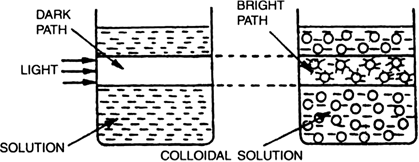
Fig. Tyndall effect.
(iii) Electrophoresis: When an electric current is passed through a colloidal solution, the particles move either towards the positive or negative electrode. This phenomenon is known as electrophoresis. By the direction of the movement of colloidal particles, we can know the nature of the charge on them.
Electrophoresis
The solubility of urea is 109.4 g/100 g in water at 20° C. A solution is formed by dissolving 500 g urea in 1 kg water. State the nature of the solution formed.
The solution contain more amount of solid in water in case of ((109.4 g/100 g) at 20°C. On other hand solution formed by 500g urea in 1 kg is contains lesser amount of the solid in water. Hence, solution formed is unsaturated.
Explain what happens when:
(i) a beam of light is passed through a colloidal solution.
(ii) an electric current is passed through a colloidal solution.
i) When a beam of light is passed through a colloidal solution the path of the light is illuminated. This is because colloidal particles scatter the light in the all directions.
ii) When an electric current is passed through a colloidal solution, colloid particles being either positively or negtively charged, starts move towards the oppositely charged electrode.
Classify the following mixtures into true solution, colloid and suspension:
(i) Mud water, (ii) sand water, (iii) lime water, (iv) aerated water, (v) milk, (vi) sugar in water, (vii) common salt in benzene, (viii) writing ink, (ix) blood, (x) jellies, (xi) butter, (xii) gold ornaments, (xiii) vinegar, (xiv) aluminium paint, (xv) mist, (xvi) lemonade, (xvii) coke, (xviii) wheat flour in water.
True solutions. Lime water, aerated water, sugar in water, gold ornaments, vinegar, lemonade, coke.
Colloids. Milk, writing ink, blood, jellies, butter, aluminium paint, mist.
Suspensions. Mud water, sand water, common salt in benzene, wheat flour in water.
How does a true solution differ from a colloidal solution? Differentiate on the basis of respective particle size.
|
Property |
Solution |
Colloidal solution |
|
(1) Appearance
|
Homogeneous and transparent
|
Heterogeneous and transluscent |
|
(2) Particle size
|
< 1 nm (10–7 cm)
|
1 nm—100 nm (10–7 cm—10–5 cm) |
|
(3) Visibility
|
Particles are not visible even with a powerful microscope
|
Particles can be seen with a high power microscope
|
|
(4) Stability
|
Stable |
Stable
|
|
(5) Diffusion |
Diffuse rapidly NaCl dissolved in water |
Diffuse slowly Blood |
Water in a stream after rain contains:
(i) air bubbles, (ii) salt, (iii) calcium bicarbonate, (iv) sand grains, (v) stone pieces and (vi) unfiltrable clay particles. Select from these one example each of solvent, a solution, a suspension and a colloid.
After rain water contain:
Solvent—water
Solution—salt solution
Suspension—sand grains
Colloid—unfiltrable clay particles.
Given below the list of some colloids. Make a list selecting them on the basis of type of dispersing medium. Also give the nature of dispersed phase in each.
fog, clouds, shaving cream, milk, face cream, milk of magnesia, foam, rubber, sponge, jelly, cheese, butter, paint, writing ink, smoke, blood, coloured gemstone.
Selection of colloids on the basis of type, dispersed phase and dispersion medium:
|
Dispersing medium |
Colloids |
Dispersed phase |
Type |
|
1. Gas |
fog, clouds, mist smoke, automobile exhaust |
liquid solid |
aerosol |
|
2. Liquid |
shaving cream, milk, face cream, writing ink, blood, paint milk of magnesia, mud |
gas liquid
solid |
foam emulsion
sol |
|
3. Solid |
foam, rubber, sponge, pumice |
gas
|
foam gel
|
Giving example, state the use of a solution, a colloid and a suspension in our daily life.
Solutions: When two reacting substances are kept in contact, the reaction does not take place or is very slow. But when their solutions are mixed, the reaction takes place very fast. This happens because in solutions, reacting substances come in contact with each other at molecular level. When solid washing soda is poured over clothes, it does not wash but when clothes are mixed with solution of washing soda, clothes are easily cleaned.
Colloids: Some insoluble substances particularly in pharmaceuticals become more effective when administered in colloidal form. Many medicines are insoluble in water but are used in the form of colloids.
Suspensions: Many substances insoluble or sparingly soluble in dispersing medium become useful for analytical purposes when dispersed temporarily. For example, sparingly soluble barium sulphate dispersed in water is an opaque medium and is used for diagnostic X-rays.
Give four properties each of a solution, a colloid and a suspension.
|
Property |
Solution |
Colloidal solution |
Suspension |
|
(1) Appearance
|
Homogeneous and transparent
|
Heterogeneous and transluscent |
Heterogeneous and opaque |
|
(2) Particle size
|
< 1 nm (10–7 cm)
|
1 nm—100 nm (10–7 cm—10–5 cm) |
> 100 nm (10–5 cm)
|
|
(3) Visibility
|
Particles are not visible even with a powerful microscope
|
Particles can be seen with a high power microscope
|
Particles can be seen with naked eyes
|
|
(4) Stability
|
Stable |
Stable
|
Unstable |
|
(5) Diffusion |
Diffuse rapidly NaCl dissolved in water |
Diffuse slowly Blood |
Do not diffuse Mud water |
A mixture is homogeneous and light is not visible on passing through it. State what can you infer about the nature of the mixture and size of its particles.
The mixture is homogeneous, it must be a true solution. The particles of a true solution are smaller than 1 nm diameter and cannot scatter beam of light.
The particles of a mixture are approximately 40–50 nm in diameter. Can the constituents of the mixture be separated by centrifugation or filtration.
Since the size of the particles are approximately 40-50 nm in diameter. Therefore it is colloidal solution.
The colloid can be separated by centrifugation not by filtration.
A mixture is heterogeneous. How will you know whether it is a solution, a colloid or a suspension.
The given mixture cannot be a solution because a solution is always homogeneous. If this mixture is left undisturbed for some time and no solid settles down, then it is colloid otherwise it is suspension.
Why does the beam of light illuminated when it enters a room through a small hole?
When a beam of light entering through a small hole appears illuminatied because the light beam is scattered by randomly moving dust particles.
What is Tyndall effect? Why is Tyndall effect observed when sun light passes through dense forest.
The illumination of beam of light due to scattering on collision with tiny particle (which act as particles of colloid dispersed) is called Tyndall effect.
In dense forest, particularly in the early morning, there is fog, i.e., tiny water droplets suspended in air. These droplets are large enough to scatter beam of light. This is why Tyndall effect can be observed when sunlight passes through dense forest.
To make a saturated solution, 36 g of sodium chloride is dissolved in 100 g of water at 293 K. Find its concentration at this temperature.
Mass of sodium chloride = 36 g
Mass of water = 100 g
Mass of solution = 100+36 = 136 g
Concentraction of solution =
Thus,
Why is the separation of a mixture done?
Separation of components of a mixture is done for the following purposes:
(i) To remove harmful components such as insects from grains or insects and other soluble impurities from water.
(ii) To remove an undesirable component such as stones etc. from wheat, rice.
(iii) To obtain a useful component such as butter from milk or gur from sugarcane.
(iv)To obtain a pure sample of a substance.
What is the principle of separation?
Principle of separation depend on the difference in physical or chemical properties of constituents of a mixture. Depending upon the kind of constituents and their respective properties, different techniques are used.
What are the commonly used techniques used by farmers in villages to purify food grains?
Farmers generally use the following techniques:
(i) Winnowing: It is the method of separating lighter husk from grain with the help of air.
(ii) Hand-picking. The method of hand-picking is used to separate undesirable components from the mixture such as small pieces of stones, husk, grain from wheat, rice and pulses.
(iii) Sieving. It is the processes of separating particles of different sizes by allowing them to pass through sieve having different hole sizes.
Name the physical processes commonly used in laboratories, industries to separate mixtures.
The physical process commonly used in laboratories are:
(i) Evaporation. It is the process of removing water from solution by leaving in sun or heating on water bath.
(ii) Sedimentation. It is the process in which heavy solid particles are allowed to settle at the bottom of the vessel and then followed by decantation of the clear liquid.
(iii) Magnetic separation. It is the process in which magnetic substances are separated from non-magnetic substances with the help of a magnet.
(iv) Centrifugation. It is the process in which lighter suspended particles in a liquid are made to settle down by rotating the mixture at high speed.
(v) Filtration. It is the process of separating solid particles from liquid by passing the liquid mixture through a filter paper.
(vi) Crystallisation. It is the process of getting crystals of pure substance from its solution.
(vii) Sublimation. In this process a solid substance from a mixture of solids is directly converted into vapours (followed by condensation) by heating without passing through liquid state.
(viii) Distillation. It is the process in which one liquid is separated from its mixture by converting it into vapours and then cooling them.
Give two examples of solutions containing a non-volatile component and a volatile component. How will you obtain non-volatile component from such a solution?
(a) Solution of sugar (non volatile component) in water (volatile component).
(b) Solution of ink (non-volatile component) in water (volatile component).
Non-volatile component from a solution can be obtained by the process of evaporation.
Experiment. Take a beaker half filled with water. Put a china dish or watch glass on the mouth of the beaker. Pour some drops of solution in the watch glass. Heat the beaker. Your will find that water from solution starts evaporating. Continue heating till evaporation goes on and only solid material is left behind. Solid material left behind is the non-volatile component. The volatile component, i.e., water gets evaporated.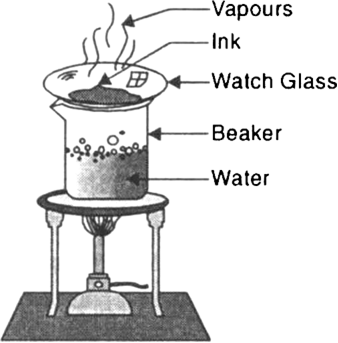
Fig. 2.2. Evaporation.
Sponsor Area
What is centrifugation. How it is done?
Centrifugation is the process of separating suspended particles from a liquid like colloids by churning the liquid at a high speed. The principle is that denser particles are forced to the bottom and lighter stay at the top when spun rapidly.
The mixture is taken in a closed bottle and rotated at a high speed. The heavy particles settle at the bottom while light particles remain behind. For example, to separate cream from milk, milk is churned for 2-3 minutes. Cream collects at the centre and being lighter than milk floats at the top of the mixture.
Give any four applications of centrifugation.
Centrifugation is a process which involves the application of the centripetal force for the sedimentation of heterogeneous mixtures with a centrifuge.
Applications of centrifugation:
(a) Used in dairies and home to separate cream from milk or butter from cream.
(b) Used in washing machines to squeeze out water from clothes.
(c) Used in laboratories to separate colloidal particles from their solutions.
(d) Used in diagnostic labs for blood and urine test.
Discuss the use of separating funnels.
Separating funnels are used to separate two liquids which do not form homogeneous mixture on mixing but form two distinct layers. The principle is that immiscible liquids separate out in layers depending on their densities. The immiscible liquids like water and mustard oil when mixed form two separate layers, hence they can be separated using separating funnels.
Experiment. Take the mixture of water and mustard oil in a separating funnel. Allow the mixture to stand undisturbed for sometime. When separate layers of oil and water are formed, oil being lighter makes the upper layer. Open the stopcock of the separating funnel and pour out the lower layer of water into the beaker carefully. Oil remaining behind is then collected in another beaker or flask.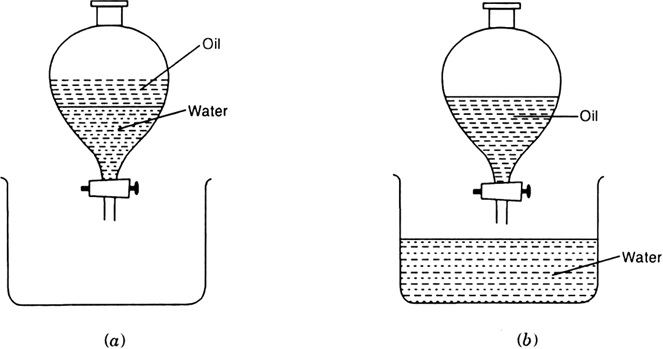
Fig. (a) Mixture (b) pure liquids.
Define and explain distillation.
Distillation is a process to obtain pure liquid from its solution. Distillation can be defined as the conversion of impure liquid into vapours by evaporation and then condensation (cooling) of the vapours into the pure liquid.
Impure liquid or mixture is taken in a flask, fitted with a condenser as shown in Fig. When heated, liquid gets evaporated and the vapours pass to the delivery tube where they condense into liquid. The pure condensed liquid is collected in receiver. The solid remains behind in the flask, hence gets separated. This method is generally used for the separation of components of a mixture containing two miscible liquids that boil without decomposition and have sufficient difference in their boiling points.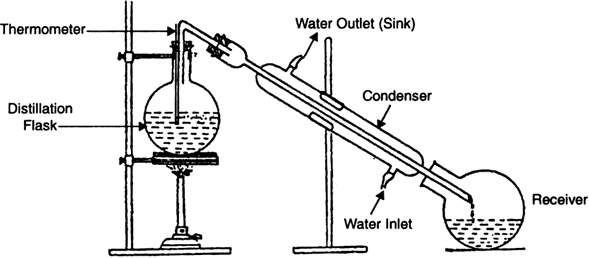
Fig. Distillation.
What types of mixtures can be separated by simple distillation ?
Simple distillation can be used to separate the following mixtures:
(a) It is used for the separation of components of a mixture containing two miscible liquids that boil without decomposition and have sufficient difference in their boiling points.
(b)This method is used for the separation of different gases from air, different factions from petroleum products etc.
How will you separate a mixture of ethyl alcohol (boiling point 78°C) and water (boiling point 100°C) ? Describe the process.
Ethyl alcohol and water are completely miscible liquids and these have sufficient difference (22°C) in their boiling points. So these can be separated by the process of simple distillation.
Experiment. Arrange the apparatus as shown in Fig. Take the mixture of ethyl alcohol and water in a distillation flask. Heat slowly till the liquid starts boiling and the temperature of the liquids starts rising. At 78°C, vapours of alcohol will be formed and get collected as liquid in the receiver after passing through the condenser. Temperature will remain constant till all the alcohol in the mixture is evaporated. When the temperature starts rising, stop heating. Pure water is left in the distillation flask and alcohol collects in the receiver.
A mixture of acetone and toluene was distilled in a distillation flask. On slow heating it was found that temperature became constant at 56°C for some time and the residual liquid left was toluene. When the heating was continued, again the temperate became constant at 80°C.
Answer the following questions.
(a) What is the boiling point of acetone and toluene ?
(b) Why was it possible to separate acetone from toluene ?
(c) Why does temperature remain constant for some time at 56°C even though heating was continued.
(a) The boiling point of acetone and toluene are 56°C and 80°C respectively.
(b) The mixture of acetone and toluene could be separated by simple distillation because these two miscible liquids have a large difference in their boiling points.
(c) The temperature at 56°C remains constant for some time because heat given at this temperature first gets converted into latent heat of vaporisation of acetone.
What is the advantage of distillation over evaporation?
Distillation is more advantageous than evaporation because, in evaporation liquid is lost where as in distlliation liquid can be recoverd.
What is chromatography? State its applications.
Chromatography is the technique whereby different soluble components of a mixture are separated due to their differential movement over a stationary phase under the influence of mobile phase, i.e., solvent. If hexane is the solvent then the component that is more soluble inhexane will move faster. In this way the different components get separated.
The technique of chromatography is used to separate
(a) components of dyes
(b) pigments from natural colours
(c) amino acids
(d) sugars from urine samples
(e) drugs in blood.
What is blue/black ink that we use in our daily life?
Blue/black ink is a solution of dye in water. This dye is a mixture of two or more coloured components. For example black ink is used in printing news paper, books, etc.
Describe the process to show that the dye used in blue/black ink is a mixture of two or more components.
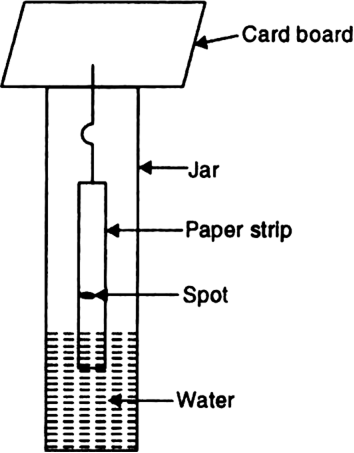
What is the important criteria to use chromatography for separating components of a mixture?
Chromatography is the process of separation of the individual components of a mixture based on their relative affinities towards stationary and mobile phases.
What is a fractionating column? Explain its advantage.
When the boiling points of the two liquids are quite close (difference less than 20-25°C) the separation is not successfully affected by using simple distillation process but is affected by fitting the flask with a fractionating column.
A fractionating column is a long tube provided with obstructions or packed with glass beads. The obstructions provided slows down the passage of vapours upwards and that of the liquid downwards.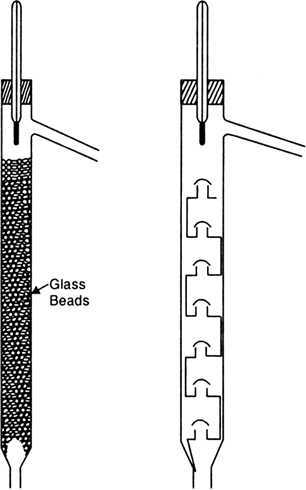
Fig. Fractionating columns.
Advantages. Suppose you have a mixture of liquids (say A with boiling point 80°C and B with boiling point 90°C). Set up the apparatus as shown in Fig. 2.9. On heating the flask the vapours obtained consist more of A and less of B. As the vapours rise up the fractionating column, they condense partially and the condensed liquid flows down. Vapours of B having higher boiling point will condense more rapidly than the vapours of A having lower boiling point. As a result the vapours moving up get richer in A. The condensed liquid flowing down meets the ascending stream of vapours and in the process takes away more of high boiling liquid B. The process is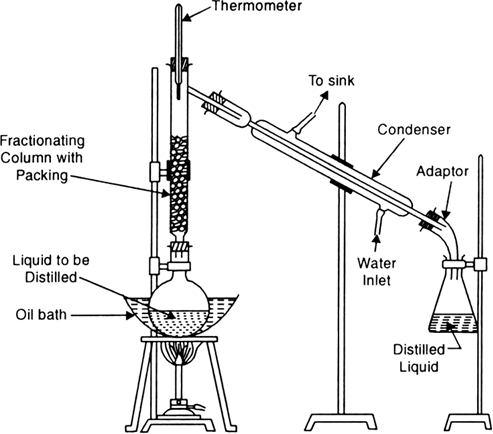
Fig. Fractional distillation.
repeated throughout the length of fractionating column. Consequently, the vapours which escape from the top of the fractionating column into the condenser consist of almost pure A. Thus the distillate received is pure A whereas the liquid left behind in the flask is rich in B. Pure B can then be obtained by simple distillation. The process of fractional distillation with fractions A and B are repeated if the boiling point difference is very low.
Give two important industrial applications of fractional distillation.
Two important industrial applications of fractional distillation:
(a) Separation of petroleum products-petrol, diesel and other organic compounds are obtained from crude petroleum.
(b) Separation of gases like oxygen, nitrogen, argon from air.
How is air separated into its constituents?
Air is a homogeneous mixtures of several gases which have boiling points much below room temperature. Air is first of all brought to liquid form under higher pressure and reduced temperatures. Then at constant high pressure, it is slowly warmed up in fractionating column. Different fractions of air are then obtained in gaseous form at different temperatures. The gas with lowest boiling point is obtained first and so on.
Oxygen, argon and nitrogen boil at –182°C, –186°C and –196°C respectively.
Answer the following questions:
(a) Arrange the gases in the increasing value of boiling point.
(b) Which gas forms the liquid first as the air is cooled?
(c) Which gas is obtained first when liquid air boils up?
(a) In the increasing value of boiling point.
Nitrogen < argon < oxygen
(b) Oxygen forms liquid first as the air is cooled.
(c) Nitrogen has least boiling point. hence it obtained first.
Diesel oil, kerosene, petrol and petroleum ether are different fractions of crude petroleum. These have boiling point ranges as 525–670K, 453–550K, 343–473K and 303–363K respectively. When crude petroleum is heated on a fractionating column, arrange the fractions in the order these are collected in the distillate.
Fractional distlillation is based on the difference in boiling point is less than 25K. Since the boiling point difference is more than 25 K . Therefore the order of distillate is petroleum ether, petrol, kerosene, diesel oil.
Name the process used to obtain pure solid from its impure sample. Describe the process taking impure sample of sugar as an example.
The process of crystallization is used to purify a solid from its impurities.
Description of crystallization:
i) Take about 5 gm of a sample of impure sugar dissolved in minimum amount of water.
ii) Filter the impurities. Saturate the solution by heating in a china dish.
iii) when some solid starts appearing.
iv) Cover the solution with filter paper and leave it undisturbed to cool slowly for a day.
The crystals of pure sugar so obtained are separated either by decantation or filtration.
What are the advantages and disadvantages of crystallization over evaporation?
Crystalization seperate as solid crystals and if we evapourated its being lost and both on heating.
Advantages of crystallization:
(i) Fine crystals of the substance are obtained.
(ii) Solids which decompose on heating can be safely purified.
Disadvantages of crystallization:
(i) Some substance remains with the liquid/solvent.(ii) Liquid needs to be purified for further use.
What is decantation? Explain.
Decantation is the process of separation of insoluble solids from liquids. A suspension of solid particles in a liquid is allowed to stand for sometimes. Insoluble solid particles settle down at the bottom due to their weight. This is called sedimentation. The clear liquid is then transferred into another container, without disturbing the settled particles. In other words clear liquid is decanted and separated from solid.
Explain the methods by which you would separate camphor from sodium chloride.
Camphor would separate from sodium chloride by sublimation or Filtration.
(i) Sublimation: Mixture of camphor and sodium chloride is heated in a china dish covered with an inverted funnel closed from the lower end. Camphor sublimes and collects on the inner wall of the funnel. Sodium chloride is left as residue in china dish.
(ii) Filtration. Dissolve the mixture in water. Sodium chloride dissolves in water while camphor remains as residue. It is then filtered. Residue left on filter paper is camphor. Sodium chloride is then recovered from water by evaporation.
You are given a mixture of sand, water and mustard oil. How will you separate the components of the mixture.
Take the mixture of sand, water and mustard oil. Let the solution to stand undisturbed for about half an hour. The heavy sand particles settle down at the bottom of the container. Now transfer the liquid to another beaker in such a way that the sand remains in the first beaker.
Take the remaining mixture of mustard oil and water in a separating funnel. Let the funnel to stand undisturbed for half an hour. Water and mustard oil forms two distinct layers. Oil being lighter forms upper layer while the water forms lower layer. Open the tap of the separating funnel and let the lower layer to collect down in the beaker. Close the tap when lower water layer is completely separated. Take out the oil layer in another beaker. Thus the components of mixture are separated.
Name the processes for separation in the following cases:
(i) Fine insoluble particles suspended in a liquid.
(ii) A solid substance dissolved in a liquid.
(iii) A sublimable solid mixed with other solids.
(iv) Salt from sea water.
(v) Three solid substance soluble in a mixture of solvents.
(vi) Two liquids which are completely immiscible.
(vii) Two miscible liquids having 10°C difference in their boiling points.
(viii) Mixture of nitrogen and helium gases.
(i) Centrifugation and filtration or decantation.
(ii) Evaporation or distillation or crystallization.
(iii) Sublimation.
(iv) Evaporation or crystallization.
(v) Chromatography.
(vi) Separating funnel.
(vii) Fractional distillation.
(viii) Cooling and fractional distillation.
How will you separate a mixture containing kerosene and petrol (difference in their boiling points is more than 25 °C), which are miscible with each other?
As both kerosene and petrol do not decompose on heating and the boiling points difference between kerosene and petrol is more than 250C. Thus, these can be separated by using simple distillation technique.
Name the technique to separate:
(i) butter from curd
(ii) salt from sea-water
(iii) Camphor from salt.
Techinque to separate:
(i) Butter from curd : Centrifugation
(ii) Salt from sea-water : Evaporation
(iii) Camphor from salt : Sublimation
What type of mixtures are separated by the technique of crystallization?
Crystallization is used to:
(i) Purify salt that we get from sea water.
(ii) Obtain pure substances from their impure samples. For example separation of crystal of alum (phitkari) from impure samples.
Define physical and chemical changes.
Physical change.: Physical change is a temporary change in which the composition and chemical nature of the substance remains the same but the state of the substance and physical properties changes. For example, when ice changes into water and water changes into vapours. All have different appearance and display different physical properties but they are chemically same.
Chemical change. A chemical change is a permanent change in which not only physical properties but chemical properties also change. This is because new substance/s is formed in a chemical change. Burning of candle is a chemical change. Here both the physical and chemical changes are taking place and new substances are formed.
Give reason for each of the following:
(i) Ripening of a fruit is a chemical change.
(ii) Crystallization of a substance from its solution is a physical change.
(iii) Formation of curd from milk is a chemical change.
(iv) Separation of gases from air is a physical change.
(i) Composition and properties of fruit initially are entirely different than those after ripening of fruit. It cannot be reversed. Hence, it is a chemical change.
(ii) Crystallization of a substance is a physical change because there is no change in composition and chemical properties of the substance. The crystallized substance can again be made into solution.
(iii) Curd and milk have entirely different properties and curd cannot be changed to milk. Hence it is a chemical change.
(iv) Separation of gases from air is a physical change because separated gases can again be mixed.
Giving reason, explain which of the following is a physical change.
(i) Electric current is passed through water and hydrogen and oxygen gas are formed.
(ii) Electric current is passed through a bulb and it glows.
(i) When electric current is passed through water, it break water molecule in hydrogen and oxygen gas. Hence new products are formed whose properties is different from the water, thus it is a chemical change.
(ii) Electric current is passed through a bulb and it glows—is a physical change because when current is stopped, bulb does not glow and no new substance is formed.
Giving reason explain burning of oil is a chemical change.
Burning of oil is chemical change because during the buring oil react with oxygen and produce new substances, whose properties are different from the oil.
Does the energy changes take place both in physical and chemical changes?
Yes, energy changes take place in both physical and chemical changes. For example evaporation of liquid is a physical change and energy is absorbed in this case. Burning of candle is chemical change and energy is evolved. Hence energy is involve in both case.
Differentiate between physical and chemical changes.
Given below is a comparison of two types of changes:
|
Physical changes |
Chemical changes |
|
1.Changes take place only in properties such as colour, physical state, density etc. |
1.Change result in the formation of new chemical substance. |
|
2.Change is temporary. |
2.Change is permanent. |
|
3.Original substance(s) can be obtained back easily. |
3.Original substance cannot be obtained back easily. |
|
4.Chemical properties of the substance remain unchanged even after the physical change. |
4.New substance with different properties are formed. |
Give some examples of physical and chemical changes.
Physical changes:
Examples of physical changes are: breaking of glass tumbler, drying of clothes, cutting a fruit with knife, breaking of a brick with hammer, changing of visible shapes of moon, melting of wax.
Chemical changes:
Examples of chemical changes are: burning of paper, cooking of food, rusting of iron, making of ice-cream, burning of wax, eating of sugar.
Classify the following as a chemical or physical change.
(i) Cutting of trees; (ii) Melting of butter in a pan; (iii) An almirah gets rusted; (iv) Water boils to form steam; (v) Electric current is passed through water and it is broken down into hydrogen and oxygen gas; (vi) Dissolving salt in water.
(i) Cutting of trees–Physical Change
(ii) Melting of butter in a pan–Physical change
(iii) An almirah gets rusted–Chemical change
(iv) Water boils to form steam–Physical change
(v) Electric current is passed through water and it is broken down into hydrogen and oxygen–Chemical change
(vi) Dissolving salt in water–Physical change
Name and explain any five physical changes.
1. Change of physical state: Solids can be converted into liquid and then to a gas by heating or vice-versa.
2. Glowing of an electric bulb: When a bulb is switched on, its filament made of tungsten starts glowing. When the bulb is switched off, the bulb stops glowing and there is no change in its filament.
3. Dissolution of salts: When common salt is added to water, a solution is formed. When the solution is heated, water evaporates and white solid of common salt is left behind. This white solid has the same properties as the original substance.
4. Mixing of iron filings and sulphur: If the iron filings are separated from sulphur with the help of a magnet, the properties of the substances recovered are the same as the original substances, i.e., iron filings and sulphur.
5. Sublimation of naphthalene: When naphthalene is heated, it gets converted into vapours which are sublimed (condensed) into a white solid, which has the same properties as the original substance.
Melting of wax is a physical change but burning of wax is a chemical change. Explain.
(i) Melting of wax changes the state of wax from solid to liquid. No new substance is formed. The chemical nature of solid wax and liquid wax is the same. Hence melting of wax is a physical change.
(ii) Burning of wax gives new gaseous products. Hence burning of wax is a chemical change.
Classify the following as chemical or physical changes:
• cutting of trees
• melting of butter in a pan
• rusting of almirah
• boiling of water to form steam
• passing of electric current through water and the water breaking down into hydrogen and oxygen gases
• dissolving common salt in water
• making a fruit salad with raw fruits
• burning of paper and wood.
• Cutting of trees—physical change
• melting of butter in a pan—physical change
• rusting of almirah—chemical change
• boiling of water to form steam—physical change
• passing of electric current through water and the water breaking down into hydrogen and oxygen gases—chemical change
• dissolving common salt in water—physical change
• making a fruit salad with raw fruits—physical change
• burning of paper and wood—chemical change
Try segregating the things around you as pure substances or mixtures.
Pure substances—copper wire, water, sugar, salt, etc.
Mixtures—fruits, furniture, paper, clothes, food, butter, shoes, vegetables, toothpaste, etc.
Define the term—Element. Give an illustration in support of your definition.
Element: An element is a substance which contains same kind of atom. It cannot be converted into anything visibly simpler than itself. For example, element mercury is composed of only one kind of atoms (with atomic no. 80). Gold, copper, hydrogen are other examples of elements. After the discovery of isotopes, the definition of an element is modified. It is more correct to say that element is a substance made up of atoms, all having the same atomic number.
ILLUSTRATION
Take about 5.0 g of mercuric (II) oxide (red oxide of mercury) in a hard glass test tube fitted with cork and a delivery tube as shown in Fig. 2.10. Heat the tube over a bunsen flame, first slowly and then strongly. After sometime you would observe a gas coming out of the capillary tube. If you bring a glowing matchstick near the mouth of the tube, the stick starts burning with a flame. That is due to evolved oxygen which is supporter of combustion. Continue heating the glass tube. After sometime, no more gas is evolved and a shining liquid is left at the bottom of the glass tube. That is mercury.
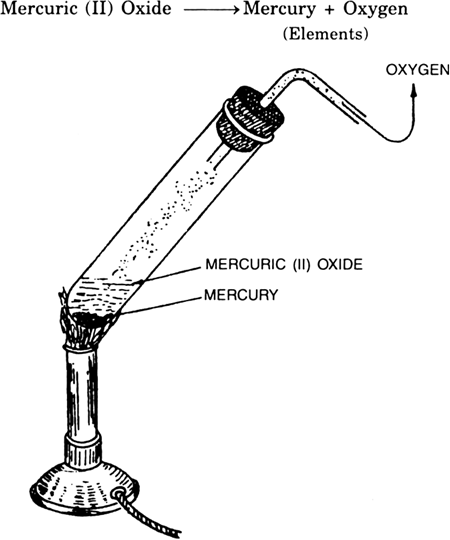
Conclusion. Red mercuric oxide on heating breaks up into two simpler substances, mercury and oxygen which are not further broken. Thus mercury and oxygen are elements.
Name a substance that cannot be decomposed under ordinary circumstances either by a physical process or a chemical process.
A substance that cannot be decomposed by a physical or a chemical process is known as an element. For example, oxygen, silver etc.
Sponsor Area
Define the term compound.
A compound is a substance which is formed by the combination of two or two more elements in a fixed proportion by weight. The properties of a compound are entirely different from its constituents. A compound can be decomposed into two or more simpler substances. For example, water is a compound formed by combination of 89% oxygen and 11% hydrogen by weight irrespective of its source. Its properties namely, density, physical state, reactivity etc. are quite different from the properties of hydrogen and oxygen. Water can be easily decomposed into hydrogen and oxygen. Carbon dioxide is made of carbon and oxygen, salt is made of sodium and chlorine and sugar is made of carbon, oxygen and hydrogen having their constituent elements in fixed proportions. Carbon dioxide, salt and sugar are compounds.
Give the difference between an element and a compound.
|
Element |
Compound |
|
1. It cannot be broken into more simpler form by chemical methods. |
1. It can be decomposed into its constituents by chemical methods. |
|
2. It is composed of atoms of one kind only. |
2. It is composed of atoms of different elements in a fixed proportion by weight. |
|
For Example Copper, iron, etc. |
For example H2O, methane etc. |
Classify each of following as element, compound or mixture.
(i) Sugar (ii) Iron (iii) Air (iv) Water
(v) Milk (vi) Phosphorus (vii) Urea (viii) Carbon dioxide
(ix) Diamond (x) Brass.
Classification of following substance as:
Elements : Iron, phosphorus, diamond.
Compounds : Sugar, water, carbon dioxide, urea.
Mixture : Air, milk, brass.
Which one of the following processes give a compound?
(i) Sodium is burnt in air;
(ii) Chalk and marble chips are ground together;
(iii) Mixing of sulphur with sodium chloride;
(iv) Addition of alcohol in water.
(i) Sodium is burnt in air to give a compound because sodium reacts with oxygen of air to give a new compound, sodium oxide.
Classify the following substances as elements, compounds or mixtures:
(i) Sodium, (ii) Hydrogen, (iii) Brass, (iv) Carbon dioxide, (v) Gun powder, (vi) Soda water, (vii) Water, (viii) Chlorine, (ix) Air, (x) Common salt, (xi) Stainless steel, (xii) Iron filings, (xiii) Oxygen, (xiv) Milk, (xv) Blood, (xvi) Ammonia, (xvii) Glass, (xviii) Marble, (xix) Emulsion, (xx) Wood.
Classification of substances:
Elements—(i) Sodium, (ii) Hydrogen, (viii) Chlorine, (xii) Iron filings, (xiii) Oxygen.
Compounds—(iv) Carbon dioxide, (vii) Water, (x) Ammonia, (xvi) Common salt, (xviii) Marble.
Mixtures—(iii) Brass, (v) Gun powder, (vi) Soda water, (ix) Air, (xi) Stainless Steel, (xiv) Milk, (xv) Blood, (xvii) Glass, (xix) Emulsion, (xx) Wood.
Why is hydrogen considered an element?
Hydrogen is considered an element because:
(i) Hydrogen cannot be broken into new substances by ordinary physical or chemical means i.e., by applying heat, light or energy.
(ii) Hydrogen has one kind of atoms.
Why is water considered a compound?
Water is considered as compound because:
(i) Water is composed of two elements:hydrogen and oxygen.
2H2 +O2 -->2H2O
(ii) The ratio of hydrogen and oxygen by mass in any sample of pure water is the same.
(iii) The properties of water are different from its constituent elements: hydrogen and oxygen.
(iv) Water can be decomposed by chemical means (e.g., electrolytically) into hydrogen and oxygen.
Name two:(i) gaseous elements, (ii) two liquid elements and (iii) two solid elements.
(i) Gaseous elements: Oxygen and Nitrogen
(ii) Liquid elements: Mercury and Bromine
(iii) Solid elements: Gold and Silver
Name the elements present in each of the following compounds.
(i) Magnesium carbonate
(ii) Sulphuric acid
(iii) Potassium nitrate.
Elements present in each of the compounds are:
(i) Magnesium carbonate consists of Magnesium, Carbon and Oxygen.
(ii) Sulphuric acid consists of Hydrogen, Sulphur and Oxygen.
(iii) Potassium nitrate consists of Potassium, Nitrogen and Oxygen.
A pure substance on heating leaves behind a white residue and gives out a colourless, odourless gas. Is the given substance an element, compound or mixture ?
(i) The given substance cannot be an element because on heating it breaks up into a gas and a white residue.
(ii) Since the substance is pure, it cannot be a mixture. Therefore, the given substance is a compound.
Name the material which shows the following properties:
(i) Average properties of constituents contained in it.
(ii) Has a fixed ratio of the components.
(iii) Cannot be converted into more simpler form by ordinary chemical methodsThe material which shows the following properties.
(i) Mixture
(ii) Compound
(iii) Element.
Giving reasons, choose the elements from the following substances:
(i) Stainless steel, (ii) Diamond, (iii) Graphite,
(iv) Iron filings, (v) Soda water, (vi) Common salt.
Element are made of only one kind of substance. i.e.,
(iv) Iron filings is an element as it is made up of only iron (Fe) atoms. (ii) Diamond and (iii) graphite are also composed of carbon atoms.
Other substances are not elements, since these are made of different substance.
(i) Stainless steel is a mixture of varying amounts of iron and carbon.
(v) Soda water is a mixture of carbon dioxide in water.
(vi) Common salt (NaCl) is a compound of sodium and chlorine.
Which of the following are elements:
Sulphur, ice, smoke, manganese, glucose.
Sulphur and manganese are elements.
Give three reasons to support that brass is a mixture, not a compound.
Composition of different substance in random amount is known as mixture.
Brass is a mixture because:
(i) Different samples of brass may have variable composition.
(ii) Different constituents of brass are separated by fractional melting.
(iii) The properties of brass depend on the percentage of each pure substance in it.
Name the types of elements.
Elements are roughly divided into
(i) Metals : For example Sodium, Iron, etc.
(ii) Non-metals : For example Nitrogen, oxygen, etc.
(iii) Metalloids: For example Boron, silicon, etc.
Write physical properties of metals?
Physical properties of Metals:
(i) State: Metals are amorphous solids. Only mercury is an exception which is not a solid. It is a liquid. They retain their shapes under normal conditions.
(ii) Hardness: Metals are very hard. Sodium is an exception which is not very hard. It can be cut into pieces easily. Hardness varies from metal to metal.
(iii) Metallic lustre: Most of the metals have a shining surface. They have a metallic lustre. Their shining can be intensified by polishing.
(iv) Malleability: Metals can be beaten into sheets. For example aluminium is beaten into sheet for different purpose.
(v) Ductility: Metals are ductile because they can be drawn into wires of desired diameter. metals like copper and aluminium used in electrical wires.
(vi) Conductivity. Metals are good conductors of heat and electricity.
(vii) Sonorousity. Metals are sonorous. They produce a ringing sound when struck.
(viii) High melting point. Metals have very high melting point. gallium is an exception which melt on your hand.
(ix) Tensile strength. Metals have a tensile strength. They can be stretched up to some degree without fracturing.
Write some physical properties of non-metals.
Physical Properties of non-metals:
(i) State: Non-metals are crystalline solids, liquids or gases.
(ii) Hardness: Non-metals are less hard than metal.
(iii) Lustre: Non-metals have a dull lustre. They do not reflect light well.
(iv) They are poor conductors of heat and electricity.
(v) They are non-malleable and non-ductile. Solid non-metals are brittle. They can be broken into pieces when hammered.
(vi) They have low boiling and melting points.
(vii) They have low densities.
What are metalloids? Give examples.
Metalloids are elements which have properties intermediate between those of metals and non-metals. Examples are silicon, germanium etc.
Give an account of elements known to us.
There are 115 elements known to us. 92 are natural elements. Rest 23 elements are man-made. 11 elements are gases, 2 elements are liquids and rest are solids at room temperature.
How many elements are non-metals? Out of these how many are solids, liquids and gases?
There are 22 non-metals:
10 non-metals are solids. Important solid non-metals are boron, carbon, silicon, phosphorus, arsenic, sulphur and iodine.
11 non-metals are gases. Some of these are hydrogen, nitrogen, oxygen, fluorine, chlorine. 1 non-metal is a liquid. For example, bromine.
Give some examples where the property-malleability and ductility of metals are used in our daily life.
Malleability means that metals can be hammered into sheets and foils. For example, aluminium foils are used for wrapping food stuffs, silver foils are used for decorative purposes on sweets and fruits.
Ductility means that metals can be drawn into wires. Gold and silver wires are used in ornaments. Aluminium and copper wires are used for conduction of electric current.
Give an example of a metal which:
(a) is liquid at room temperature (b) can be easily cut with a knife (c) is the best conductor of heat (d) is the poorest conductor of heat
(a) Mercury is liquid at room temperature.
(b) Sodium can be easily cut with knife.
(c) Silver is the best conductor.
(d) Lead is the poorest conductor of heat.
Mention the metals which are used for the following purposes :
(a) Domestic utensils and factory equipment
(b) Jewelleries
(c) Packaging food materials
(d) Atomic energy and space research
(e) Transport of electricity
(a) Domestic utensils and factory equipment
(b) Jewelleries
(c) Packaging food materials
(d) Atomic energy and space research
(e) Transport of electricity
(a) Iron, aluminium and copper can be used for domestic utensils and factory equipment.
(b) Gold and silver used for making jewelleries.
(c) Thin foils of aluminium used for packing food material.
(d) Titanium, Zirconium and Uranium can be used in atomic energy and space research.
(e) Copper and aluminium can be used to conduct electricity.
From amongst the list, choose the metals and non-metals, state the property on the basis of which you make your choice.
Chlorine, Aluminium, Sulphur, Sodium, Silver, Helium, Carbon
Chlorine is a non-metal. It is a gas at room temperature and is brittle.
Aluminium is a metal. It is good conductor of heat and electricity.
Sulphur is a non-metal. It is brittle and non-malleable or ductile.
Sodium is a metal. It shows lustre and malleable.
Silver is a metal. It shows lustre and is the best conductor of heat.
Helium is a non-metal. It is a gas and does not conduct electricity.
Carbon is non-metal. It is non-malleable and non-ductile.
State two properties of sodium in which it shows behaviour which is not expected from its classification as a metal.
(a) Metals are generally hard but sodium is soft.
(b) Metals are sonorous but sodium is not.
State two properties of carbon which are not expected from its classification as a non-metal.
(a) Non-metals do not conduct heat and electricity but carbon in the form of graphite is a good conductor of electricity.
(b) Non-metals are brittle and soft but carbon in the form of diamond is very shining or hard substance.
Distinguish between metals and non-metals.
|
Metal |
Non-Metal |
|
1. Metals are solids at room temperature. |
1. Non-metals may be a gas, a liquid or a solid at room temperature. |
|
2. Metals have a shining metallic luster. Their shining can be intensified by polishing.
|
2. Non-metals have a dull non-metallic luster.
|
|
3. Metals are hard substances. |
3. Non-metals have hardness of varying category.
|
|
4. Metals are malleable. |
4. Non-metals are non-malleable. |
|
5. Metals are ductile and can be drawn into wires |
5. Non-metals are not ductile and cannot be drawn into wires. |
|
6. Metals have high specific gravity.
|
6. Non-metals have low specific gravity. |
|
7. Metals are good conductors of heat and electricity. |
7. Non-metals are bad conductors of electricity, except graphite which is a good conductor of electricity.
|
|
8. Metals form alloys with other metals. |
8. Non-metals do not form alloys with other non-metals. |
|
Example of metal silver, sodium, iron, copper, gold, etc. |
Example of non-metal Iodine, carbon, oxygen, nitrogen, etc. |
Write characteristics of compounds.
Characteristics of compounds:
(ii) Compounds are the substances formed by chemical combination of two or more elements.
(ii) The constituent elements are present in a fixed ratio. For example water is compound and compose in 1:2 such that 1 part of oxygen and 2 part of hydrogen.
(iii) A chemical reaction takes place during the formation of a compound.
(iv) Properties of a compound are different to those of its elements.
(v) Constituent elements cannot be separated by physical processes.
How can matter be classified on the basis of its chemical constitution?
Matter can be classified on the basis of its chemical constitution. such as element, compound or mixture.
What process is used to separate husk from corn?
Husk can be separate from corn by winnowing.
Name three materials that are used as filters.
Cotton, filter paper, sand can be used for Filtration.
Name the method to separate iron from waste material.
Iron can be separated by magnetic separation.
What method will you use to separate copper sulphate from its solution?
Copper sulphate can be separated by crystallization.
Is the rusting of iron in air a physical change or chemical change?
Rusting of iron is a Chemical change.
The path of light get scattered when passed through milk. What is this effect?
Tyndall effect.
Name two elements which are liquids at room temperature.
Mercury and bromine are liquid at room temperature.
Name two elements that become liquids at a temperature just above 30°C.
Gallium and cesium become liquid at 30°C.
How many elements are gaseous?
11 elements are gas : H, He, N, O, F, Ne, Cl, Ar, Kr, Xe, Rn.
Name a non-metal which conducts heat and electricity.
Carbon in the form of graphite can conduct heat and electricity.
How will you obtain pure copper sulphate from an impure sample?
Pure copper sulphate obtained by crystallisation from an impure sample.
To obtain a solid from its solution, which technique is better. Evaporation or Crystallisation?
Crystallisation.
When you slowly heat a liquid, at some point the temperature of the liquid becomes constant. What is this point?
When liquid is slowly heated, at some point the temperature of the liquid becomes constant because the liquid changes its state to gas state and it is known as boiling point of the liquid.
What should be the minimum difference in temperature between the boiling points of two miscible liquids that these can be separated by simple distillation method?
What is the process called in which pigments of natural colours can be separated?
The pigments of natural colours can be separated by Chromatography.
Which technique is used in dairies and home to separate butter from cream?
Butter is separated from cream by centrifugation.
What is the essential condition that the components of a mixture can be separated by chromatography?
Components of should be coloured substances.
Take the odd substance out :
Camphor, naphthalene, sodium chloride, ammonium chloride
Sodium chloride is odd substance of the given list because they are separted by sublimation but sodium chloride is not separted by this method.
Impure salts can be purified by the process of __________.
crystallisation
Impure salts can be purified by the process of..................
Which one of the following is a physical change:
burning of magnesium
exposure of iron to air and moisture
dissolution of sugar in water
formation of a compound
C.
dissolution of sugar in water
Which one of the following may be termed as pure substance:
sodium chloride
soft drink
aerosol
soil.
A.
sodium chloride
Tyndall effect will be shown by a
compound
true solution
mixture
colloidal solution.
D.
colloidal solution.
Which one of the following is a chemical change:
evaporation of spirit
freezing of water
heating of copper and sulphur
mixing of H2 and O2.
C.
heating of copper and sulphur
Which one of the following is a chemical change :
Identify solution among the following mixtures
gun powder
soil
blood
aerated water
D.
aerated water
Solution of soap in water is a
true solution
colloidal solution
suspension
none of above
B.
colloidal solution
The size of particles in solutions is
7 -5
smaller than 10 cm
bigger than 10 cm
—5 —8 — 5
between 10 and 10 cm
less than 10 cm
A.
smaller than 10 cm
A colloidal solution is
homogeneous mixture
heterogeneous and transparent mixture
heterogeneous mixture in which particles can be seen with naked eyes
heterogeneous mixture in which particles cannot be seen with naked eyes.
D.
heterogeneous mixture in which particles cannot be seen with naked eyes.
Separating funnel is used to separate
mixture of substances in solution
miscible mixture of liquids
mixture of immiscible liquids
insoluble solid in solvent
C.
mixture of immiscible liquids
Take 5 gm each of iron filings and sulphur in a china dish. State which activity gives a compound.
Mix and crush the mixture.
Add carbon disulphide, stir well and filter.
Heat strongly till red hot while mixing.
Separate iron filings with the help of a magnet.
C.
Heat strongly till red hot while mixing.
Shaving cream is a colloidal solution of gas in liquid
liquid in liquid
solid in liquid
gas in solid
gas in liquid
liquid in liquid
solid in liquid
gas in solid
A.
gas in liquid
Gases are separated from each other by
fractional evaporation
fractional distillation
fractional crystallization
fractional sublimation.
B.
fractional distillation
An object experiences a net zero external unbalanced force. Is it possible for the object to be travelling with a non-zero velocity? If yes, state the conditions that must be placed on the magnitude and direction of the velocity. If no, provide a reason.
Yes, even when the net external force is zero, an object may travel with non-zero velocity.
A rain drop falls downwards with a constant velocity. The net force on the drop is zero because the weight of the drop is balanced by the upthrust and the viscosity of air.
When a carpet is beaten with a stick, dust comes out. Explain why?
When a carpet is beaten with a stick, it comes into motion. But the dust particles continue to be at rest due to inertia and get detached from the carpet.
Why it is advised to tie any luggage kept on the roof of a bus with a rope?
When a bus takes sharp turn on the road, a sudden jerk is felt. As a result of the sudden jerk, the luggage may fall down from the roof because of its tendency to continue moving in the original direction. In order to avoid this, the luggage is tied with a rope on the roof.
A batsman pushes a cricket ball which then roll on a level ground. After covering a short distance, the ball comes to rest. The ball slows to a stop because
(a) the batsman did not hit the ball enough.
(b) velocity is proportional to the force exerted on the ball.
(c) there is a force on the ball opposing the motion.
(d) there is no unbalanced force on the ball, so the ball would want to come to rest.
The ball comes to a stop because,
(c) There is a force on the ball opposing the motion.
A 8000 kg engine pulls a train of 5 wagons, each of 2000 kg along a horizontal track. If the engine exerts a force of 40,000 N. If the track offers a friction force of 5,000 N, then calculate:
(a) the net acceleration force;
(b) the acceleration of the train; and
(c) the force of wagon 1 on wagon 2.
Total mass of engine and 5 wagons, m = 8,000 + 5 x 2,000 = 18,000 kg
(a) The net accelerating force is given by,
F = Engine Force - Friction Force
= 40,000 - 5,000
= 35000 N.
(b) The acceleration of the train is given by, ![]()
(c) The force of wagon 1 on wagon 2
= Net accelerating force - mass of wagon x acceleration 
An automobile vehicle has a mass of 1,500 kg. What must be the force between the vehicle and road if the vehicle is to be stopped with a negative acceleration of 1.7 ms–2?
Here,
Mass of the vehicle, m = 1500 kg
Acceleration, a = -1.7 ms-2
Force, F = ma = 1500 x (-1.7) = - 2,550N
The force between the vehicle and the road is 2,550 N.
The negative sign implies thatforce is acting in a direction opposite to the direction of the vehicle.
Using a horizontal force of 200 N, we intend to move a wooden cabinet across a floor at constant velocity. What is the friction force that will be exerted on the cabinet?
The cabinet will move with constant velocity only when the net force on it zero.
Therefore, force of friction on the cabinet = 200 N, in a direction opposite to the direction of motion of the cabinet.
Two objects, each of mass 1.5 kg, are moving in the same straight line but in opposite directions. The velocity of each object is 2.5 ms–1 before the collision during which they stick together. What will be the velocity of the combined object after collision?
Here,
Mass of two objects are equal but their motion is in opposite direction.
That is,
m1 = m2 = 1.5 kg
Initial velocity, u1 = 2.5 ms-1, u2 = -2.5 ms-1.
Let v be the velocity of the combined object after the collision.
By conservation momentum,
Total momenta after collision = Total momenta before collision
i.e., (m1 + m2) v = m1u1 + m2u2![]() (1.5 + 1.5)v = 1.5 x 2.5 + 1.5 x (-2.5)
(1.5 + 1.5)v = 1.5 x 2.5 + 1.5 x (-2.5)![]() 3.0 v = 0
3.0 v = 0
So, v = 0 ms-1
Hence, the objects will have zero velocity after collision.
According to third law of motion when we push on an object, the object pushes back on us with an equal and opposite force. If the object is a massive truck parked along the roadside, it will probably not move. A student justifies this by answering that the two opposite and equal forces cancel each other. Comment on this logic and explain why the truck does not move.
Action and reaction can never cancel each other because they always acts on two different bodies.
The force of friction between the truck's tyres and the road is very large. Also, the weight of the truck is massive. So, when we push the truch it does not move.
A hockey ball of mass 200 g travelling at 10 ms-1 is struck by a hockey stick so as to return it along its original path with a velocity at 5 ms–1. Calculate the change of momentum occurred in the motion of the hockey ball by the force applied by the hockey stick.
Here,
Mass of the hockey ball, m = 200 g = 0.2 kg
Initial velocity of the ball, u = 10 ms-1
Final velocity, v = -5 ms-1
So, change in momentum = m(v - u)
= 0.2(-5 - 10)
= -3 kg ms-1.
A bullet of mass 10 g travelling horizontally with a velocity of 150 ms–1 strikes a stationary wooden block and comes to at rest in 0.03 s. Calculate the distance of penetration of the bullet into the block. Also calculate the magnitude of the force exerted by the wooden block on the bullet.
Here,
Mass of the bullet, m = 10 g = 0.01kg
Velocity with which the bullet is fired, u = 150 ms-1,
Final velocity, v = 0 m/s
Time taken for the bullet to strike the object, t = 0.03 s
Now, using the formula,
![]()
Acceleration is negative.
The distance of penetration of the bullet into the block is given by the second equation of motion,
An object of mass 1 kg travelling in a straight line with a velocity of 10 ms–1 collides with, and sticks to, a stationary wooden block of mass 5 kg then, they both move off together in the same straight line. Calculate the total momentum just before the impact and just after the impact. Also calculate the velocity of the combined object.
Here,
Mass of the object, m1 = 1 kg
Velocity of the object, u1 = 10ms-1
Mass of the wooden block, m2 =5 kg
Velocity after collision, u2 =0 m/s
Let v be the velocity of the combined object after the collision
That is,
Total momentum just before the impact is,
m1u1 + m2u2 = 1 x 10 + 5 x 0 = 10 kg ms-1
Total momentum just after the impact is,
(m1 + m2) v = (1+5)v = 6v kg ms-1
Using the law of conservation of momentum,
6v = 10 ![]() v = 10/6 = 5/3 = ms-1
v = 10/6 = 5/3 = ms-1
Therefore,
Total momentum just after the impact= 6 x 5/3
= 10 ms-1.
Akhtar, Kiran and Rahul were riding in a motorcar that was moving with a high velocity on an expressway when an insect hit the windshield and got stuck on the windscreen. Akhtar and Kiran started pondering over the situation. Kiran suggested that the insect suffered a greater change in momentum as compared to the change in momentum of the motorcar (because the change in the velocity of the insect was much more than that of the motorcar). Akhtar said that since the motorcar was moving with a larger velocity, it exerted a larger force on the insect. And as a result the insect died. Rahul while putting an entirely new explanation said that both the motorcar and insect experienced the same force and a change in their momentum. Comment on these suggestions.
The explanation given by Rahul is right. Both the motorcar and insect experience equal force and hence experiences the same change in their momentum.
But, the insect dies because of it's smaller mass or inertia as compared to the moving vehicle.
The following is the distance-time table of an object in motion
|
Time in seconds |
Distance in meters |
|
0 |
0 |
|
1 |
1 |
|
2 |
8 |
|
3 |
27 |
|
4 |
64 |
|
5 |
125 |
|
6 |
216 |
|
7 |
343 |
(a) What conclusion can you draw about the acceleration? Is it constant? Increasing? Decreasing? Or Zero?
(b) What do you infer about the forces acting on the object?
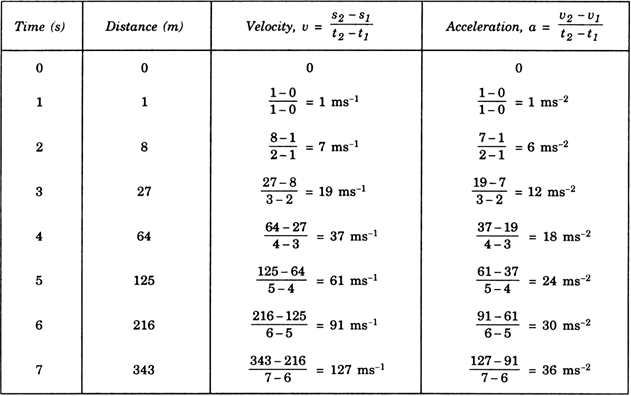
(a) The above table shows that the motion is accelerated and acceleration is increasing uniformly with time.
(b) As the acceleration is increasing uniformly, the force acting on the body is also increasing uniformly with time.
Two persons manage to push a motorcar of mass 1,200 kg at a uniform velocity along a level road. The same motorcar can be pushed by three persons to produce an acceleration of 0.2 ms–2. With what force does each person push the motorcar? (Hint : All persons push the motorcar with same muscular effort.)
Here,
Mass of the motor-car, m = 1200 kg
Acceleration, a = 0.2 s-1.
Clearly, the unbalanced force is exerted when the third person applies the force.
Therefore,
Force applied by the third person = ma
= 1200 x 0.2
= 240 N
As all the three persons push the motorcar with the same muscular effort, force exerted by each person = 240 N.
A large truck and a car, both moving with a velocity of magnitude v, have a head-on collision and both of them come to halt after that. If the collision lasts for 1 s:
(a) Which vehicle experiences the greater force of impact?
(b) Which vehicle experiences the greater change in momentum?
(c) Which vehicle experiences the greater acceleration?
(d) Why is the car likely to suffer more damage than the truck?
(a) Both vehicles experience equal forces of action and reaction because both the objects are moving.
(b) Since, both truck and car are moving with the same magnitude of velocity v, momentum change for both vehicles is same.
(c) Mass and acceleration are inversely proportional to each other. Therefore, car experiences greater acceleration due to its smaller mass.
(d) Due to its smaller mass or opposition to the force exerted on it, the car is likely to suffer more damage than the truck.
If a bus starts suddenly, the passengers in the bus will tend to fall
in the direction opposite to the direction of motion of the bus
in the same direction as the direction of motion of the bus
sideways
none of the above.
A.
in the direction opposite to the direction of motion of the bus
Tips: -
An athlete runs some distance before taking a long jump because
he gains energy to take him through long distance
it helps him to apply large force
by running action and reaction forces increase
by running the athlete gives himself larger inertia of motion.
D.
by running the athlete gives himself larger inertia of motion.
A rider on a horse back falls back when horse starts running all of a sudden because
rider is taken back
rider is suddenly afraid of falling
inertia of rest keeps the upper part of body at rest whereas lower part of the body moves forward with the horse
none of the above
C.
inertia of rest keeps the upper part of body at rest whereas lower part of the body moves forward with the horse
Inertia is the property of a body by virtue of which the body is
unable to change by itself the state of rest
unable to change by itself the state of uniform motion in a straight line
unable to change by itself the direction of motion
unable to change by itself the state of rest or of uniform motion in a straight line.
D.
unable to change by itself the state of rest or of uniform motion in a straight line.
Qualitative definition of force is given by
Newton’s first law of motion
Newton’s second law of motion
Newton’s third law of motion
Newton’s law of gravitation.
A.
Newton’s first law of motion
On applying a constant force to a body, it moves with uniform
momentum
speed
acceleration
velocity
C.
acceleration
A cannon, after firing recoils due to
conservation of energy
backward thrust of gases
Newton’s third law of motion
Newton’s first law of motion
C.
Newton’s third law of motion
A rocket or a jet engine works on the principle of
conservation of energy
conservation of momentum
conservation of mass
Newton’s second law of motion
B.
conservation of momentum
A bullet of mass ‘a’ and velocity ‘b’ is fired into a large block of mass ‘c’. The final velocity of the system is
Here,
Mass of the bullet, m = 10 g = 0.01 kg
Initial velocity, u = 150 ms-1
Final velocity, v =0 m/s
Time taken for the bullet to reach the target, t = 0.03 s
The distance of penetration of the bullet into the block, 
When an object undergoes acceleration
its speed always increases
its velocity always increases
it always falls towards the earth
a force always acts on it.
D.
a force always acts on it.
How can we change the state of motion of objects.
We can bring objects into motion by pushing, hitting and pulling them, as shown in the Fig.
When we apply an unbalanced force on the particle, the body is set into motion. 
Define the term force.
Force is defined as a push or a pull which tends to change the state of rest or uniform motion or direction of motion of a body.
For instance, force exerted by the engine makes the train move from its actual position of rest while the force exerted by the brakes slows down or stops the moving train.
State the various effects produced by a force.
The various effects produced by force are :
(i) An applied force can change the speed of the object making it move faster or slower.
(ii) Force can change the direction of motion of the object.
(iii) Force can change the shape of the object.
Give an illustration to show that force can change the speed of an object.
1. Let us consider the case of a horse which exerts force on a cart, pulls it from rest. Subsequently, exerting larger force, the horse makes the cart move with larger speed.
2. A player can stop a moving ball by exerting force on the ball in the opposite direction of its motion.
Give an illustration to show that a force can change the direction of motion of an object.
An applied force can change the direction of motion of an object. This can be illustrated from the following example given below.
When a ball at the end of a string is rotated in a circular motion, the hand exerts a force radially towards the centre of the circular path. This force continuously changes the direction of motion of the ball, thus enabling the ball to move along a circular path.
Give an illustration to show that a force can change the shape of an object.
Consider a spring attached to a rigid support at its one end, as shown in Fig.(a). 
Fig.(a): A spring expands on application of force; (b) A spherical rubber ball becomes oblong as we apply force on it.
If we pull the free end of the spring, it gets elongated. Thus, on appying a force, a spring expands.
Similarly, if we hold a rubber ball between our palms and push the two palms against each other, we find that the ball is no longer round but oblong. See fig. (b). The oblongation of the ball is due to the application of the force.
Define resultant force.
The forces that are acting simultaneously on a body producing the same effect on a body as all the forces together produce is called as the resultant force.
What are balanced forces? Give examples.
When the resultant of several forces acting on a body is zero, the forces are said to be ‘balanced forces’.
Balanced forces do not change the speed but changes the shape of the object.
Examples of balanced forces:
(i) If a bag full of books is held in hand steadily at a certain height from the ground, the resultant force on the bag is zero and so its position does not change.
(ii) Consider a wooden block lying on a table as shown in Fig.(a). 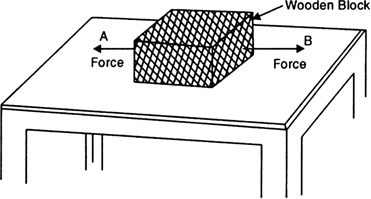
It has strings tied to its two opposite faces. /the wooden block move towards left, if the string is pulled at point A. If we pull at point B, it begins to move towards right.
But, if we pull from both, the sides with equal effort (and hence equal force), the block does not move.
The two forces have now balanced each other.
iii) In a tug-of-war, the rope does not move in any direction if the two teams pull the rope with equal effort.
The forces exerted by the two teams are equal and opposite and so get balanced.
This is illustrated as shown in fig. (b).

Give examples to show that balanced forces change the shape of the object on which they are applied.
When balanced force is applied on any object, it changes the shape of the object.
From the examples, we have
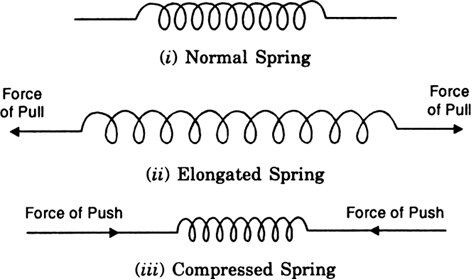
Fig (a). Balanced force cause change in shape.
(i) Consider a spring as shown in Fig (a).
If the string is pulled at it's two ends, the spring gets elongated. And if we push the spring at its two ends, it gets compressed. In both cases the two forces being equal and opposite, balance each other but change the shape of the spring.
(ii) When a rubber ball or an inflated balloon is pressed between the two palms, its shape changes. The forces exerted by the two palms are equal and opposite and thus balance each other. Hence, the shape of the ball changes.
What are unbalanced forces. Give examples.
When the resultant of several forces acting on a body is not zero, the forces are said to be unbalanced forces.
A change in the state of rest or uniform motion of a body is produced by unbalanced forces.
Below are given some examples of unbalanced forces:
(i) In a tug-of-war, when one of the two teams pulls the rope with a larger force, they are able to pull the weaker team towards it. Here the two forces are not balanced. Therefore, it results in the motion of the weaker team towards the larger force along the rope.
(ii) When we stop peddaling a bicycle, it begins to slow down. Enough force is to be applied to overcome the frictional force between the road and the tyres of the bicycle.
Therefore, we can say that objects continue to be in motion or rest, with the same velocity unless acted upon by unbalanced forces.
What were the views of Greek philosopher Aristotle about the state of motion of objects?
The Greek philosopher Aristotle (384–324 B.C.) asserted that the natural state of a body is the state of rest. Every single body in motion tends to slow down and comes to rest. An external force is necessary to maintain its motion.
For example, a cart on a road has to be constantly pushed to keep it in motion. A single push will not take it far.
With such observations, Aristotle concluded that an external force is necessary to keep a body moving.
However, these views were proved wrong by Galileo Galilei (1564–1642) later on.
Describe Galileo’s experiments with inclined planes and state the conclusion.
Galileo deduced that objects move with constant speed when no force acts on them, by observing the motion of objects on inclined planes.
i) Galileo studied the motion of marbles on an inclined plane, in his first experiment.
He observed that when a marble rolls down an inclined plane, its velocity increases, as shown in Fig.9.6 (a).
Here the marble falls under the unbalanced force of gravity.
The velocity of the marble decreases when it rolls up the inclined plane (against the force of gravity), as shown in Fig.9.6(b).
From these observations, Galileo argued that the velocity of a marble rolling on flat horizontal surface should remain constant.
Fig. Motion of a marble (a) down the inclined plane and (b) up the inclined plane.
The above experiments suggest that an unbalanced force (external force) is required to change the motion of an object while no unbalanced force is needed to keep an object moving with a constant velocity.
From the observations above,
Galileo concluded the following law of inertia:
1. A body moving with a certain speed along a straight line path will continue to move with the same speed along the same straight line path, unless acted upon by an external force.
State Newton’s three laws of motion.
The three Newton's laws of motion are:
First Law: An object remains in a state of rest or of uniform motion in a straight line unless compelled to change that state by an applied force.
Second Law: The second law of motion states that the rate of change of momentum of an object is proportional to the applied unbalanced force in the direction of force.
Third Law: The third law of motion states that when one object exerts a force on another object, the second object instantaneously exerts a force back on the first. These two forces are always equal in magnitude but opposite in direction.
State Newton’s first law of motion. Explain it with the help of suitable examples.
Newton's first law of motion states that an object remains in a state of rest or of uniform motion in a straight line unless compelled to change that state by an applied force.
(i) First part, says that a body at rest continues in its state of rest. For example, when a bus suddenly starts moving forward, the person falls backward. This happens because, as the bus moves the lower part of his body begins to move along with the bus while the upper part of his body continues to remain at rest due to inertia. Hence, a person falls backward when the bus starts.
(ii) Second part, says that a body in uniform motion continues moving in straight line path with a uniform speed. For example, when a moving bus suddenly stops, a person sitting inside the bus falls forward. As the bus stops, the lower part of his body comes to rest along with the bus while upper part of his body continues to remain in motion due to inertia and so he falls forward.
(iii) Third part, says that a body moving with a uniform speed in a straight line cannot change itself its direction of motion. For example, when a bus takes a sharp turn, a person sitting in the bus gets a force acting away from the centre of the curved path due to his tendency to move in the original direction. He has to hold on to a support to prevent himself from swaying away in the turning bus.
Define the term inertia, what are the different types of inertia?
Inertia of a body is the natural tendency of a body to resist any change in its state of rest or of uniform motion along a straight line.
For example, a book lying on a table will continue to remain there until an external force is applied on it to remove or displace it from that position.
There are three types of inertia, namely:
(i) inertia of rest,
(ii) inertia of motion and
(iii) inertia of direction.
What is relationship between mass and inertia? Give the SI unit of mass and inertia.
Mass and inertia are correlated. Mass of a body is a measure of its inertia. Both of them are directly related. More massive is the body, larger is the inertia or opposition offered by a body to change its state of motion.
SI unit of mass is kilogram (kg)
SI unit of inertia is kilogram (kg)
Which of the following has more inertia?
(i) a football and a stone of the same size
(ii) an eraser and a pencil
(iii) your science textbook and the school bag
(i) Stone
(ii) Pencil
(iii) School bag.
Define inertia of rest and give some examples.
The tendency of a body to remain in its position of rest unless acted by an external force is called ‘inertia of rest’.
Examples:
(i) Dust is removed from a hanging carpet by beating it with a stick. As the carpet is beaten, it suddenly moves forward while the dust particles tend to remain at rest due to inertia and so fall off.
(ii) When we shake a tree, the fruits or dry leaves fall down from the tree due to inertia of rest.
Define the term inertia with respect to motion. Give some examples.
The tendency of a body to remain in its state of uniform motion in a straight line, unless acted upon by an external force is called ‘inertia of motion’.
Examples:
(i) An athelete runs for certain distance before taking a jump so that inertia of motion may help to take a longer jump.
(ii) If a horse running fast suddenly stops, the rider is thrown forward if he is not firmly seated.
Define inertia of direction. Give some examples of inertia of direction.
The inability of a body to change by itself its direction of motion is called Inertia of direction.
Examples of inertia of direction:
i) A dog chases a hare, the hare runs along a zig-zag path. It becomes more difficult for the dog to catch the hare because dog has more inertia of direction than that of the hare.
(ii) Consider a stone being rotated at the end of a string in a circle. If the string is suddenly released, the stone flies off tangentially to its circular path.
(iii) As a bicycle moves, the water drops sticking to its tyre start leaving it tangentially.
Why is the Newton’s first law of motion also called ‘law of inertia’?
Newton’s first law of motion states that, a body by itself cannot change its state of rest or of uniform motion. This property of a body is also called inertia.
That is why the Newton’s first law of motion is also called ‘law of inertia’.
Explain the law of inertia.
According to the law of inertia, a body continues to be in its state of rest or of uniform motion unless an external force acts on it to change that state.
For example, a table lying on the floor will remain in its position unless an external force acts on it to displace it from that position.
Explain how does Newton’s first law of motion define force?
According to Newton’s first law of motion, a body at rest or in uniform motion will remain at rest or in uniform motion unless acted upon by an external force.
Therefore, force is defined as an external agency which changes or tends to change the state of rest or of uniform motion of an object.
Which of the following have more inertia:
(a) a rubber ball and a stone of same size?
b) a bicycle and a train?
(c) a five rupee coin and a one rupee coin?
The following have more inertia.
(a) stone
(b) train and
(c) five rupee coin.
In the following example, try to identify the number of times the velocity of ball changes:
“A football player kicks a football to another player of his team who kicks the football towards the goal. The goalkeeper of the opposite team collects the football and kicks it towards the player of his own team”.
Second time, the velocity changes when another player of same team kicks the football.
Third time, the velocity changes when the goalkeeper of the opposite team kicks the football.
Explain why some of the leaves may get detached from a tree if we vigorously shake its branch.
Initially, the tree and the leaves are in a state of rest. When the branches are shaken vigorously, they come into motion while, the leaves tend to remain in a state of rest due to inertia of rest. Therefore, the leaves get detached from the branches and fall down.
Why do you fall in the forward direction when a moving bus brakes to a stop and fall backwards when it accelerates from rest?
When a moving bus brakes to a stop, the lower part of our body which is in contact with the bus comes to rest while the upper part of our body tends to keep moving due to inertia of motion. Hence, one tends to fall forward. When the bus accelerates from rest, the lower part of our body comes into motion alongwith the bus while the upper part of body tends to remain at rest due to inertia of rest. Therefore, we fall backwards.
Write the name of physical quantity which is the combined effect of mass and velocity.
Momentum is the combined effect of mass and velocity.
Momentum = mass * velocity
Taking suitable examples, develop the concept of momentum.
The concept of momentum can be developed by considering the following example. Consider a tennis ball which hits a player. The tennis ball does not harm her. But, at the same time when a fast moving cricket ball hits a spectator, it may hurt him.
Similarly, a truck at rest does not harm anyone when parked along a roadside. But a truck moving even at a low speed of 5 ms–1 may kill a person standing in its path.
From the above examples, we can say that the impact produced by a moving body or the effect of motion depends both on both mass and velocity.
The product of mass and velocity of a body is called its momentum.
Define momentum of a body. Is it a scalar or vector quantity?
Momentum of a body is the quantity of motion possessed by the body. Momentum is equal to the product of the mass and velocity of the body and is denoted by p.
Momentum = Mass x Velocity ![]() p = mv
p = mv
Momentum is a vector quantity and its direction is the same as the direction of velocity of the object.
What is the SI unit of momentum?
The SI unit of momentum is kilogram metre per second (kg ms–1).
State and explain Newton’s second law of motion.
Newton's second law of motion states that the rate of change of momentum of an object is proportional to the applied unbalanced force in the direction of force.
The law can be divided into two parts:
(i) Rate of change of momentum is directly proportional to the applied force. Larger the force acting on a body, greater is the change in its momentum. Change in momentum is equal to the product of mass and the change in velocity. Mass of the body remains constant. Therefore, rate of change of momentum is directly proportional to the rate of change of velocity i.e., acceleration.
So, Force is directly proportional to mass and acceleration.
(ii) The change of momentum occurs in the direction of the force.
If a body is at rest, a force will set it in motion. If a body is moving with a certain velocity, a force will increase or decrease this velocity accordingly as the force acts in its same or opposite direction.
Explain how Newton’s second law can be used to define the unit of force. Define the SI unit of force.
Measurement of force from Newton’s second law.
Consider a force F acts on a body of mass m and changes its velocity from u to v in t seconds.
Then
Initial momentum of the body, p1 = mu
Final momentum of the body, p2 = mv
Change of momentum = p2 - p1
= mv - mu
= m(v - u)
Time taken = t![]() Rate of change of momentum =
Rate of change of momentum =

According to Newton’s second law, the rate of change of momentum is directly proportional to the applied force.
So,
![]()
Here,
k is a constant.
The unit of force is so chosen that k is equal to one.
If m = 1, a = 1 and F = 1, then k = 1.
Therefore, F = ma
![]() Force = Mass x Acceleration
Force = Mass x Acceleration
SI unit of force is Newton.
One newton is that force which produces an acceleration of 1 m/s2 in a body of mass 1 kg.
1 newton = 1kg x 1 m/s2 or 1N = 1kg m/s2
Thus, force is measured using the second law of motion.
If the mass and acceleration of a body are known, we can determine the force acting on it.
Give some examples to illustrate Newton’s second law of motion.
Examples of Newton's second law of motion:
(i) We have seen a cricket player lowers his hands while catching a ball. By lowering the hands, he increases the time of catching the ball. As a result, the rate of change of momentum decreases and by Newton’s second law, the force exerted on his hands is less. So he is less likely to hurt.
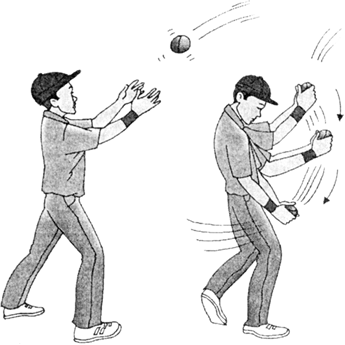
(ii) Chinawares are wrapped in straw paper before packing. The straw paper between the chinawares increases the time of experiencing the jerk during transportation. Hence, they strike against each other with a less force and are less likely to be damaged.
(iii) When we jump on a muddy floor, than on a hard floor we are less hurt. On a muddy floor, the floor is carried in the direction of the jump and the time interval for which force acts is increased. This decreases the rate of change of momentum and hence the force of reaction. Thus, the person is hurt less.
Show that Newton’s first law of motion is contained in the second law.
First law of motion as a special case of second law.
Newton’s first law of motion can be deduced from second law.
![]()
That is,
when F = 0, v = u for whatever time t is taken because m ≠ 0.
This means that the object will continue moving with uniform velocity u throughout the time t. If u is zero then v will also be zero. That is the object will remain at rest. This is the same statement as Newton's law of motion.
Hence first law of motion is contained in the second law.
What is the momentum of a man of mass 75 kg, when he walks with a uniform velocity of 2 m/s?
Here,
Mass of man, m = 75 kg
Man is moving with a uniform velocity, v = 2m/s
Momentum, p = mv
= 75 kg x 2m/s
= 150 kg m/s.
By how much does the momentum of a body of mass 5 kg change when its speed
(i) decreases from 20 m/s to 0.20 m/s; and
(ii) increases from 30 m/s to 40 m/s?
(i) Here,
Mass of the body, m = 5 kg
Initial velocity, u = 20 m/s
Final velocity, v = 0.20 m/s
Change in momentum = m(v - u)
= 5(0.20 - 20) kg m/s
= -99 kg m/s
The negative sign shows that the momentum decreases.
(ii) Here,
Mass, m = 5 kg
Initial velocity, u = 30 m/s
Final velocity, v = 40 m/s
Change in momentum = m(v - u)
=5(40-30)
= 50 kg m/s
Here, the momentum of the body decreases, when it's speed increases.
A man throws a ball of mass 0.5 kg vertically upwards with a velocity of 10 m/s. What will be its initial momentum? What would be its momentum at the highest point of its reach?
Mass of the ball, m = 0.5 kg
Initial velocity, u = 10 m/s
Initial momentum = mu = 0.5 x 10 = 5 kg m/s
At the highest point, velocity of ball is zero.
So, momentum of the ball 0.5 x 0 = 0.
Calculate the force required to produce an acceleration of 5 ms 2 in a body of mass 6 kg.
Here,
Mass of the body, m = 6 kg
Rate of acceleration, a = 5 ms-2
Therefore,
Required force, F = ma
= 6 x 5
= 30 N.
Calculate the mass of the body, when a force of 525 N, produces an acceleration of 3.5 mJs2.
We have,
Force of the body, F = 525 N
Acceleration, a = 3.5 m/s2
Therefore,
Mass of the body, m = F/a
= 525/3.5
= 150 Kg.
What would be the force required to produce an acceleration of 2 m/s2 on a body of mass 12 kg? What would be its acceleration if the force was doubled?
Case I:
Acceleration, a = 2 m/s2
Mass of the body, m = 12 kg
Therefore,
Force , F = ma = 12 x 2 = 24 N.
Case 2:
Mas of the body, m = 12 kg
When force is doubled on the body,
Force acting, F = 48 N
Therefore,
Acceleration, a = F/m = 48/12 = 4m/s2
Which would require a greater force—accelerating a 2 kg mass at 5 ms –2 or a 4 kg mass at 2 ms–2.
Here,
Mass of first body, m1 = 2 kg
Body is accelerating at a rate of, a1 = 5ms-2
Mass of second body, m2 = 4kg
Rate of acceleration, a2 = 2ms-2
Force acting on the first body,
F1 = m1a1 = 2 x 5 = 10 N
Force acting on the second body,
F2 = m2a2 = 4 x 2 = 8 N
Clearly, F1 > F2
Thus, the body which is accelerating at a rate of 5 ms-2 would require a greater force.
What will be acceleration of a body of mass 5 kg if a force of 200 N is applied on it?
Here,
Mass of the body, m = 5 kg
Force acting on the body, F = 200 N
Acceleration of the body is given by, a = F/m
= 200/5
= 40 m/s2.
A bullet of mass 10 g is fired with a rifle. The bullet takes 0.003 s to move through its barrel and leaves it with a velocity of 300 m/s. What is the force exerted on the bullet by the rifle?
Here,
Mass of the bullet, m = 10 g = 0.010 kg
Initial velocity of the bullet, u = 0
Velocity of bullet attained, v = 300 m/s
time taken by the bullet to move through the barrel, t = 0.003 s
Therefore,
Force is given by,
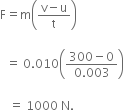
A man pushes a box of mass 50 kg with a force of 80 N. What will be the acceleration of the box due to this force? What would be the acceleration if the mass were halved?
Case 1:
Mass of the body, m = 50 kg
Force acting on the body, F = 80 N

A motorcar is moving with a velocity of 108 km/h and it takes 4 s to stop after the brakes are applied. Calculate the force exerted by the brakes on the motorcar if its mass along with the passengers in the motorcar is 1000 kg.
Here,
Initial velocity of motorcar, u = 108 km h-1
![]()
The brakes are aplied and motorcar comes to rest.
So,
Final velocity= 0
Time taken for the motorcar to stop, t = 4s
MAss of the motorcar, m = 1000 kg
![]() Force,
Force,
![]()
The negative sign shows that the force exerted by the brakes is opposite to the direction of motion of motorcar.
A force of 5 N gives a mass m1 and acceleration of 10 ms–2 and a mass m2 and acceleration of 20 ms–2. What acceleration would it give if both the masses were tied together?
Given,
Force acting on the body, F = 5 N
Acceleration, a = 10 ms-2
So, mass of first body, m1 = ![]()
Rate of acceleartion of body = 20 ms-2
MAss of second body, m2 = ![]() =
= ![]()
When the two masses are tied together, the total mass is,
m = m1+m2 = 0.50 +0.25 = 0.75 kg
Acceleration produced in the combined mass by the force of 5 N is,
a = ![]()
A cricket ball of mass 70 g moving with a velocity of 0.5 m/s is stopped by a player in 0.5 s. What is the force applied by the player to stop the ball?
Given,
Mass of the cricket ball, m = 70 g
Velocity of the ball, u = 0.5 m/s
Final velocity of the ball, v = 0 m/s
Time taken, t = 0.5 secs
Force acting on the ball, F = ![]()
Negative sign shows the retarding nature of the force.
A car of mass 1000 kg moving with a velocity of 45 km/h collides with a tree and comes to a stop in 5 s. What will be the force exerted by the car on the tree?
Here,
Mass of car, m = 1000 kg
Initial velocity, u = 45 km/hr = ![]() m/s
m/s
Final velocity = 0 m/s
Time taken for car to come to a halt = 5 s
Therefore, force is given by
F = ![]()
The negative sign shows the retarding nature of force.
What would be the force required to stop a car of mass 1000 kg and a loaded truck of mass 10000 kg in 2 s if they were moving with same velocity of 5 m/s?

Negative sign in both the cases show the retarding nature of the force.
For how long should a force of 100 N act on a body of mass 20 kg so that it acauires a velocity of 100 m/s?
Given,
Force, F = 100 N
Mass of the body, m = 20 kg
![]() Acceleration is given by,
Acceleration is given by,
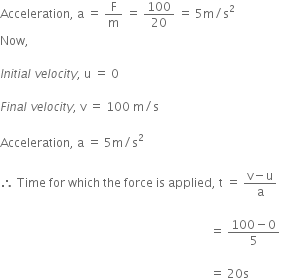
A constant force acts on an object of mass 5 kg for a duration of 2 s. It increases the object’s velocity from 3 ms–1 to 7 ms–1. Find the magnitude of the applied force. Now if the force were applied for a duration of 5 s, what would be the final velocity of the object.
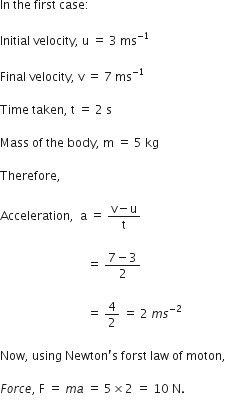
The same force is applied for a duration of 5 s, therefore the acceleration a will remain same.
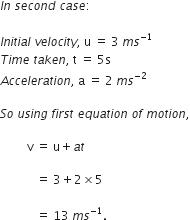
Two blocks made of different metals identical in shape and size are acted upon by equal forces which cause them to slide on a horizontal surface. The acceleration of the second block is found to be 5 times that of the first, what is the ratio of the mass of the second to the first?
And, let their acceleration be 'a' and '5a' be their respective accelerations.

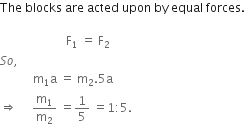
A driver accelerates his car first at the rate of 1.8 m/s2 and then at the rate of 1.2 m/s2. Calculate the ratio of the force exerted by the engine in the two cases.
Initial rate of acceleration = 1.2 m/s2
Rate of acceleration = 1.2 m/s2
Let m be the mass of the car.
Then,
Ratio of the force exerted by the engine is,
![]()
Therefore, the ratio is 3:2.
A man in a circus show jumps from a height of 10 m and is caught by a net spread below him. The net sags down 2 m due to his impact. Find out the average force exerted by the net on the man to stop his fall. Take the mass of the man to be 60 kg and consider the value of acceleration during his free fall as 10 m/s2.
Given, the man jumps from a height of 10 m.
Initial velocity, u = 0
Distance travelled by the mn, s = 10 m
Final velocity, v =?
Acceleration, a = 10 m/s2.
The velocity of the man after he has descended 10 m vertically downward is given by,

Now, the acceleration produced when the net sags by 2m is given by the third equation of motion,
![]()

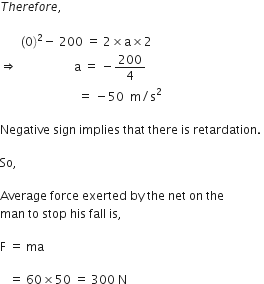
The velocity-time graph of a ball of 20 g moving along a straight line on a long table is given in Fig. 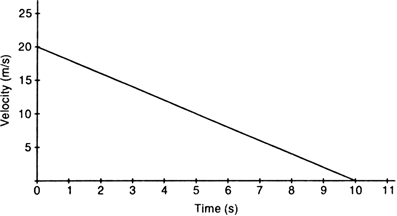
How much force does the table exert on the ball to bring it to rest?
Given,
Mass of the body, m = 20 g = 0.02 kg
From the given graph, we note that
Initial velocity, u = 20 cm/s = 0.20 m/s
Final velocity, v = 0 cm/s
Time taken, t = 10 - 0 = 10s
The force exerted on the ball is,

The negative sign shows that the friction force exerted by the table is opposite to the direction of motion of the ball.
The velocity-time graph of a car is shown in Fig a. The car weighs 1000 kg.
(a) What is the distance travelled by the car in the first two seconds?
(b) What is the braking force applied at the end of 5s to bring the car to a stop within one second?
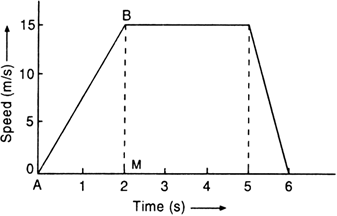
Fig. (a): Velocity-time graph of the car.
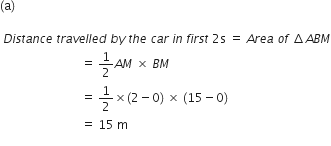
(b) It is clear from the graph that the velocity at the end of 5 s is 15 m/s.
So,
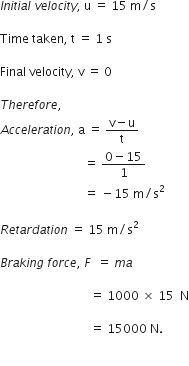
Plot the distance-time graphs for an object which starts from rest, in the following cases:
(a) a = 2 m/s2; and (b) a = 8 m/s2.
A table of distance-time graph is made in both the cases.
In both cases,
Initial velocity, u = 0

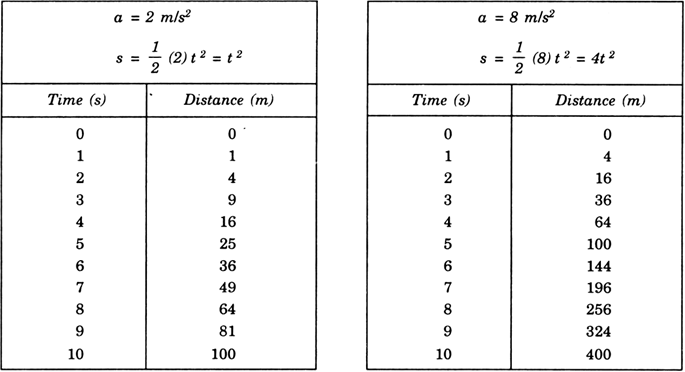
The distance-time graph is as shown in fig. 9.14 and 9.15: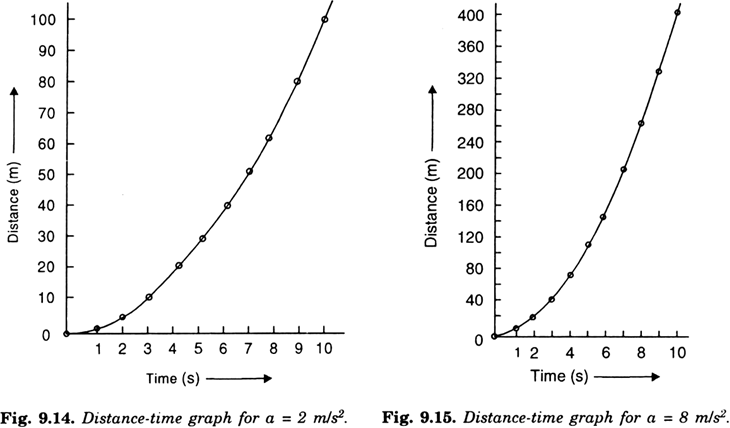
State and explain Newton’ s third law of motion.
Newton’s third law of motion.
According to Newton's third law, to every action, there is an equal and opposite reaction.
When one objects exerts a force (action) on another object, then the second object also exerts a force (reaction) on the first.
These two forces are always equal in magnitude but opposite in direction.
Fig. Action of Newton’s third law.
As shown in fig.,
If ![]() is the force exerted by body A on B and
is the force exerted by body A on B and ![]() is the force exerted by B on A, then according to Newton's third law,
is the force exerted by B on A, then according to Newton's third law,
![]()
We can see that the forces are equal and opposite.
According to the third law of motion, single force can never exist.
The forces always exist in pairs.
The two opposing forces are known as action and reaction forces.
But the forces of action and reaction always act on two different bodies.
Give a simple experiment to demonstrate that action and reaction forces are equal and opposite.
Consider two spring balances connected together.
The fixed end of B is attached to a rigid support as shown in the fig. below.
Fig. Action and reaction forces are equal and opposite.
i) When a force is applied through the free end of spring balance A, it is observed that both the spring balances show the same readings on their scales.
ii) This means that the force (action) exerted by the spring balance A on balance B is equal but opposite in direction to the force (reaction) exerted by the balance B on A. This proves that action and reaction are equal and opposite forces.
Give some examples to illustrate Newton’s third law of motion.
Illustration's of Newton's third Law of motion:
(i) While walking we press the ground with our feet in the backward direction (action), as shown in Fig. 9.18.
The ground exerts an equal and opposite force on us. The horizontal component of this force of reaction enables us to move forward. 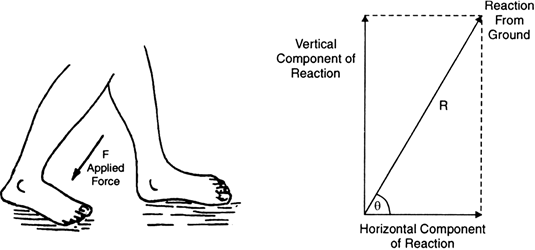
Fig. Action and reaction force acting while we walk on the ground.
(ii) While swimming, a person pushes water with his hands and feet in the backward direction (action). Water pushes the person with an equal force in the forward direction, which is the reaction force.
(iii) When a gun is fired, the exploding gases, which come out because of a chemical reaction, exert a forward force on the bullet. The bullet exerts an equal and opposite reaction force on the gases. This results in the recoil of the gun, as shown in fig. below
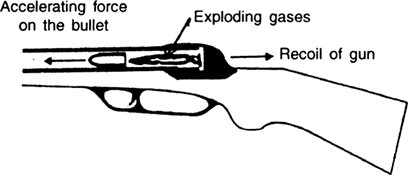
Fig. A forward force on the bullet and recoil of gun.
(iv) When a sailor jumps out of a rowing boat, the boat moves backwards. As the sailor jumps forward, he applies a forward force (action) on boat and the boat moves backwards due to the force of reaction.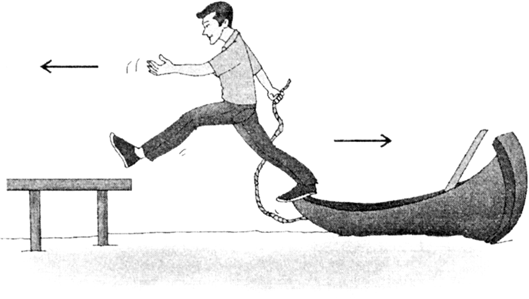
Fig. 9.21. As the sailor jumps in forward direction, the boat moves backwards.
State law of conservation of momentum. Deduce this law from Newton’s second law of motion.
Law of conservation of momentum.
The law states that if a number of bodies are interacting with each other, that is, the bodies are exerting forces on each other, their total momentum remains conserved before and after the interaction, provided there is no external force acting on them.
Derivation using Newton’s second law of motion:
Let p1 and p2 represent the sum of momenta of a group of objects before and after the collision, respectively.
Let t be the time elapsed during the collision.
According to Newton’s second law of motion,
External force = Rate of change of momentum
![]()

Hence, in the absence of an external force, the total momentum of a group of objects remains unchanged or conserved during the collision.
This is the law of conservation of momentum.
Deduce law of conservation of momentum from Newton’s third law of motion.
Consider two bodies A and B of masses mA and mB moving in the same direction along a straight line.
The bodies are moving with velocities uA and uB respectively, such that uA > uB.
They collide for time t.
After collision, let their velocities become v1 and v2.


Now, according to Newton's third law of motion,
The forces are equal and opposite.

That is,
Total momentum before collision = Total momentum after collision.
Thus, total momentum of the two bodies is conserved provided no external force acts on them.
This proves the law of conservation of momentum.
Give some examples to illustrate the law of conservation of momentum.
The law of conservation of momentum can be illustrated using the following examples:
(i) Recoil of the gun
The bullet and the gun, both are at rest before firing and initial momentum of the system is zero. When the bullet is fired, it moves forward with a large velocity, As per the conservation of momentum, the gun must moves backward with a velocity such that the final mometum is zero.
(ii) Flight of rockets and jet engines:
When a rocket is fired, it throws a stream of burnt gases in the vertically downward direction with a large velocity. So, the outgoing gases have large momentum in the downward direction. According to the law of conservation of momentum, the rocket gets an equal and opposite momentum which causes it to fly up.
If action is always equal to the reaction, explain how a horse can pull a cart.
The horse pulls the cart with a force (action) in the forward direction. The cart also pulls the horse with an equal force (reaction) in the backward direction. This way, the two forces get balanced. The horse pushes the ground with its feet in the backward direction, while pulling the cart. So, the reaction of earth makes it move in the forward direction alongwith the cart.
Explain, why is it difficult for a fireman to hold a hose, which ejects large amounts of water at a high velocity.
Water is ejected with a large forward force (action) and due to reaction, the fireman experiences a large backward thrust. Therefore, the force experienced by him makes it difficult in holding the hose.
From a rifle of mass 4 kg, a bullet of mass 50 g is fired with an initial velocity of 35 ms–1. Calculate the initial recoil velocity of the rifle.
Mass of bullet, m1 = 50g = 0.05 kg
Mass of rifle, m2 = 4 kg
Initial velocity of bullet, u1 = 0
Initial velocity of rifle, u2 = 0
Final velocity of rifle, v1 = 35 ms-1
Final velocity of rifle, v2 = ?
According to the law of conservation of momentum,
Total momenta after the fire = Total momenta before the fire.
m1v1+ m2v2 = m1u1+ m2u2
0.05 x 35 + 4v2 = 0+0

The negative sign indicates that the direction in which the pistol would recoil is opposite to that of the bullet.
Two objects of masses 100 g and 200 g are moving in along the same line and direction with velocities of 2 ms–1 and 1 ms–1, respectively. They collide and after the collision, the first object moves at a velocity of 1.67 ms–1. Determine the velocity of the second object?
A bullet of mass 20 g is horizontally fired with a horizontal velocity 150 ms–1 from a pistol of mass 2 kg. What is the recoil velocity of the pistol?
For bullet:
m1 = 20 g = 0.02kg
u1 = 0 m/s
v1 = 150 ms-1
For pistol:
m1 = 2kg
u1 = 0 m/s
v2 = ?
According to the law of conservation of momentum,
Total momenta after the fire = Total momenta before the fire.
That is,
m1v1 + m2v2 = m1u1 + m2u2
0.20 x 150 + 2 x v2 = 0.02 x 0 + 2 x 0
![]() 2v2 = -3
2v2 = -3
![]() v2 = -1.5 ms-1.
v2 = -1.5 ms-1.
Negative sign indicates that the direction in which the pistol would recoil is opposite to that of bullet.
A bullet of mass 10 g moving with a velocity of 400 m/s gets embedded in a freely suspended wooden block of mass 900 g. What is the velocity acquired by the block?
Let the final velocity of the bag along with the bullet embedded in it be v.

Now, According to the law of conservation of momentum,
Total momentum before collision = Total momentum after collision
That is,
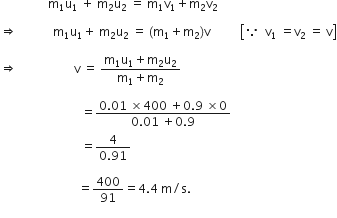
A target of mass 400 g moving with a horizontal speed of 10 m/s is hit by a bullet of mass 0.01 kg moving in opposite direction. If both the bullet and the target come to rest after the collision, calculate the velocity of the bullet at the time of striking the target.
Mass of the target, m1 = 400 g = 0.4 kg
Initial velocity of the target, u1 = 10m/s
Final velocity, v1 =0
Mass of the bullet, m2 = 0.01 kg
Initial velocity of the bullet, u2 = ?
Final velocity, v2 =0
According to the law of conservation of momentum,
m1u1 + m2u2 = m1v1 + m2v2
0.4 x 10 + 0.01 x u2 = 0 + 0
![]()
Negative sign shows that the bullet is moving in a direction opposite to that of the motion of target.
A girl of mass 40 kg jumps with a horizontal velocity of 5 ms–1 onto a stationary cart with frictionless wheels. The mass of the cart is 3 kg. What is her velocity as the cart starts moving? Assume that there is no external unbalanced force working in horizontal direction.
Let v be the velocity of the girl on the cart as the cart starts moving.
The total momenta of the girl and cart before the interaction,
p = 40 kg x 5 ms-1 + 3 kg x 0 ms-1
= 200 kg ms-1
The total momenta after the interaction is,
p' = (40 + 3) kg x v ms-1 = 43 v kg m s-1
According to the law of conservation of momentum, the total momentum is conserved during the interaction.
Therefore,
43 v = 200
![]() v = 200/43
v = 200/43
= +4.65 ms-1
The girl on cart would move with a velocity of 4.65 ms–1 in the direction in which the girl jumped onto the cart.
Two hockey players of opposite teams, while trying to hit a hockey ball in the ground collide and immediately become entangled. One has a mass of 60 kg and is moving with velocity 5.0 ms–1 while the other has a mass of 55 kg and is moving faster with velocity 6.0 ms–1 towards the first player. In which direction and what velocity will they move after they become entangled ? Assume that the frictional force acting between the feet of the two players and ground is negligible.
Consider the first hockey player be moving from left to right.
Using sign convention the left to right is taken as positive direction and thus right to left is negative direction.
Let 'm' and 'u' represent the mass and initial velocity of the two players, respectively.
Then
Mass of the 1st palyer, m1 = 60 kg
Velocity, u1 = 5 ms-1
Mass of 2nd player, m2 = 55 kg
Velocity, u2 =-6 ms-1.
The total momentum of the two players before the collision,
= 60 kg x (5 ms-1) + 55 kg x (-6 ms-1)
= -30 kg ms-1
If v is the velocity of the two entangled players after the collision then the total momentum is,
= (m1 + m2) x v
= (60 + 55) kg x v ms-1
= 115 x v ms-1
Acc, to the law of conservation of momentum, we have,
115 x v = -30
![]() v = -30/115
v = -30/115
= -0.26 ms-1
Thus the two entangled players would move with a velocity 0.26 ms–1 from right to left, that is in the direction the second player was moving before the collision.
Define the term force.
Force is a push or pull which tends to change the state of rest or direction of uniform motion uniform motion along a straight line.
Is force a scalar or a vector quantity?
Force acts in a particular direction. So, it is a vector quantity.
What does balanced force cause?
Balanced forces are the forces which are equal in size and opposite in direction. Balanced forces do not cause any change in motion.
What is the cause of unbalanced forces on a body ?
Unbalanced forces change or tend to change the state of rest or of uniform motion of a body. Unbalnced forces vary in size and may not be in opposite direction.
Can the velocity of a body change when no unbalanced force is acting on it?
No. The velocity would remain constant.
Which scientist proved first that objects move with constant speed when no forces act on them?
Galileo Galilei
State Galileo’s law of inertia.
Galileo's law of inertia states that the body moving in a straight line with a certain speed will continue moving in the same straight line with the same speed in the absence of external force.
What do you mean by inertia?
The inherent property or tendency of a body to resist or oppose any change in its state of rest or of uniform motion in a straight line is called inertia.
Why do bodies of small mass require small initial effort to bring them into motion?
The mass of a body and inertia are directly related to each other. Smaller the mass, lesser is the opposition to the change of state of motion.
Define the term inertia with respect to motion.
Inertia of motion is the tendency of a body to remain in its state of uniform motion.
State Newton’s first law of motion.
An object remains in a state of rest or of uniform motion in a straight line unless compelled to change that state by an applied force.
Which law of motion is also called ‘law of inertia’?
Newton’s first law of motion is also called 'law of inertia'.
Can a body in linear motion be in equilibrium?
Yes, a body in linear motion can be in equilibrium provided the vector sum of the forces acting upon the body is zero.
A body is acted upon by a number of external forces. Can it remain at rest?
If the vector sum of all the external forces is zero, then the body will remain at rest.
If a body is not at rest, the net external force acting on it cannot be zero. Is it true or false?
When a body is moving with a constant velocity, the net external force acting on the body is zero.
A kite is skilfully held stationary in the sky. Give the magnitude and the direction of the force acting on it?
It is given that a kite is held stationary on the sky. That is, no net force is acting on it. The force exerted by air on the kite is balanced by tension produced in the string.
Give the magnitude and direction of force acting on a small water drop falling down with constant velocity?
The water drop is falling with constant velocity. Therefore, no net force acts on it.
If you jerk a piece of a paper placed under a book very quickly, the book will not move. Why?
When a piece of paper placed under a book is moved quickly, the books will not move. This is because the book continues to be in it's state of rest due to inertia.
What happens to a stone tied to the end of a string and whirled in a circle if the string suddenly breaks?
A stone tied to the end of a string is whirled and suddenly the string breaks. The stone flies off tangentially along a straight line due to inertia of direction.
Define momentum of body.
Momentum of a body is the quantity of motion possessed by a body and is equal to the product of the mass and velocity of the body.
Is momentum a scalar or a vector quantity?
Momentum is a vector quantity and has the same direction as that of velocity.
What is the name given to the product of mass and velocity of a body?
Momentum gives us the product of mass and velocity.
Momentum, p =
State Newton’s second law of motion.
Newton's second law of motion states that the rate of change of momentum of an object is proportional to the applied unbalanced force in the direction of force.
Which physical quantity corresponds to the rate of change of momentum?
Force gives us the measure of rate of change of momentum.
Force, F =
where, p is the mometum.
Define one newton force.
One newton force is that force which produces an acceleration of 1 m/s2 in a body of mass 1 kg.
What is the relationship between force and acceleration?
Acceleration produced in a body by an unbalanced force is directly proportional to the force.
According to the first law of motion,
F = ma
What is the relationship between force and mass?
The force acting on a body is directly related to the mass of the body.
F m
That is, massive the object of a body, more force is to be applied on the body.
State the relation between force and momentum.
Force is defined as the rate of change of momentum.
That is,
F =
where, is the change of momentum with respect to time.
State Newton’s third law of motion.
Newton’s third law of motion states that action and reaction are equal and opposite and they act on different bodies.
Do action and reaction act on the same body or on different bodies?
Action and reaction, both act on different bodies.
State the law of conservation of momentum.
The law of conservation of momentum states that the sum of momenta of the two objects before collision is equal to the sum of momenta after the collision provided there is no external unbalanced force acting on them.
A body at rest explodes into pieces which fly away in all directions. What is the total momentum of all the pieces immediately after explosion?
The total momentum of all pieces immediately after explosion is Zero.
If two bodies collide in the absence of any external force, what will be the total change in the momentum of the system?
Collision of two bodies in the absence of any external force is zero. the total momentum of the system has to bec onserved.
What is the total momentum of the cannon and shell
(i) before firing; and (ii) after firing?
(i) The total momentum of both canon and shell before firing is zero, because both are at rest.
(ii) According to the law of conservation of momentum, total momentum of the cannon and shell after firing is also zero.
Since action and reaction forces are always equal in magnitude and opposite in direction, how can anything ever be accelerated?
Action and reaction forces are always equal in magnitude and opposite in direction. But, the action and reaction forces always act on different bodies.
Name the principle on which a rocket works.
The working of rocket is based on the principle of third laws of motion.
For the rocket to move forward, the exhaust gases fire backwards, against which the the atmosphere gives an equal push back, which thrusts the rocket forward.
Why are heavy loads moved by placing them on rollers?
Rollers are used for moving heavy loads because rolling friction is less than sliding friction.
Why are tyres corrugated and made rough?
Tyres are corrugated and made rough so as to increase the friction and provide better grip on the road. This avoids circumstances of slipping on the road.
A heavy trunk is lying on the floor. A boy applies a force of 100 N to pull it, but fails. Then a man pulls it by a force of 300 N, but fails. Then an athlete applies a force of 600 N and is able to pull it. What force does it prevent from moving in the first two cases ? What conclusions can you draw about the force from these three observations?
Given, that the trunk is very heavy. So, the force of friction between the trunk and the floor prevents the motion in the first two cases.
So, the force of friction is greater than 300 N but less than 600 N.
Why does Newton’s first law of motion appear to be contradicted in our day-to-day life?
In our daily practical life, we have observed that when we apply external force on a moving body, it covers some distance before it stops. This is in contradiction to Newton’s first law.
However, the motion of the body is being opposed by force of friction between the body and the ground and also by air resistance. In the absence of such forces, the body would continue to move on its own.
A passenger sitting loosely in a bus falls backward when the bus suddenly starts moving, why?
The bus which was at rest, when suddenly starts moving, the lower part of the passenger’s body begins to move along with the bus. But, the upper part tends to remain at rest due to inertia of rest. This is the reason, a passenger standing or sitting loosely in a bus falls backward when the bus suddenly starts moving.
A man jumping out of a moving train falls with his head forward. Why?
When a man jumps out of a moving train, his feet suddenly comes to rest on touching the ground. But, the upper part of the body continues to be in motion and has a tendancy to move forward. That is why the person falls with his head forward.
In order to save himself from falling headlong, the person should run through some distance in the forward direction.
Why is it that an athlete always runs some distance before taking a jump?
An athlete always runs for some distance before taking a jump so that inertia of motion may help him in his muscular efforts to take a longer jump.
If a ball is thrown up in a moving train, it comes back to the person’s hands, why?
When a ball is thrown up in a moving train, there is no horizontal force acting on it. So, the ball comes back to the person as it moves with the same horizontal speed.
A bullet fired against a window glass pane makes a hole in it and the glass pane is not cracked. On the other hand, a stone striking the same glass pane will smash it. Explain why?
When a bullet is fired and hits the glass, the part of the glass which comes in contact with the bullet immediately has a tendency to share the large velocity of bullet. This way it makes a hole while the remaining part of the glass due to inertia of rest remains at rest. Hence, the glass pane is not smashed.
When a stone with low velocity strikes the glass, the surrounding part of the glass takes time to share the velocity of the stone. Thus the glass is smashed.
Why do the blades of an electric fan continue to rotate for some time after the current is switched off ?
Why are the passengers thrown outwards when a car in which they are travelling suddenly takes a circular turn?
The passemgers are thrown outwards when a car in which they are travelling suddenly takes a circular turn because the passengers tend to maintain their direction of motion (inertia of direction) while the direction of car changes when it takes the turn.
What happens when you shake a wet piece of cloth? Explain your observation.
When we shake a wet piece of cloth, water molecules come out of it. On shaking, the cloth comes into motion while water molecules tend to remain at rest due the the property of inertia of rest and get detached.
A javelin throw is marked foul if the athlete crosses over the line marked for the throw.
Explain, why athletes often fail to stop themselves before that line?
The athletes who throw the javelin fails to stop themselves before the line due to inertia of motion. So, an athlete may cross the marked line before throwing the javelin.
Two similar trucks are moving with the same velocity on a road. One of them is loaded while the other is empty. Which of the two will require a larger force to stop it?
Loaded truck has more inertia of motion or greater momentum than the empty truck. So more force is required to stop the loaded truck than the empty truck.
Why are the wheels of vehicles are provided with mudguards?
The mud sticking to the wheel from the road flies off tangentially, when the wheel rotates at a high speed because of inertia of direction. In order that the flying mud does not spoil the clothes of passerby, the wheels are provided with mudguard.
Explain the meaning of the following equation in mechanics:
F = ma, where symbols have their usual meanings.
The equation, F = ma means that the force F on an object is equal to the product of its mass m and acceleration a.
The mathematical expression depicts Newton’s second law of motion.
Explain how Newton’s first law of motion is a special case of second law?
According to Newton’s second law,
F = ma
Since, mass of a body cannot be zero therefore, when when force is equal to zero, acceleration is also zero. So, there wont be any change in the velocity of the body.
So, in the absence of any external force, a body will continue to remain in its state of rest or of uniform motion in a straight line. This is Newton’s first law of motion.
So, Newton’s first law of motion is contained in the second law.
A cricket player lowers his hand while catching a ball. Explain?
The player increases the time of catching the ball, by lowering his hand. Therefore, the rate of change of momentum is small and the force exerted on his hand is less. So, the person is less likely to get hurt.
In oil tankers some space is left at the top while filling them. Explain, why?
During transportation, the oil may rise up due to sudden jerks. If some space is left, the oil will take some time to reach the top of the tanker and hence it will exert less force on the tanker. This will prevent the damage caused by overflowing of the oil.
Chinawares are wrapped in straw paper before packing?
The straw paper between the chinawares increases the time of experiencing the jerk during transportation. Hence, they strike against each other with less force and are less likely to broken.
Why we are hurt less when we jump on a muddy floor in comparison to a hard floor?
A sandbed is motioned in the direction of the athlete when he jumps and the time interval is increased. This decreases rate of change of momentum. Hence, the force of reaction is decreased. So, the person who is jumping do not get hurt.
Why are shockers used in cars, scooters and motorcycles?
Shockers are used in cars, scooters and motorcycles so that the time interval of the jerk increases. so, the rate of momentum decreases. Hence, comparitively a lesser force is exerted on the passengers during the jerk.
Why are buffers provided between the bogies of a railway train?
Boggies are the carriages which are connected with each other. Use of buffers increase the time interval of jerks during shunting. This reduces the force with which bogies push or pull each other. Hence, this way severe jerks are avoided.
A brick can be pushed gently on the smooth floor by applying force with our foot. But if we kick the brick, the foot is hurt. Why?
When a brick is kicked by a person, time for which the force imparted is short. Therefore, rate of change of momentum of the brick is large. So, a large reaction force is applied back by the brick on the foot.
So, force may hurt our foot.
Why is it necessary to bend knees while jumping from greater height?
When the knees are bent slowly, the value of time of impact increases and less force acts on feet.
Therefore, the probability of getting injured is less.
How does a karate player break a pile of tiles or slab of ice with a single blow?
When the karate player strikes the pile or slab fast, the entire momentum of the hands reduces to zero in a very short span of time. Therefore, the force exerted on the ice slab or pile of tiles is large enough to break it.
A boxer moves his head backward to protect himself from the attack of his rival. Why?
The boxer gets more time before being attacked by his opponent, on moving his head backward. Thus, this reduces the effect of the punch.
Why are seat belts provided in automobiles and aeroplanes?
When the vehicle suddenly moves, it results in a sudden state of motion of the vehicle. Hence, our feet which is in contact with the vehicle comes to motion. but, the upper part of our body which is at rest, tends to remain at rest due to the property of inertia of rest.
Therefore, Seat belts are provided to protect the passengers from falling backward or forward during such situations.
If someone jumps to the shore from a boat, the boat moves in opposite direction. Explain, why.
When a man jumps out from a boat, he presses the boat with his feet (action), and the boat also exerts an equal force on him in the opposite direction (reaction). As a result, the man jumps to the bank and the boat moves in the backward direction.
A book rests on a table:
(i) Show the forces on the table and the corresponding reaction forces.
(ii) Why do not the forces acting on the table cause it to move?
(i) The action and reaction forces have been shown in Fig. below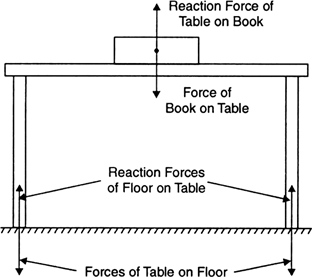
(ii) The sum of all the forces acting on the table is zero. So there is no net force acting on it. Thus, the table will not move.
Indicate the forces of action and reaction in the following cases:
(i) a man standing on the ground;
(ii) a stone suspended by a thread from the ceiling;
(iii) a book lying on the table;
(iv) motion of moon around the earth; and
(v) when a magnet attracts a piece of iron.
(i) A man standing on the ground:
The action force is when the man exerts a downward force equal to his weight on the ground. And, as a reaction, the ground exerts an equal upward force on the man.
(ii) A stone suspended by a thread from the ceiling:
The weight of the stone acts vertically downwards (action). A tension equal to the weight of the stone acts vertically upwards in the thread.
(iii) A book lying on the table:
The book exerts a downward force equal to its weight on the table (action). The table exerts an equal force on the book in the upward direction (reaction).
(iv) Motion of moon around the earth:
The moon attracts the earth with some force (action). The earth also attracts the moon with an equal and opposite force (reaction). Hence, it kees orbiting around the Earh.
(v) When a magnet attracts a piece of iron:
When a magnet and a piece of iron are brought closer to each other, the magnet attracts the iron piece with a certain force (action). The iron piece also attracts the magnet with an equal and the opposite force (reaction).
Do action and reaction act on the same body or on different bodies? How are they related in magnitude and direction? Are they simultaneous or not?
Action and reaction always acts on different bodies. Both the forces are equal in magnitude but act in opposite directions. Action and reaction forces are both simultaneous and reaction appear as long as there is action.
Why we can’t walk with our legs kept perpendicular to the ground?
Therefore, we always have to push the ground by exerting a force with our legs slanting backwards. The reaction of the ground makes us move forward.
A horse cannot pull a cart and run in empty space?
A horse is pulling a cart.
(i) What is the force that causes the horse to move forward?
(ii) What is the force that causes the cart to move forward?
(i) The reaction force of the ground on the feet of the horse, causes the horse to move forward.
(ii) The force which the horse exerts on the cart, causes the cart to move forward.
A gun recoils on firing. Why?
When a bullet is fired from the gun with some force in the forward direction (action), the bullet in turn exerts an equal and opposite force on the gun. The reaction force by the bullet causes the gun to recoil.
When a boatman wants to go away from the bank, he pushes the bank with a pole. Why?
When a boatman wants to go away from the bank, he pushes the bank with a pole (action). The bank in turn, pushes away the boat with an equal and opposite force (reaction).
This helps the boatman to move.
When a balloon filled with air with its untied mouth, directing downwards, is released, it moves upwards. Why?
While swimming, a person pushes the water backward. Why?
A person pushes the water with his hands in the backward direction while swimming. In turn, water in the pool, pushes him forward due to the reaction force.
Why is it difficult to drive a nail into a wooden block without supporting it?
The end of the nail is pointed and it needs to be supported. If not given a proper support, the nail will fall and will be unable to offer suitable reaction force.
Why it is difficult to climb up a greasy pole?
When a person climbs up a pole, he presses the pole downward with his feet. The pole, in turn, pushes the person upwards with an equal force.
If the pole is greasy, its surface becomes slippery and the person is not able to press it. As there is no action, there will be no reaction.
Hence it becomes difficult for the person to climb up.
A man is at rest in the middle of a pond on perfectly frictionless ice. How can he get himself to the shore?
Given, a man is at rest in the middle of a pond on perfectly frictionless ice. If the man wants to move himself to the shore, the man must throw away his shirt in a direction opposite to the desired direction of motion.
Can a sailboat be propelled by air blown at the sails from a fan attached to the boat?
From Newton’s second law, a body can be accelerated when some external force is applied over the body. A fan, blowing air, attached to the boat is a part of the boat and not an external agent. Therefore, the motion of the boat cannot be propelled.
When a body falls to the earth, the earth also moves up to meet it. But the earth’s motion is not noticeable. Why?
Acceleration is the ratio of applied force to the mass of the body. Since, the earth is a massive body, therefore its acceleration is very small.
Therefore, the movement of the Earth is negligibe and hardly noticeable.
Vehicles stop on applying brakes. Does this phenomenon violate the principle of conservation of momentum?
The stopping of vehicles when brakes are applied does not violate the law of conservation of momentum because an external force is acting on the system.
What is sound and how is it produced?
Sound is a form of energy. Sound is produced due to vibration of different objects thus, produces a sensation of hearing in our ears.
Describe with the help of a diagram, how compressions and rarefactions are produced in air near a source of sound.
i) Sound travels through air in the form of longitudinal waves.
ii) Consider a vibrating tuning fork producing sound waves as shown in Fig.
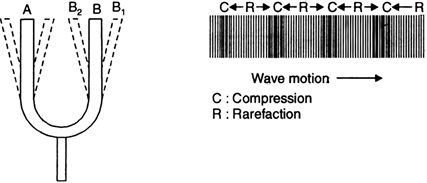
Fig. Tuning fork producing sound waves in air.
iii) The prongs of the tuning fork first move inward and then outwards and so on.
iv) Now, focusing our attention on prong B only, we will see that this prong moves from B to B1 and it compresses the layer of air in front of it.
v) As this compressed layer moves forward, it compresses the next layer and so on. So a wave of compression moves forward. When the prong moves backward from B1 to B2, the pressure of air in the adjoining layer decreases.
vi) The next layer, being at higher pressure tends to move it towards right and so on. So a wave of rarefaction moves forward.
vii) The vibrating tuning fork continues to send a series of compressions and rarefactions.
Cite an experiment to show that sound needs a material medium for its propagation.
Sound is a mechanical wave which needs a material medium to travel.
It can travel through air, water, steel, etc. but cannot travel through vacuum. This can be demonstrated by the following simple experiment.
Experiment:
i) Suspend an electric bell inside a glass bell jar by passing the connecting wires through an airtight cork fitted at the mouth of the jar.
ii) Place the jar over a disc which has a pipe connected to a vacuum pump.
iii) When we turn on the switch, we hear the sound of the bell.
iv) Now, we pump out the air from the jar gradually with the help of the vacuum pump. The sound becomes fainter.
v) When most of the air has been removed, we hear a very feeble sound.
vi) When there is air inside the jar, sound travels through it to the wall of the jar. This makes the wall to vibrate which in turn, sends sound to us.
vii) When air is removed, sound from the bell cannot travel to the wall of the jar.
Hence, the sound needs a material medium for it's propagation.
Why is sound wave called a longitudinal wave?
Longitudnal waves travel in the form of compression and rarefactions. In the waves the individual particles of the medium move in a direction parallel to the direction of the propagation of the distirbance. The particles do not move from one place to another but they simply oscillate back and forth about their position of rest. This is exactly how a sound wave propagates. Hence, sound waves are longitudnal waves.
Which characteristic of the sound helps you to identify your friend by his voice while sitting with others in a dark room?
The characteristic of the sound that will help us to identify our friend's voice is timbre. The quality or timber of sound is that characteristic which enables us to distinguish one sound from another having the same pitch and loudness.
Tips: -
The quality or timber of sound is the characteristic which helps us to identify our friend’s voice.
Flash and thunder are produced simultaneously. But thunder is heard a few seconds after the flash is seen, why?
The speed of sound which is equal to 344 ms–1 is much smaller than the speed of light, equal to 3 x 108 ms–1. Therefore, thunder is heard a few seconds after the lightning flash is seen.
Flash and thunder are produced simultaneously. But thunder is heard a few seconds after the flash is seen, why?
The speed of sound (344 ms–1) is much smaller than the speed of light (3 x 108 ms–1).
Therefore, thunder is heard a few seconds after the flash is seen.
Two children are at opposite ends of an aluminium rod. One strikes the end of the rod with a stone. Find the ratio of times taken by the sound wave in air and in aluminium to reach the second child.
Let, length of the aluminium rod = 'd' metre
Speed of sound in air = 344 ms-1
Time taken by sound in air to reach the child, t(air) = sec
Speed of sound in aluminium = 6420 ms-1
Time taken by sound in aluminium rod to reach the child, t (aluminium) =
Ratio of times taken by sound wave in air to aluminium is given by,
The frequency of a source of sound is 100 Hz. How many times does it vibrate in a minute?
Frequency of the source = 100 Hz = 100 s-1
That is,
Number of vibrations in 1 s = 100
So,
Number of vibrations in 1 minute or 60 s = 100 x 60 = 6000
Does sound follow the same laws of reflection as light does? Explain.
The laws of reflection followed by sound is same as that of light.
i) The directions in which sound is incident and reflected make equal angles with the normal to the reflecting surface.
ii) Angle of incidence, Angle of reflection and normal all the three lie in the same plane of incidence.
When a sound is reflected from a distant object, an echo is produced. Let the distance between the reflecting surface and the source of sound production remains the same. Do you hear echo sound on a hotter day?
The speed of sound is proportional to temperature. As the temperature increases, the speed of sound also increases. So, the reflected sound returns to source earlier than 0.1 s. Hence, a distinct echo cannot be heard.
Give two practical applications of reflection of sound waves.
Two practical applications of reflection of sound waves are:
(i) In a stethoscope, the sound of a patient’s heartbeat is guided along the tube of the stethoscope to the doctor’s ears by multiple reflections of sound.
(ii) Reflection of sound plays an important role in the designing of concert halls.
A stone is dropped from the top of a tower 500 m high into a pond of water at the base of the tower. When is the splash heard at the top? Given, g = 10 ms–2 and speed of sound = 340 ms–1.
First, we find the time taken by the stone to reach the base of the tower.
We use the relation,
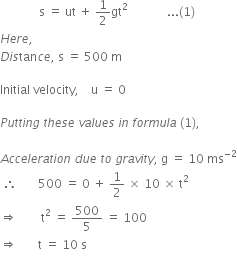
Time taken by sound to travel from base of the tower to its top,
![]()
![]()
A sound wave travels at a speed of 339 ms–1. If its wavelength is 1.5 cm, what is the frequency of the wave? Will it be audible?

This frequency is higher than 20,000 Hz, so it is not audible.
What is reverberation? How can it be reduced?
The repeated reflection that results in this persistence of sound is called reverberation. A sound created in a big hall will persist by repeated reflection from the walls until it is reduced to a value where it is no longer audible.
Reverberation can be reduced by following methods:
(i) By covering the walls and roof of the halls with sound absorbing materials.
(ii) By providing heavy curtains with folds, so that reflection of the sound is avoided.
What is loudness of sound ? What factors does it depend on?
Loudness is a physiological response of the ear to the intensity of sound. Even if the intensity of the two sound waves are same, the loudness of the two would differ.
Loudness depends on two factors:
(i)Intensity of sound, which is directly proportional to the square of amplitude of the sound wave.
(ii)Sensitivity of the ear.
Explain how bats use ultrasound to catch a prey.
i) Bats can produce and receive ultrasonic waves.
ii) During its flight, a bat emits ultrasonic waves. The bat receives back these waves after being reflected by the obstacle in its path.
iii) The bat gets information where the obstacle or prey is and what is its size, because of the nature of these waves. 
Fig. Ultrasound is emitted by a bat and it is reflected back by the prey.
Porpoises also use ultrasound for navigation and location of food even in total darkness.
Explain how bats use ultrasound to catch a prey.
Bats search out prey and fly in dark night by emitting and detecting reflections of ultrasonic waves. The high-pitched ultrasonic squeaks of the bat are reflected from the obstacles or prey and returned to bat’s ear. The nature of reflections tells the bat where the obstacle or prey is and what it is like.
Explain the working and application of a sonar.
The acronym SONAR stands for Sound Navigation and Ranging.
Sonar is a device that uses ultrasonic waves to measure the distance, direction and speed of underwater objects.
Principle: It uses the phenomenon of echoes in determining the sea-depth and locating the presence of under-water objects.
Working:
i) Sonar consists of a transmitter and a detector and is installed in a boat or a ship.
ii) The transmitter produces and transmits strong ultrasonic waves.
iii) These waves travel through the water and after striking the object the beam is reflected from the seabed and is received by an under-water detector which is also mounted on the ship.
iv) The detector converts the ultrasonic waves into electrical signals which are appropriately interpreted.
v) The time interval between transmission and reception of the ultrasonic signal is noted.
The SONAR method is also called echo ranging. This technique is used to determine the depth of the sea and to locate underwater hills, valleys, submarine, icebergs, sunken ship etc.
A sonar device on a submarine sends out a signal and receives an echo 5 s later. Calculate the speed of sound in water if the distance of the device from the submarine is 3625 m.
Given,
Time between transmission and echo, t = 5 s
Distance of the sonar from the submarine, d = 3625 m
Total distance covered by sound = 2d = 2 x 3625 = 7250 m
Therefore,
Speed of sound , v = = = 1450 m/s
Explain how defects in a metal block can be detected using ultrasound.
Ultrasound is generally used to clean parts located in hard-to-reach places, for example, spiral tube, odd shaped parts, electronic components etc. Objects to be cleaned are placed in a cleaning solution and ultrasonic waves are sent into the solution. Due to the high frequency, the particles of dust, grease and dirt get detached and drop out. The objects thus get thoroughly cleaned.
Explain how the human ear works.
i) Human ear is a highly sensitive part of the human body which enables us to hear a sound.
ii) It converts the pressure variations in air with audible frequencies into electric signals which travel to the brain via the auditory nerve.
iii) The human ear has three main parts. Their auditory functions are as follows: 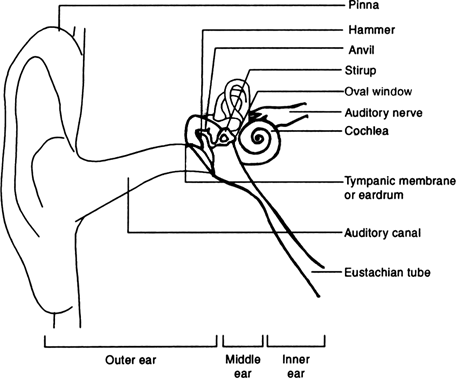
Fig. 12.27. Auditory parts of the human ear
1. Outer ear: The outer ear is called ‘pinna’. It collects the sound from the surrounding. The collected sound passes through the auditory canal. At the end of the auditory canal there is a thin membrane called the ear drum or tympanic membrane.
When compression of the medium produced due to vibration of the object reaches the ear drum, the pressure on the outside of the membrane increases and forces the eardrum inward. Similarly, the eardrum moves outward when a rarefaction reaches. In this way the ear drum vibrates.
2. Middle ear: The vibrations are amplified several times by three bones (the hammer, anvil and stirrup) in the middle ear which act as levers. The middle ear transmits the amplified pressure variations received from the sound wave to the inner ear.
3. Inner ear: In the inner ear, the pressure variations are turned into electrical signals by the cochlea. These electrical signals are sent to the brain via the auditory nerve, and the brain interprets them as sound.
In a slinky (i.e., a long spring) which of the following types of waves can be generated?
longitudinal only
transverse only
both longitudinal and transverse
standing only
C.
both longitudinal and transverse
In a transverse wave, the individual particles of the medium move
in circle
in ellipses
parallel in the direction of travel
perpendicular to the direction of travel
D.
perpendicular to the direction of travel
The reciprocal of frequency is
amplitude
wavelength
time-period
wave velocity.
C.
time-period
What is the nature of the ocean waves in deep water?
transverse
longitudinal
both transverse and longitudinal
None of these
C.
both transverse and longitudinal
Define periodic motion. Give examples.
When the motion of a body repeats itself regularly after a fixed interval of time, the motion is called a periodic motion.
Some examples of periodic motion are:
(i) Motion of a planet around the sun.
(ii) Motion of the hands of a clock.
(iii) Motion of a ball bering rotated in a circle at the end of a string.
Define oscillatory motion. Give examples.
When a body moves to and fro repeatedly about a fixed position, called it's mean position, the motion is said to be oscillatory or vibratory motion.
Examples of oscillatory motion are:
(i) Motion of the pendulum of a wall clock.
(ii) Motion of a mass attached to a spring.
(iii) Motion of a swing.
Can a motion be periodic but not oscillatory?
Yes, a motion can be periodic and not oscillatory.
For example, uniform circular motion is periodic but not oscillatory.
Motion of the earth about its axis is periodic but not oscillatory. Justify.
Motion of the earth about its axis is periodic because earth takes 24 hours to complete its rotation about its axis. But the motion is not a to and fro motion, hence it is not oscillatory.
Define the term oscillation or vibration.
The back and forth motion of a vibrating body around it's mean position is called an oscillation or vibration.
Example: We say that the pendulum of a clock is oscillating.
Define the terms time period and frequency of an oscillating body. Give their units and write the relation between them.
Time period: The time taken by an oscillating body to complete one oscillation is called its time period.
It is denoted by T.
SI unit of time period is second (s).
Frequency: The number of oscillations or vibrations completed by an oscillating body in one second is called its frequency.
Frequency is symbolically denoted by v (Greek letter nu).
SI unit of frequency = per socond (s-1)
= cycles per second (cps)
= hertz |(Hz.)
Relation between time period and frequency:
Let T be the time period of an oscillating body.
Then number of oscillations completed in T second = 1
So, number of oscillations completed in 1 second =
But frequecny() is the number of oscillations completed in 1 second.
Therefore, =
Hence, number of oscillations is equal to the recoprocal of time period.
Define the terms wave and wave motion. Explain the formation of waves with the help of an example.
Wave: The repeated vibrations of the particles of the medium, creates a disturbance which travels through a medium is called a wave. The disturbance moves from one particle to the next particle.
Wave motion: The motion of the disturbance is called wave motion.
Let us look at the wave formation using an example.
When we drop a pebble into a pond of still water, a circular pattern of alternate crests and troughs spreads out from the point where the pebble strikes the water surface. The particle oscillates as a result of kinetic energy of the pebble. The oscillating particles, in turn, transfer energy to the particles of next layer which also begin to oscillate. Energy is further transferred to the next layer of particle. This way energy is transferred from one particle to another particle.
State some important characteristics of wave motion.
Characteristics of wave motion are:
(i) Wave is the propagation of disturbance in the forward direction through the medium. The particles of the medium, merely vibrate about their mean positions.
(ii) Each particle receives vibrations a little later than its preceding particle.
(iii) Velocity of the wave is different from the velocity of the particles with which they vibrate about their mean positions.
(iv) The wave velocity remains constant in a given medium while the particle velocity changes continuously during its vibration about mean position.
What are mechanical waves? Give examples.
The waves which require a material medium for their propagation are called mechanical waves. The propagation of mechanical waves depend upon the elastic propertie so the medium. Hence, they are also called elastic waves.
Examples of mechanical waves :
(i) Sound waves in air.
(ii) Waves over water surface.
(iii) Waves produced during earthquake also, known as seismic waves.
What are electromagnetic waves? Give examples.
The waves which do not require a material medium for their propagation are called electromagnetic waves. Such waves travel through vacuum with a speed of 3 x 108 m/s.
Examples of electromagnetic waves :
(i) Light waves
(ii) X-rays
(iii) Radiowaves
(iv) Microwaves.
Mention the important properties which a medium must possess for the propagation of mechanical waves through it?
Essential properties of a medium for the propagation of mechanical waves:
(i) Elasticity: For the particles to return to their mean positions after being disturbed, the medium must possess elasticity.
(ii) Inertia: The medium must possess inertia or mass so that particles can store kinetic energy.
(iii) Minimum friction: The medium should have minimum frictional force between its particles so that they can continue oscillating for a sufficiently long time.
What are transverse waves? Explain with an example.
Transverse waves are the waves in which particles of the medium vibrate in a direction perpendicular to the direction of wave motion.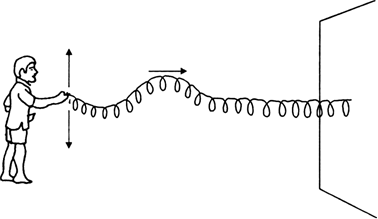
Fig. 12.2 (a). Pulse in a slinky.
i) As shown in the fig. above, take a long slinky and attach it to a wall at its one end.
ii) Give the other end an upward jerk. An upward hump is created in the slinky which travels along the slinky towards the fixed end. Such a sudden disturbance that lasts for short duration is called a pulse.
iii) As shown in Fig. 12.2, if we continuously give up and down jerks to the free end of the slinky, a number of waves begin to travel along the slinky forming a wave train.
iv) Each part of the slinky vibrates up and down while the waves travel along the rope. So the waves in the rope are transverse in nature.
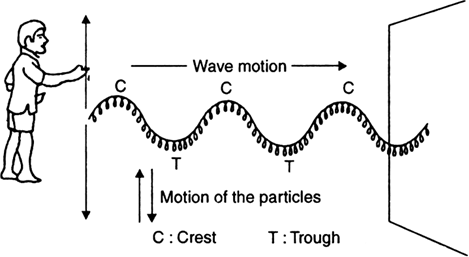
Fig. 12.2 (b). Formation of transverse waves in a slinky.
What are longitudinal waves? Explain with an example.
Longitudinal waves:
The waves in which particles of the medium vibrate along the direction of wave motion are called longitudnal motion.
As shown in Fig. below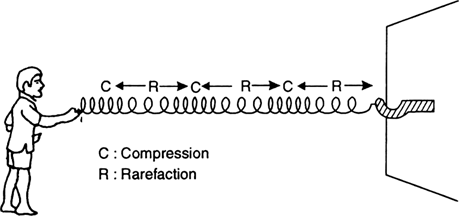
Fig. Formation of longitudinal waves in a slinky.
i) Consider a slinky held horizontally and its one end tied to a rigid support.
ii) If we continuously give motion to its end slightly, the turns of the slinky begin to oscillate back and forth about their original positions along the length of the spring.
iii) These turns alternately come closer together and move away from the one another so that there are alternate regions of increased and decreased pressure. These regions are called ‘compressions’ and ‘rarefactions’ respectively.
iv) Thus, the waves in the slinky are longitudinal as the vibrations of the particles are along the direction of wave motion.
Through what type of media, can
(i) the transverse waves and
(ii) the longitudinal waves be transmitted?
Give reason.
Transverse waves travel in the form of crests and troughs. During the course of motion, they involve changes in the shape of the medium. So they can be transmitted through a medium which has elasticity of shape. As solids have elasticity of shape, so transverse waves can be transmitted through solids.
Longitudinal waves travel in the form of compressions and rarefactions. They involve changes in the volume and density of the medium. All media—solid, liquids and gases have elasticity of volume. Hence longitudinal waves can be transmitted through all the three types of media.
Give four differences between transverse and longitudinal waves.
Difference between transverse and longitudinal waves are as given below:
|
Transverse waves |
Longitudinal waves |
|
|
1. In longitudinal waves, the particles of the medium vibrate along the direction of wave motion. |
|
2. These waves travel in the form of alternate crest and troughs. |
2. These waves travel in the form of alternate compressions and rarefactions. |
|
3. These waves can be transmitted through solids or over liquid surfaces. |
3. These waves can be transmitted through all the three types of media, viz., solids, liquids and gases. |
|
4. They do not cause pressure changes in the medium through which they pass. |
4. They cause changes in the pressure of the different parts of the medium through which they pass. |
|
5. Examples: |
5. Examples: |
Distinguish between mechanical and electromagnetic waves.
Differences between mechanical and electromagnetic waves are:
|
Mechanical waves |
Electromagnetic waves |
|
1. The waves require a material medium for their propagation. |
1. These waves do not require a material medium for their propagation. |
|
2. These are caused due to vibrations of the particles of the medium. |
2. These are caused due to varying electric and magnetic fields. |
|
3. These waves have low speeds, e.g. speed of sound in air is 332 m/s at 0°C. |
3. These waves travel with a very high speed of 3 x 108 m/s through vacuum. |
|
4. These waves have usually low frequency and large wavelength. |
4. These waves have usually high frequency and low wavelength. |
|
5. These can be transverse or longitudinal. |
5. These are only trnasverse waves. |
What is sound and how is it produced?
Sound is a form of energy which produces a sensation of hearing in our ears. Vibrating any object produces sound.
For example, when a bell is rung, we hear a sound. We can feel the vibrations by touching the ringing bell.
Plucking a string of guitar or sitar produces sound. The vibrations of the string can be observed.
The sound of human voice is produced due to the vibrations in the vocal cord.
When a bird flaps its wings, again a sound is produced.
Sound can make a light spot dance. Describe a simple experiment to illustrate this fact.

Fig. 12.7. A beam of light from a light source is made to fall on a mirror. The reflected light is falling on the wall.
i) Take a tin can. Remove both ends to make it a hollow cylinder.
iii) Now, take a small piece of mirror. Stick the piece of mirror to balloon using a glue stick.
iv) Allow the light to fall on the mirror through the slit. After reflection, we can see the light spot on the wall as seen in the fig.
v) Shout directly into the open end of the can and observe the dancing light spot on the wall.
vi) The sound wave incident on the back of the mirror makes set it into vibration. As a result, the reflected spot of light appears to dance on the wall.
How does the sound produced by a vibrating object in a medium reach your ear?
Sound moves through a medium from the point of generation to the listener. When an object vibrates, it sets the particles of the medium around it vibrating. The particles do not travel all the way from the vibrating object to the ear. A particle of the medium in contact with the vibrating object is first displaced from its equilibrium position. It then exerts a force on the adjacent particle. As a result of which the adjacent particle gets displaced from its position of rest. After displacing the adjacent particle the first particle comes back to its original position. This process continues in the medium till the sound reaches your ear.
Give an experiment to show that sound needs a material medium for its propagation.
Sound needs a material medium for propagation.
Sound is a mechanical wave which needs a material medium to travel. It can travel through air, water, steel, etc. but cannot travel through vacuum.
This can be demonstrated by the following simple experiment.
i) Suspend an electric bell inside a glass bell jar by passing the connecting wires through an airtight cork fitted at the mouth of the jar.
ii) Place the jar over a disc which has a pipe connected to a vacuum pump, as shown in Fig. 12.9.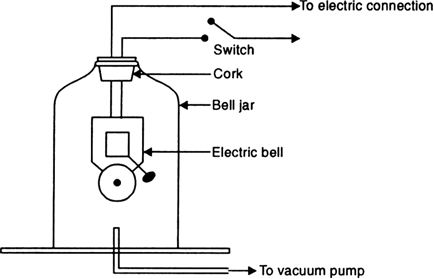
Fig. 12.9. Experiment showing sound needs a medium to travel.
iii) When we turn on the switch, we hear the sound of the bell.
iv) Now, with the help of a vacuum pump, we pump out the air from the jar. The sound becomes fainter.
v) When most of the air has been removed, we hear a very feeble sound. When there is air inside the jar, sound travels through it to the wall of the jar. This makes the wall to vibrate which in turn, sends sound to us.
vi) When air is removed, sound from the bell cannot travel to the wall of the jar.
Therefore, we can see that the sound waves need material medium for propagation.
Explain how is sound produced by your school bell.
When the hammer is beaten on a school bell, it begins to vibrate and produces sound. We are able to feel the vibrations, if we gently touch the bell. Therefore, we can say that sound is produced by a vibrating body.
Why are sound waves called mechanical waves?
Mechanical waves is characterised by the motion of the particles of the medium. Sound needs a material medium like air, water, steel, etc. for its propagation. Hence, sound waves are called mechanical waves.
Suppose you and your friend are on the moon. Will you be able to hear any sound produced by your friend ?
The moon has no atmosphere or material medium through which sound can travel. Hence, the sound produced by our body cannot be propagated while we are on the surface of the moon.
What is the nature of the sound waves?
Sound waves are longitudinal waves.
When a sound wave passes through a medium, such as air, the individual particles of the medium move in a direction parallel to the direction of propagation of the disturbance. The particles of the medium thus move to and fro along the direction of propagation of the sound waves.
How can a transverse wave be represented graphically?
Graphical representation of a transverse wave.
In the fig. given below, the curve represents displacement-distance graph for a transverse wave at any given instant of time. 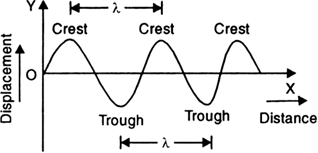
Fig. 12.11. Displacement-distance graph of a transverse wave.
X-axis represents the direction of propagation of the wave.
Y-axis represents the displacements of the particles from their mean positions.
In a transverse wave, the displacements of the particles are perpendicular to the direction of wave motion.
So, the displacement-distance graph is essentially the picture of the wave itself.
The distance between two successive crests or troughs is called wavelength.
It is usually represented by λ (lambda).
How can a longitudinal wave be represented graphically?
Graphical representation of a longitudinal wave: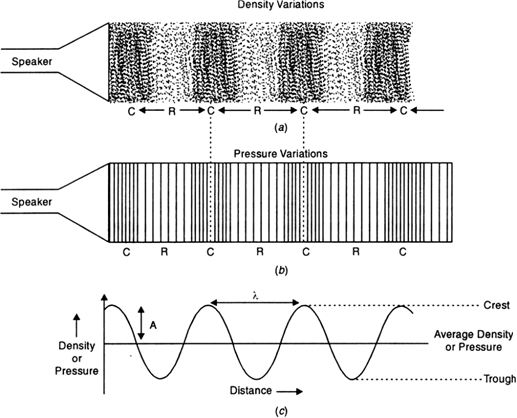
Fig. Sound propagates as density or pressure variations as shown in (a), (b) and (c) represent graphically the density and pressure variations.
i) When a longitudinal wave passes through a medium, the particles of the medium alternately come closer together and move away from one another. Thus, alternate regions of increased and decreased density is created. These regions are called compressions and rarefactions respectively.
ii) In the figure below, (a) and (b) represent the density and pressure variations, respectively as the sound wave propagates through a medium. Fig. (c) represents the variations of density.
iii) The variation of density increases or decreases as the pressure of the medium at a given time increases or decreases with distance, above and below the average value of density and pressure.
iv) The distance between two successive compressions (C) or two rarefactions (R) is called wavelength. It is usually represented by λ (lambda).
Define the terms amplitude, intensity, time period, frequency, wavelength and velocity of a wave. Give their SI units.
Sound waves are characterised by the following physical quantities:
(i) Amplitude: The maximum displacement suffered by the particles of the medium from their mean positions during the wave propagation is called ‘amplitude’ of the wave.
It is denoted by A.
Its SI unit is metre (m).
Crests and troughs have amplitude A.
(ii) Intensity: The amount of sound energy passing each second through unit area is called the intensity of the sound wave.
Larger the amplitude of a wave, larger is its intensity. In fact.

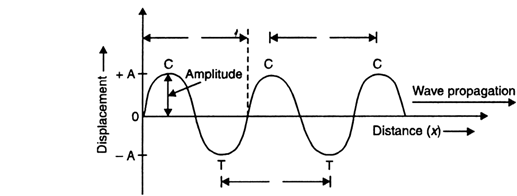
Fig. 12.13. Characteristics of a wave.
(iii) Time period: The time period of a wave is defined as the time in which a particle of the medium completes one vibration to and fro about its mean position.
Time period is equal to the time taken by two successive compressions or rarefactions of a sound wave to cross a fixed point.
It is represented by the symbol T.
Its SI unit is second (s).
(iv) Frequency: The number of waves produced per second is called frequency of the wave.
It is equal to the number of compressions or rarefactions crossing a point per unit time. It is denoted by v (nu).
It is equal to the reciprocal of time period.
Thus,

Wavelength: Wavelength is the distance travelled by the wave during the time a particle of the medium completes one vibration.
It is equal to the distance between two successive crests or troughs or between two successive compressions and rarefactions and is denoted by λ (lambda).
Its SI unit is metre (m).
Wave velocity: Wave velocity is the distance travelled by a wave per unit time.
It is the speed with which a disturbance (crest, trough, compression or rarefaction) propagates through a medium.
Its SI unit is ms–1.
Q. 24. Define wave velocity, frequency and wavelength. Give SI unit of each term.
Wave velocity: Wave velocity is the distance travelled by a wave per unit time. It is the speed with which a disturbance of the particle like crest, trough, compression or rarefaction propagates through a medium.
Its SI unit is ms–1.
(iv) Frequency: The number of waves produced per second is called frequency of the wave. It is equal to the number of compressions or rarefactions crossing a point per unit time.
Symbolically, it is denoted by v (nu).
It is equal to the reciprocal of time period.
SI unit of frequency = hertz (Hz).
Wavelength: The distance between two successive crests or troughs or between two successive compressions and rarefactions is called the wavelength.
It is denoted by λ (lambda).
SI unit of wavelength is metre (m).
Derive a relation between wavelength, frequency and velocity of a wave.
Frequency, wavelength and wave velocity are related as follows:
Wavelength is the distance travelled by the wave during the time a particle of the medium completes one vibration.
Therefore, if λ be the wavelength and T the time-period, then the wave travels a distance λ in time T.
Hence,
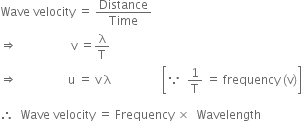
The wave velocity in a medium remains constant under the same physical conditions.
Does the speed of sound through a medium depend on frequency?
No, the speed of sound remains almost same for all frequencies in a given medium under the same physical conditions. That is, speed of sound is independent of frequency.
Distinguish between particle velocity and wave velocity.
The distance travelled by a wave per unit time is known as the wave velocity. Wave velocity remains constant in a given medium. Wave velocity is given by,
υ = vλ
Particle velocity is the velocity of a particle in a medium as it transmits a wave. Particle velocity continuously changes with time. It is maximum at the mean position and zero at the extreme position.
On what factor does the frequency of a wave depend
Frequency of a wave is given by,
where,
v is the speed with which the wave propagates, and
is the wavelength of the wave.
Different sources produce oscillations of different frequencies depending on the wavelength of the sources. Frequency changes such that the speed remains constant.
What are the wavelength, frequency, time period and amplitude of a sound wave?
Wavelength(λ): Wavelength is defined as the distance between two consecutive compressions or rarefactions of a sound wave.
Frequency(v): Frequency is the number of complete oscillations per unit time.
Time period(T): The time taken by two consecutive compressions or rarefactions to cross a fixed point is called the time period of the sound wave.
Amplitude(A): The magnitude of the maximum disturbance in the medium on either side of the mean value is called the amplitude of the wave.
Calculate the wavelength of a sound wave whose frequency is 220 Hz and speed is 440 ms–1 in a given medium.
Given,
Frequency of the wave,
Speed of the wave, v = 440 ms-1
So, wavelength is given by,
A person is listening to a tone of 500 Hz sitting at a distance of 450 m from the source of sound. What is the time interval between successive compressions from the source?
Given,
Frequency of the sound, = 500 Hz
distance of the person from the source = 450 m
Therefore,
Time interval between two successive compressions is given by,
T =
25 waves are produced per second, what is the frequency in Hz?
So, frequency =
What is the frequency of a wave time-period is 0.05 s?
Time period of the wave, T = 0.05 s
So,
Frequency of the wave, =
A human heart, on an average, is found to beat 75 times a minute. Calculate its frequency.
Number of beats in 1 min or 60 s = 75
Number of beats in 1 second =
Number of heartbeats in 1 second is the frequency of the wave.
Thererefore,
Frequency of the heartbeat = 1.25 Hz
Sound waves travel with a speed of about 330 m/s. What is the wavelength of sound waves whose frequency is 550 hertz?
Speed of sound, u = 330 m/s
Frequency of sound waves = 550 Hz
![]()
A wave pulse on a string moves a distance of 8 m in 0.05 s.
(a) Find the velocity of the pulse.
(b) What would be the wavelength of the wave of the same string if its frequency is 200 Hz?
a) Given,
Distance travelled by the string, s = 8 m
Time taken for the pulse to move through the string, t = 0.05 s
Velocity of the pulse, v = s/t
v= ![]()
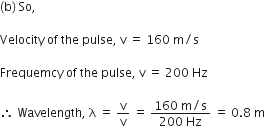
A source of wave produces 40 crests and 40 troughs in 0.4 second. Find the frequency of the wave.
Time taken, t = 0.4 second
One wave corresponds to 1 crest and 1 trough.
Hence, 40 waves is equal to 40 crests and 4 troughs.
Therefore,
Frequency of the wave,
A sound wave has a frequency of 2 kHz and wavelength 35 cm. How long will it take to travel 1.5 km?
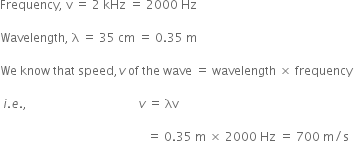
The time taken by the wave to travel a distance, d of 1.5 km is,
Thus sound will take 2.1 s to travel a distance of 1.5 km.
The velocity of sound in a medium is 1400 m/s, and its wavelength is 1 km. (i) What is its frequency 1 (ii) Can you hear this sound?

(ii) We cannot hear this sound because sound waves having frequency less than 20 Hz are not audible.
During a thunder storm, sound is heard 10 s after the lightning is seen. What is the distance of the cloud from the observer ? Take velocity of sound as 330 m/s.
Given,
time lapse between thinder and lightning, t = 10 s
Velocity of sound, v = 330 m/s
So, distance travelled, s = vt
= 330 x 10
= 3300 m
Find the velocity of the wave shown in the figure below.
λ = 2.5 m
Now a wave travels a distance equal to wavelength in one time period.
Therefore, time-period is

Distinguish between the terms music and noise.
Music: Music is a pleasing sensation to the ears and is of rich quality. It is produced by regular and periodic vibrations, without any sudden change in loudness.
Example: The sound produced by plucking the string of a sitar, sound from a tabla, etc.
Noise: The sound which has a non-pleasing or jarrying effect on the ears is called noise.
Noise is produced at irregular intervals and there is a sudden change in its loudness.
Example: The sound produced by an explosion, sound from a market are examples of noise.
Distinguish between the terms tone and note.
A sound of single frequeny is called a tone.
The sound which is a mixture of several frequencies is called a note.
Explain the characteristics of sound. On what factors do they depend?
The three characteristics of sound are,
(i) Loudness, (ii) Pitch and (iii) Quality or timbre.
(i) Loudness: The physiological response of the ear to the intensity of sound is called as loudness.
It distinguishes between a loud sound and low sound.
Loudness depends on two main factors:
(a) Intensity of sound which is directly proportional to the square of the amplitude of the sound wave.
(b) Sensitivity of the ear.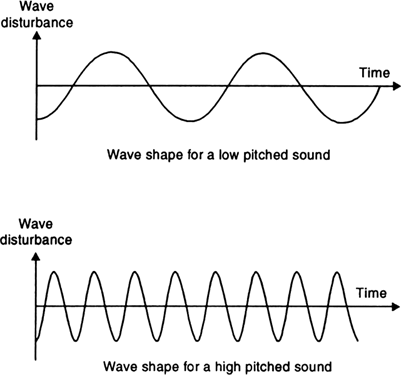
Fig. Soft sound has small amplitude and louder sound has large amplitude. The graph shows the wave shapes of a loud sound and a soft sound of the same frequency.
(ii) Pitch: Pitch is the sensation which helps a listener to distinguish betwen a high and a grave note. Pitch depends on frequency.
The faster the vibration of the source of sound, the higher is the frequency and higher is the pitch.
From the fig. below we can see that a high pitch sound corresponds to more number of compressions and rarefactions passing a given point per unit time.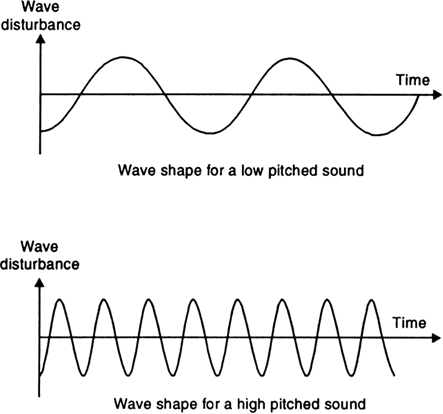
Fig. 12.17. Low pitch sound has low frequency and high pitch sound has high frequency.
(iii) Quality or timbre: The characteristic which enables us, to distinguish one sound from another having the same pitch and loudness is called as the quality or timbre.
Which wave property determines
(a) loudness, (b) pitch?
(a) Intensity of the wave determines the loudness.
(b) Pitch is determined by the frequency of the wave.
Guess which sound has a higher pitch guitar or car horn?
The sound of a guitar is more shill than that of a car horn. Therefore, the sound of a guitar has a higher pitch.
Distinguish between loudness and intensity of sound.
Intensity: Intensity of sound wave is the amount of sound energy passing each second through a unit area.
Loudness: It is a physiological response of the ear. Loudness depends both on the intensity of sound and the response of the ear towards that sound.
On what factors does the speed of sound through a medium depend?
The speed of sound through a medium primarily depends on two factors:
(i) Nature of the medium.
(ii) Temperature of the medium.
In which of the three media, air, water or iron, does sound travel the fastest at a particular temperature?
In different media, the sound of speed is different. The speed of sound depends on the density and volume of the medium. Elasticity of solids is much greater than that of liquids which in turn, is greater than that of gases. Therefore, sound travels fastest through solids and slowest through gases.
The speeds of sound in various media at 25°C are listed in the below table.
Table: Speed of sound in different media at 25°C
|
State |
Substance |
Speed in ms–1 |
|
Solids |
Aluminium |
6420 |
|
Nickel |
6040 |
|
|
Steel |
5960 |
|
|
Iron |
5950 |
|
|
Brass |
4700 |
|
|
Glass (Flint) |
3980 |
|
|
Liquids |
Water (Sea) |
1531 |
|
Water (distilled) |
1498 |
|
|
Ethanol |
1207 |
|
|
Methanol |
1103 |
|
|
Gases |
Hydrogen |
1284 |
|
Helium |
965 |
|
|
Air |
346 |
|
|
Oxygen |
316 |
|
|
Sulphur dioxide |
213 |
In which of the three media : air, water or iron, does the sound travel the fastest at a particular temperature?
The propagation of sound need variation in density and volume of the mediium. Solid (Iron) is the most elastic out of three. therefore, sound travels fastest through iron with a speed of 5950 ms–1.
State the factors on which the speed of sound in a gas depends.
The speed of sound in a gas depends on the following factors:
(i) Effect of pressure: Pressure has no effect on the speed of sound in a gas.
(ii) Effect of density: At constant pressure, the speed of sound in a gas is inversely proportional to the square root of its density.![]()
(iii) Effect of humidity: Sound travels faster in moist air than in dry air.
(iv) Effect of temperature: The speed of sound in a gas is directly proportional to the square root of its absolute temperature.![]()
So, the speed of sound increases with the increase in temperature of the gas.
For example, the speed of sound in air is 331 ms–1 at 0°C and 344 ms–1 at 22°C.
(v) Effect of wind: Sound is carried by air, so the speed of sound increases when the wind blows in the direction of sound and speed of sound decreases when the wind blows in the opposite direction of sound.
Why do we hear the sound of a horn of approaching car before the car reaches us?
We hear the sound of a horn of the approaching car first because the velocity of sound is much greater than that of the fastest car.
Why is the flash of lightning from clouds seen much before the thunder, although both occur simultaneously?
The velocity of light which is equal to 3 x 108 ms-1 is much greater than the velocity of sound equal to 344 ms–1. Hence, we see the flash of lightning much before the sound of thunder reaches us.
What do you understand by the terms supersonic speed, shock waves and sonic boom?
Supersonic sound is when a body moves in air with a speed greater than the speed of sound.
Example: Bullets, jet aircrafts etc. travel at supersonic speed.
When a source of sound travels in air at a supersonic speed, it leaves behind itself a conical region of disturbance which spreads continuously. A region consisting of a very high pressure layer followed by a lower pressure layer travels through the space together with the cone. This is called a shock wave. Shock wave carries a large amount of energy.
Shock waves have large variation in the air pressure. So, when a shock wave reaches a person, it produce a sharp and loud sound in his ears because of the differences in air pressure. This is called sonic boom.
The sonic booms from a high speed jet aircraft can break glass dishes, windowpanes and can even cause serious damage to a building.
What is reflection of sound? Does sound follow the same laws of reflection as light does?
When a sound wave travelling in a medium strikes the surface separating two media, a part of the incident wave is reflected back into the first medium. This is called reflection of sound waves.
Like light, sound gets reflected at the surface of a solid or liquid. Same laws of reflection of sound is followed by reflection of sound also.
When sound is reflected, the directions in which the sound is incident and reflected make equal angles with the normal at the reflecting surface and the three are in the same plane.
From which types of surfaces the reflection of sound is better?
Reflection of sound will be heard better from the smooth surface. The reason is that the rough or porous surface allows for many internal reflections, resulting in more absorption and less reflection.
For example, sound reflected from a plastic tray is louder than that reflected from a cardboard.
What types of surfaces are needed for reflection of sound waves?
The types of surfaces needed for reflection of sound waves are:
i) obstacle of large size
ii) A surface which is well polished or rough.
What is an echo? Name the conditions for the production of an echo?
The phenomenon of repetition of a sound due to its reflection from the surface of a large obstacle is termed as echo.
For example, when a loud sound is produced in an empty hall, the same sound is heard again after some time.
To produce an echo, the conditions required a are:
(i) There should be sufficient time gap between original and reflected sounds. So, if we want to hear distinct echo, the reflected sound must reach the ear 0.1 s after the direct original sound.
(ii) The distance between the source of sound and the obstacle should be sufficient. An echo will be heard distinctly if the minimum distance between the source of sound and the obstacle is 34.4/2 = 17.2 m.
(iii) Nature of the obstacle plays an important role. For the formation of echo, the reflecting surface must be rigid such as a building, hill or a cliff.
(iv) Size of the obstacle should be quite large for the echoes to be heard.
What are multiple echoes? Give examples.
The successive reflection of a sound wave from a number of obstacles, causes us to hear echo of the sound transmitted one after other. When a sound is repeatedly reflected between two parallel distant buildings or cliffs, multiple echos are produced.
For example, rolling of thunder is due to successive reflections between clouds and land surfaces.
What is reverberation? How can it be reduced?
The waves suffer multiple reflections from the walls, ceilings and other materials present, when a sound is produced in a big hall or auditorium. As a result of this, sound persists for some time even after the source has stopped producing sound.
Revertebration is the process of persistence of sound due to repeated reflection.
Methods of reducing reverberation.
In a big hall or auditorium, excessive reverberation is highly undesirable. The following below methods can be used to reduce them.
(i) By covering the walls and roof of the auditorium with sound absorbent materials like compressed fireboard, rough plaster, etc.
(ii) Providing open windows in the space.
(iii) Providing heavy curtains with folds, so that the sound gets absorbed.
(iv) By using good sound absorbing materials for the seats.
An echo returned in 3 s. What is the distance of the reflecting surface from the source, given that the speed of sound is 342 ms–1?
Speed of sound, v = 342 ms-1
Time taken for hearing the echo, t = 3 s
Distance traversed by the sound wave = vt
= 342 x 3
= 1026 m
In 3 s, sound has to travel twice the distance between the reflecting surface and the source.
So, Distance of the reflecting surface from the source , d =
A person clapped his hands near a cliff and heard the echo after 5 s. What is the distance of the cliff from the person if the speed of the sound, v is taken as 342 ms–1?
Time taken for hearing the echo, t = 3 s
Distance travelled by the sound = vt
= 342 x 3
= 1026 m
In 3 s, sound has to travel twice the distance between the the cliff and the person.
Hence the distance between the cliff and the person is given by, d= 1730 m/2 = 865 m
A child hears an echo from a cliff 4 seconds after the sound from a powerful cracker is produced. How far away is the cliff from the child?
Therefore time taken by the sound to reach the cliff =
Speed of sound in air, v = 340 m/s
Distance of cliff from the child = vt
= 680 m.
A stone is dropped into a well, 44.1 metres deep. The sound of the splash is heard 3.13 seconds after the stone is dropped. Find the velocity of sound in air.
The time t taken by the stone to reach the water level in the well by using the relation,
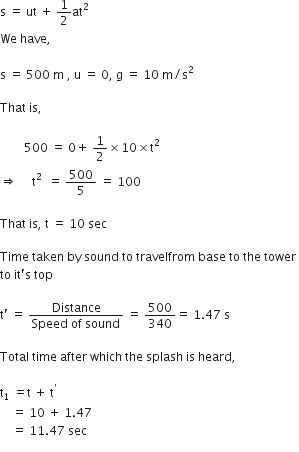
Describe some practical applications from daily life based on multiple reflection of sound.
Uses of multiple reflection of sound:
1. Megaphones or loudhailers, horns, musical instruments such as trumpets and shehanais, are all designed to send sound in a particular direction without spreading it in all directions.
In these instruments, a tube followed by a conical opening reflects sound successively to guide most of the sound waves from the source in the forward direction towards the audience.
The fig. below shows us some musical instruments. 
Fig. Multiple reflection of sound in a megaphone or horn.
2. Stethoscope: In a stethoscope, the sound of a patient’s heartbeat is guided along the tube of the stethoscope to the doctor’s ears by multiple reflections of sound.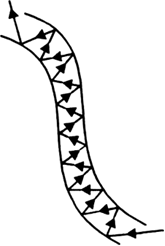
Fig. Mutliple reflections of sound in the tube of a stethoscope.
3. Curved ceilings concert halls The ceilings of concert halls, conference halls and cinema halls are made curved so that sound after reflection reaches all corners of the hall. 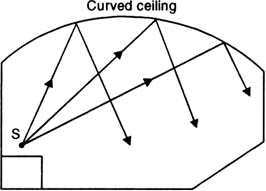
Fig. 12.21. Curved ceiling of a conference hall
4. Sound boards: In large halls or auditorium, large concave wooden boards are placed behind the speaker. The speaker stands at the focus of this concave reflecting surface. After reflection, the sound is spread evenly towards the audience. This makes the speech readily audible even at a distance.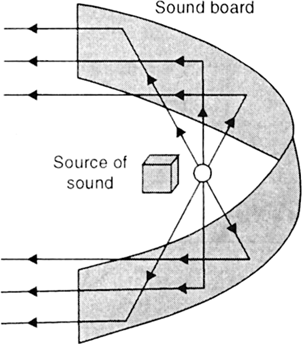
Fig. 12.22. Sound board used in a big hall.
Why are the ceilings of concerts halls curved?
The ceilings of the concert halls are made curved. This is done so that the sound after reflecting from the ceiling reaches all corners of the hall, as shown in Fig. below. 
Fig. Curved ceiling of a concert hall.
What is the audible range of the average human ear?
In human beings, frequency range of hearing from 20 Hz to 20,000 Hz is called audible range. Human ear is sensitive to frequencies between 20 Hz to 20,000 Hz.
Human ears cannot hear sounds of frequencies less than 20 Hz and above 20,000 Hz.
What are infrasonic and ultrasonic waves? Give examples.
Infrasonic waves: If the frequency of the waves is less than 20 Hz then the waves are called infrasonic waves. Infrasonic waves are produced by large vibrating bodies.
The waves produced before the actual shockwaves during an earthquake is infrasonic waves. Animals ike whales and elephants produce infrasonic waves. Human beings cannot hear these waves.
Ultrasonic waves: When the frequency of the waves is greater than 20,000 Hz they are called ultrasonuic waves.
Bats, dogs, rats, cats, birds and insects can produce and also hear these waves.
What types of waves are used by rhinoceroses during communication?
Rhinoceroses communicate using infrasonic waves of frequency as low as 5 Hz.
Why do the animals behave in a peculiar manner before an earthquake?
When the earth quakes, they produce low frequency infrasound before the main shock waves. These infrasonic waves are not audible to the human ears. But animals are able to detect these waves and hence some animals get disturbed before earthquakes and start behaving in a different manner.
What is a hearing aid ? Briefly describe its working principle.
A battery operated electronic device used by persons who cannot hear properly is called as hearing aid.
Working of the hearing aid is as follows:
Hearing aid receives sound through a microphone. The microphone converts the sound waves to electrical signals. These electrical signals are amplified by an amplifier. The amplified electrical signals are given to a speaker of the hearing aid. The speaker converts the amplified electrical signal to sound and sends to the ear for clear hearing.
What is the audible range of the average human ear?
The audible range of frequency extends from 20 Hz to 20,000 Hz, for an average human ear.
What is the range of frequencies associated with,
(a) Infrasound?
(b) Ultrasound?
(a) Sound of frequency less than 20 Hz is called infrasound.
(b) Sound of frequency higher than 20 kHz is called ultrasound.
What is ultrasound? State the special properties of ultrasound that make it useful to us.
Ultrasound or ultrasonic wave is a wave in which the compressions and rarefactions in a material medium propagates with a frequency above 20 kHz.
Ultrasonic wave travels freely in solids and liquids but its intensity decreases rapidly in gases.
Ultrasonic waves have the following two important properties, because of their high frequencies:
1. They have high power.
2. They are able to travel along well-defined straight paths, even in the presence of obstacles.
The above two properties make the ultrasonic waves highly useful for industrial and medical purposes.
Explain some important applications of ultrasound in industry and medicine.
Industrial applications of ultrasound in industry and medicine are:
Industrial application:
1. Ultrasonic detection of defects in metals: The construction of big structures like buildings, bridges, machines, scientific equipments, etc use metallic components. The cracks or holes inside the block reduce the strength of the structure. Such defects are not visible from outside. Ultrasonic waves can be used to detect such defects. Ultrasonic waves are allowed to pass through the metal block and detectors are used to detect the transmitted waves. If there is even a small defect, the ultrasound gets reflected back and does not reach the detector. This is how the presence of a flaw or defect is detected.
Medical application:
1. Echocardiography: In this technique, ultrasonic waves are made to reflect from various parts of the heart to form the image of the heart.
2. Ultrasonography: Ultrasonic waves can be used to develop three dimensional photographs of different parts of the human body. This technique is called ultrasonography.
This technique is also used to monitor the growth of a foetus inside its mother’s womb. In this technique the ultrasonic waves travel through the tissues of the body and get reflected from a region where there is a change of tissue density. These waves are then converted into electrical signals that are used to generate images of the organ. These images are then displayed on a monitor or printed on a film.
3. In surgery: Ultrasonic waves are commonly used in cataract removal. Ultrasonic waves are used to grind small stones formed in the kidneys. These grinded grains are flushed with urine.
What is a SONAR? Briefly explain its working principle.
SONAR- The acronym SONAR stands for Sound Navigation and Ranging.
Sonar is a device that uses ultrasonic waves to measure the distance, direction and speed of underwater objects.
Principle: It uses the phenomenon of echoes in determining the sea-depth and locating the presence of under-water objects.
Working:
i) A strong beam of ultrasonic waves is sent from a transmitter mounted on the ship.
ii) The beam is reflected from the seabed and is received by an under-water detector which is also mounted on the ship.
iii) The time interval between transmission and reception of the ultrasonic signal is noted.
What is a SONAR? Briefly explain its working principle.
SONAR- The acronym SONAR stands for Sound Navigation and Ranging.
Sonar is a device that uses ultrasonic waves to measure the distance, direction and speed of underwater objects. SONAR is also called as echo ranging.
Principle: It uses the phenomenon of echoes in determining the sea-depth and locating the presence of under-water objects.
Working:
i) A strong beam of ultrasonic waves is sent from a transmitter mounted on the ship.
ii) This beam is then reflected from the seabed and is received by an under-water detector which is also mounted on the ship.
iii) The time interval between transmission and reception of the ultrasonic signal is noted.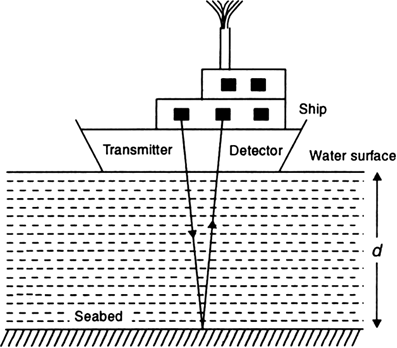
Fig. Ultrasound sent by a transmitter and received by a detector.
iv) If ultrasonic waves travel with speed v in sea-water and time t is elapsed between the transmission and reception of the ultrasound signal, then the sea depth will be
![]()
Uses:
SONAR technique is used to determine the depth of the sea and to locate underwater hills, valleys, submarine, icebergs, sunken ship etc.
A submarine emits a SONAR pulse, which returns from an obstacle underwater cliff in 1.02 s. If the speed of sound in salt water is 1531 m/s, how far away is the cliff?
Given,
Time between transmission and detection of sonar pulse, = 1.02 s
Speed of sound in salt water, v= 1531 ms-2
Let, distance of the cliff be equal to d (say).
Then the distance travelecd by sound = 2d
Now, using the distance-time formula, we have
2d = speed of sound x time
= vt
= 1531 x 1.02 m
So, distance of the cliff, d =
A ship sends out ultrasound that returns from the seabed and is detected after 3.42 s. If the speed of ultrasound through seawater is 1531 m/s, what is the distance of the seabed from the ship?
Time between transmission and direction, t = 3.42 s
Speed of ultrasound in sea water, v = 1531 m/s
Let, the depth of the sea be 'd'.
Distance travelled by the ultasound = 2 x depth of the sea = 2d
Therefore,
2d = speed of sound X time
= 1531 m/s x 3.42 s
= 5236 m
Therefore,
Distance of the seabed from the ship, d =
Thus, the distance of the seabed from the ship is 2.62 km.
Using the SONAR, sound pulses are emitted at the surface of water. These pulses after being reflected from bottom of water, are detected. If the time interval from the emission to the detection of the sound pulses is 2 seconds, find the depth of the water.
Time between the transmission and detection of the pulses = 2 seconds
Speed of sound in water, v = 1450 m/s
Time taken by the pulse to travel to the bottom of water = 2/2 sec = 1 sec
Therefore, using the distance-time formula, we have
Depth of water = vt = 1450 x 1 = 1450 m.
Define a vibration.
Vibration or oscillation is defined as one complete back and forth motion of an oscillating body about its mean position.
How does the motion of the particles of the medium differ from that of a wave through it?
Particles of the medium simply vibrate around their mean position whereas a wave travels through different parts of the medium with a definite velocity.
What are the two types of wave motions? How do the vibrations of the particles differ during the propagation of the two types?
The wave motion is of two types namely:
(i) Transverse wave motion, and
(ii) Longitudinal wave motion
In transverse wave motion, the particles of the medium vibrate in a direction perpendicular to the direction of wave motion
In longitudinal wave motion, the particles of the medium vibrate along the direction of wave motion.
What is a transverse wave?
Transverse waves are the waves in which the particles of the medium vibrate in directions perpendicular to the direction of wave motion.
For example, when a stone is thrown in a pond of water, the waves formed over water surface are transverse waves.
What are longitudinal waves? Give two examples.
Longitudnal waves are the waves in which the particles of the medium vibrate along the direction of wave motion.
Sound waves in air, the waves produced along the length of a compressed spring are all examples of longitudnal waves.
Define the terms crests and troughs of wave.
The point or the maximum displacement in the positive y-direction, to which the particle of the medium rises to are called crests.
The particles of the medium has maximum displacement in the negative y-direction. These valleys are called troughs.
Define the terms compressions and rarefactions of a wave.
A longitudnal wave passes through a medium, and causes pressure variations in different parts of the medium. Compressions are the regions of increased pressure and the regions of decreased pressure are called rarefactions.
A stone is dropped on the surface of water in a pond. Name the type of waves produced.
Transverse waves.
When the wire of a sitar is plucked, what type of waves are produced in
(i) the wire, and
(ii) air?
(i) Transverse waves in the wire.
(ii) Longitudinal waves in the air.
Define wavelength.
Wavelength is the distance between successive crests of a wave, in a time the particle of the medium completes one vibration.
Tuning fork is marked with number 512. What does this number signify?
The number 512 indicates the frequency of the tuning fork. When struck against a rubber pad, the tuning fork will make 512 vibrations in one second.
Define velocity of a wave.
Velocity of a wave is the distance travelled by the wave in one second.
What is the relationship between time-period and frequency?
Relationship between time period and frequency is given by:
Time-period (T) is equal to reciprocal of frequency (v).
What is the relationship between frequency, wavelength and wave velocity?
Relationship between frequency, wavelength and wave velocity is given as,
Wave velocity = Frequency x Wavelength.
What is the separation between two successive crests (or troughs) of a transverse wave?
One wavelength (λ).
What is the separation between two successive compressions (or rarefactions) in a longitudinal wave?
One wavelength (λ).
What is the distance between a crest and the next trough?
The distance between a crest and the next trough is ![]()
Is the velocity of a wave same as the velocity of the particles of the medium?
No, particle velocity and wave velocity are both different. Velocity of a wave is constant in a given medium while particle velocity changes continuously during its vibration about mean position.
What is mechanical elastic wave?
Mechanical elastic wave is a wave which requires an elastic medium for its propagation.
Solid has a good elasticity strength.
Can sound travel through vacuum?
No, sound cannot travel in vacuum. Sound requires a medium for its propagation. Large obstacles are required for the reflection of sound waves.
Why a sound cannot be heard on the moon?
The surface of the moon has no atmosphere and hence the sound waves cannot be reflected in vacuum. Sound needs a medium for propagation.
What is the nature of sound waves in air?
Sound travels through air in the form of longitudinal waves.
Mention two points of distinction between elastic waves and electromagnetic waves.
Difference between elastic waves and electromagnetic waves are as follows:
i) Elastic waves require a medium for their propagation while electromagnetic waves do not require any medium for their propagation.
(ii) Elastic waves may be longitudinal or transverse while electromagnetic waves are only transverse in nature.
What is the range of human audibility?
Human ear can hear Sounds waves having frequencies between 20 Hz and 20,000 Hz. This range of frequency is called human audible range.
What is a wave-pulse?
Wave pulse is a wave of short duration. It is a non-sinusoidal waveform, which is similar to a square waveform.
Define wave number.
The number of waves contained in unit length of the medium is called ‘wave number’.
What is an echo?
The phenomenon of repetition of sound due to its reflection from the surface of a large obstacle is called Echo.
Suppose you and your friend land on the moon. Would you and your friend be able to talk each other? Give reason.
No, the friends won't be able to talk to each other because the moon has no atmosphere or material medium through which sound can travel. Sound waves cannot travel in vacuum.
Why do we hear sound of a horn of an approaching car before the car reaches us?
We can hear the sound of a horn before actually seeing the car because the velocity of sound is much greater than that of the fastest car.
State the characteristics of longitudinal waves.
The characteristics of longitudinal waves are as follows:
(i) The vibrations of the particles of the medium are along the direction of wave motion.
(ii) They travel in the form of alternate compressions and rarefactions causing pressure variations in different parts of the medium.
(iii) Longitudnal waves can be transmitted through all the three types of media, viz., solids, liquids and gases.
Can transverse waves be produced in air? Give reason.
No, air has no elasticity of shape. So, transverse waves cannot be produced in air.
Why we cannot hear an echo in a small room?
The length of a room is generally less than 17 m. And, inorder to produce an echo, minimum distance between a source of sound and the obstacle is 17 m. Hence, we do not hear an echo in a small room.
What does cause the rolling sound of thunder?
The rolling sound of thunder is caused by the multiple reflections of the sound of lightning between the clouds and the earth’s surface.
Why are the longitudinal waves also called pressure waves?
Longitudinal waves travel in a medium as series of alternate compressions and rarefactions. That is as they travel, there is variations in pressure. Therefore, they are called pressure waves.
Why is it possible to detect the approaching of a distant train by placing the ear very close to the railway line?
We can detect a train approaching by placing the ear very close to the railway line because sound travels sixteen times faster in iron than in air.
When a stone is thrown on the surface of water, a wave spreads out. From where does the energy come?
The kinetic energy of the stone imparts energy on the water molecules, on which it falls. So, the energy of the waves spreading on the water surface is seen as ripples.
Why explosions on other planets cannot be heard on the earth?
Explosions cannot be heard on planets because there is no material medium in the space between the planets. Sound needs a material medium for propagation. Hence, we do not hear explosions happeing on a different planet.
List any two differences between transverse and longitudinal waves. What is the nature of sound waves in air.
(i) In transverse waves, the particles of the medium vibrate in a direction perpendicular to the direction of propagation of the wave.
In longitudinal waves, the particles of the medium vibrate along the direction of propagation of the wave.
(ii) Transverse waves travel in the form of crests and troughs.
Longitudinal waves travel in the form of compressions and rarefactions.
Sound waves are longitudnal waves in nature.
Define waves. Classify waves on the basis of material medium. Give one example of each.
The disturbance arising due to repeated vibrations of the particles of the medium, moving from one particle to another is known as a wave.
Waves can be classified as follows, on the basis of the medium in which they travel.
1. Mechanical/elastic waves: The waves which require a material medium for their propagation are known as mechanical waves.
e.g., sound waves.
2. Electromagnetic waves: Waves which do not require any material medium for their propagation.
e.g., light waves.
Give some examples of waves which are combination of both transverse and longitudinal wave motion.
A wave has both transverse and longitudnal waves, when it propagates along the surface of a medium. The particles move either along a circle or an ellipse.
Examples of such waves are:
(i) Seismic waves travelling along the surface of the earth during an earthquake or explosion.
(ii) Ocean waves in deep water.
(iii) Wave pulses produced by beetle’s motion along the sand’s surface.
How can bats ascertain distances, directions, nature and size of the obstacles without eyes?
Ultrasonic waves are produced and received by bats during it's flight. After being reflected by the obstacle in it's path, the bast receives these waves. From the time interval between transmission and reception of ultrasonic waves, the bat gets information about the distance, nature of obstacle and its direction of location. Hence bats can move about freely even in total darkness.
Distinguish between a wave pulse and a periodic wave.
|
Pulse |
Periodic wave |
|
1. A pulse is a wave produced by a sudden disturbance of short duration. |
1. A periodic wave produced by continuous and regular vibrations of the particles of the medium. |
|
2. The medium oscillates for a short time and then returns to its undisturbed position. |
2. The medium vibrates for a long time after being disturbed, in a periodic wave. |
|
3. The wave forms are not repetitive. |
3. The wave form has a basic pattern which repeats itself after a fixed interval. |
|
4. It is formed in a small portion of the medium. |
4. It is stretched over the entire length of the medium. |
What is meant by a substance?
A substance which consists of a single type of particle and it cannot be separated into other kinds of matter by any physical process is called a substance.
List the points of differences between homogeneous and heterogeneous mixtures.
|
Homogeneous mixture |
Heterogeneous mixture |
|
It is the mixture in which different constituents are mixed uniformly. |
It is the mixture in which different constitutes are not mixed uniformly |
|
They cannot have physically distinct parts. |
They have physically distinct parts. |
|
The constituents cannot be easily seen. |
The constituents can be easily seen. |
|
The constituents cannot be easily separated. |
The constituents can be easily separated. |
|
Example: sugar solution, soda water, soft drinks, vinegar, air etc. |
Example: sugar and sand mixture, milk, ink, paint, etc. |
Differentiate between homogenous and heterogeneous mixtures with examples.
|
s.no |
Homogenous mixture |
Heterogeneous mixture |
|
1. |
It has a uniform composition throughout its mass |
It has no uniform composition.
|
|
2. |
It has no visible boundary or boundaries of separation between its constituents. For example solution of sugar and salt. |
It has visible boundary or boundaries of separation. For example mixture of sugar and sand. |
To make a saturated solution, 36 g of sodium chloride is dissolved in 100 g of water at 293 K. Find its concentration at this temperature.
Mass of sodium chloride = 36g
Mass of solution =100g
Mass of the solution = 100+36g =136g
Concentration of the solution = 36/136 x 100 =26.47%
How will you separate a mixture containing kerosene and petrol (difference in their boiling points is more than ![]() ), which are miscible with each other?
), which are miscible with each other?
We can separate a mixture containing kerosene and petrol by simple distillation because kerosene and petrol do not decompose on heating and their boiling points are sufficiently apart. The apparatus used for the simple distillation is given below.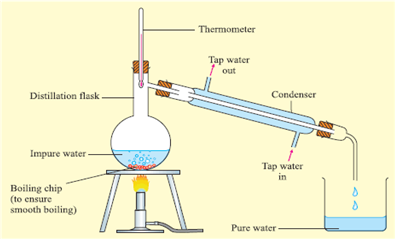
Name the technique to separate:
(i) butter from curd,
(ii) salt from sea-water
(iii) camphor from salt.
(i) Butter from curd = centrifugation
(ii) Salt from sea-water = crystallization
(iii) Camphor from salt = Sublimation
What type of mixtures are separated by the technique of cyrstallisation?
Crystallization is used to purify salt that we get from sea water and to obtain pure substance from their impure samples.
Classify the following as chemical or physical changes:
(i) cutting of trees.
(ii) melting of butter in a pan.
(iii) rusting of almirah.
(iv) boiling of water to form steam.
(v) passing of electric current, through water and the water breaking down into hydrogen and oxygen gases.
(vi) dissolving common salt in water.
(vii) making a fruit salad with raw fruits, and
(viii) burning of paper and wood.
(i) Cutting of tree is a physical change.
(ii) Melting of butter in a pan is a physical change.
(iii) Rusting of almirah is a chemical change.
(iv) Boiling of water to form steam is a physical change.
(v) Passing of electric current through water and the water breaking down into hydrogen and oxygen gases is a chemical change.
(vi) Dissolving common salt in water is a physical change.
(vii) Making a fruit salad with raw fruits is a physical change.
(viii) Burning of paper and wood is a chemical change.
A person has a hearing range from 20 Hz to 20 kHz. What are the typical wavelengths of sound waves in air corresponding to these two frequencies? Take the speed of sound in air as 344 m s–1.
For a sound wave,
Speed = wavelength x frequency
i.e., ![]()
Given that, the speed of sound in air = 344 m/s
(i) For, v = 20 Hz,
![]()
(ii) For v = 20,000 Hz
![]()
Hence, for the humans the wavelength range for hearing is 0.0172 m to 17.2 m.
2 ml of dettol is added to a beaker containing 500 ml of water and stirred. State the observations that you can make.
1)The solution becomes colloidal in nature.
2) The 2 ml dettol mixed with 500 ml of water and formed homogenous solution.
3) A white turbid colour appear when dettol is mixed with water.
Mock Test Series
Sponsor Area
Sponsor Area







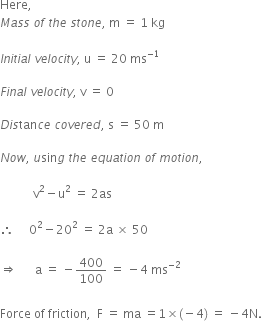
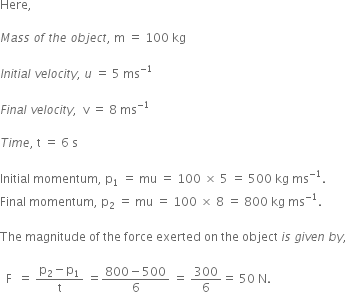
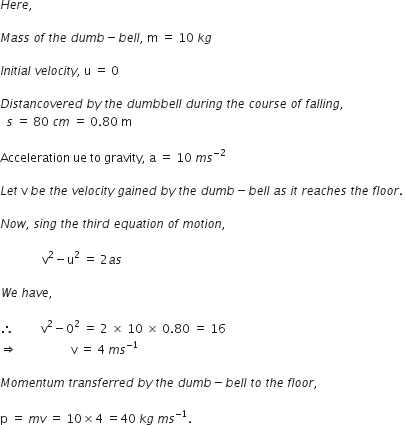
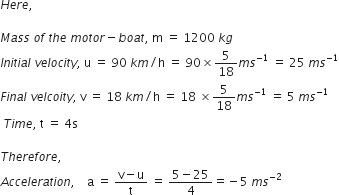
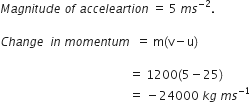
![<pre>uncaught exception: <b>Http Error #404</b><br /><br />in file: /home/config_admin/public/felixventures.in/public/application/css/plugins/tiny_mce_wiris/integration/lib/com/wiris/plugin/impl/HttpImpl.class.php line 61<br />#0 [internal function]: com_wiris_plugin_impl_HttpImpl_0(Object(com_wiris_plugin_impl_HttpImpl), NULL, 'http://www.wiri...', 'Http Error #404')
#1 /home/config_admin/public/felixventures.in/public/application/css/plugins/tiny_mce_wiris/integration/lib/php/Boot.class.php(769): call_user_func_array('com_wiris_plugi...', Array)
#2 [internal function]: _hx_lambda->execute('Http Error #404')
#3 /home/config_admin/public/felixventures.in/public/application/css/plugins/tiny_mce_wiris/integration/lib/haxe/Http.class.php(532): call_user_func_array(Array, Array)
#4 [internal function]: haxe_Http_5(true, Object(com_wiris_plugin_impl_HttpImpl), Object(com_wiris_plugin_impl_HttpImpl), Array, Object(haxe_io_BytesOutput), true, 'Http Error #404')
#5 /home/config_admin/public/felixventures.in/public/application/css/plugins/tiny_mce_wiris/integration/lib/php/Boot.class.php(769): call_user_func_array('haxe_Http_5', Array)
#6 [internal function]: _hx_lambda->execute('Http Error #404')
#7 /home/config_admin/public/felixventures.in/public/application/css/plugins/tiny_mce_wiris/integration/lib/com/wiris/plugin/impl/HttpImpl.class.php(27): call_user_func_array(Array, Array)
#8 /home/config_admin/public/felixventures.in/public/application/css/plugins/tiny_mce_wiris/integration/lib/haxe/Http.class.php(444): com_wiris_plugin_impl_HttpImpl->onError('Http Error #404')
#9 /home/config_admin/public/felixventures.in/public/application/css/plugins/tiny_mce_wiris/integration/lib/haxe/Http.class.php(458): haxe_Http->customRequest(true, Object(haxe_io_BytesOutput), NULL, NULL)
#10 /home/config_admin/public/felixventures.in/public/application/css/plugins/tiny_mce_wiris/integration/lib/com/wiris/plugin/impl/HttpImpl.class.php(40): haxe_Http->request(true)
#11 /home/config_admin/public/felixventures.in/public/application/css/plugins/tiny_mce_wiris/integration/lib/com/wiris/plugin/impl/TextServiceImpl.class.php(80): com_wiris_plugin_impl_HttpImpl->request(true)
#12 /home/config_admin/public/felixventures.in/public/application/css/plugins/tiny_mce_wiris/integration/service.php(19): com_wiris_plugin_impl_TextServiceImpl->service('mathml2accessib...', Array)
#13 {main}</pre>](/application/zrc/images/qvar/SCEN9015066-9.png)
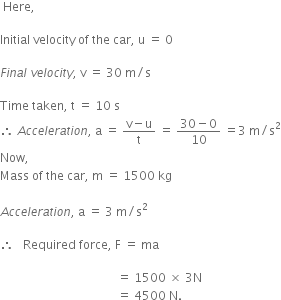
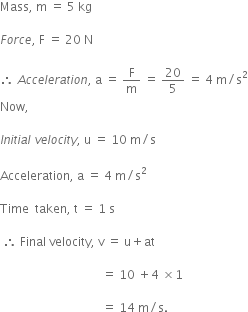
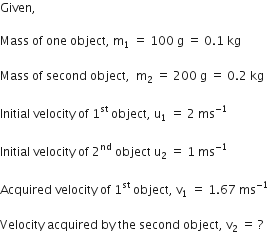

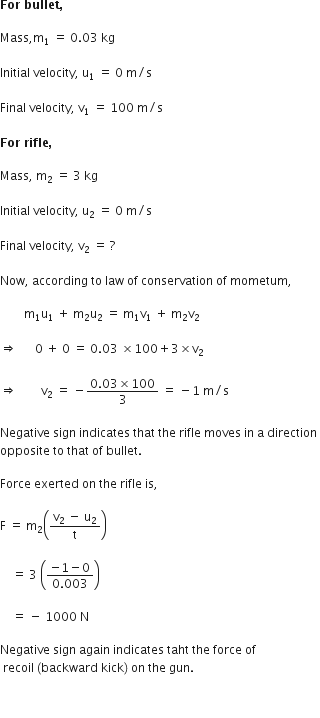


![<pre>uncaught exception: <b>Http Error #404</b><br /><br />in file: /home/config_admin/public/felixventures.in/public/application/css/plugins/tiny_mce_wiris/integration/lib/com/wiris/plugin/impl/HttpImpl.class.php line 61<br />#0 [internal function]: com_wiris_plugin_impl_HttpImpl_0(Object(com_wiris_plugin_impl_HttpImpl), NULL, 'http://www.wiri...', 'Http Error #404')
#1 /home/config_admin/public/felixventures.in/public/application/css/plugins/tiny_mce_wiris/integration/lib/php/Boot.class.php(769): call_user_func_array('com_wiris_plugi...', Array)
#2 [internal function]: _hx_lambda->execute('Http Error #404')
#3 /home/config_admin/public/felixventures.in/public/application/css/plugins/tiny_mce_wiris/integration/lib/haxe/Http.class.php(532): call_user_func_array(Array, Array)
#4 [internal function]: haxe_Http_5(true, Object(com_wiris_plugin_impl_HttpImpl), Object(com_wiris_plugin_impl_HttpImpl), Array, Object(haxe_io_BytesOutput), true, 'Http Error #404')
#5 /home/config_admin/public/felixventures.in/public/application/css/plugins/tiny_mce_wiris/integration/lib/php/Boot.class.php(769): call_user_func_array('haxe_Http_5', Array)
#6 [internal function]: _hx_lambda->execute('Http Error #404')
#7 /home/config_admin/public/felixventures.in/public/application/css/plugins/tiny_mce_wiris/integration/lib/com/wiris/plugin/impl/HttpImpl.class.php(27): call_user_func_array(Array, Array)
#8 /home/config_admin/public/felixventures.in/public/application/css/plugins/tiny_mce_wiris/integration/lib/haxe/Http.class.php(444): com_wiris_plugin_impl_HttpImpl->onError('Http Error #404')
#9 /home/config_admin/public/felixventures.in/public/application/css/plugins/tiny_mce_wiris/integration/lib/haxe/Http.class.php(458): haxe_Http->customRequest(true, Object(haxe_io_BytesOutput), NULL, NULL)
#10 /home/config_admin/public/felixventures.in/public/application/css/plugins/tiny_mce_wiris/integration/lib/com/wiris/plugin/impl/HttpImpl.class.php(40): haxe_Http->request(true)
#11 /home/config_admin/public/felixventures.in/public/application/css/plugins/tiny_mce_wiris/integration/lib/com/wiris/plugin/impl/TextServiceImpl.class.php(80): com_wiris_plugin_impl_HttpImpl->request(true)
#12 /home/config_admin/public/felixventures.in/public/application/css/plugins/tiny_mce_wiris/integration/service.php(19): com_wiris_plugin_impl_TextServiceImpl->service('mathml2accessib...', Array)
#13 {main}</pre>](/application/zrc/images/qvar/SCEN9016056-3.png)
